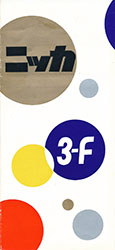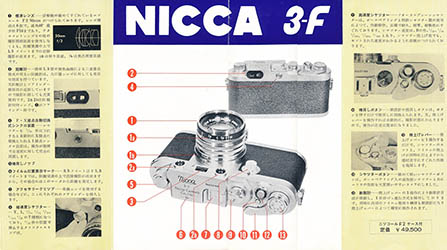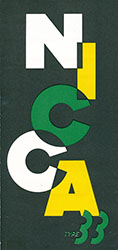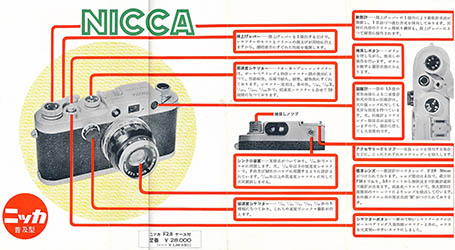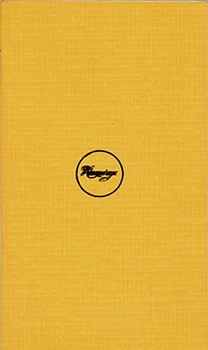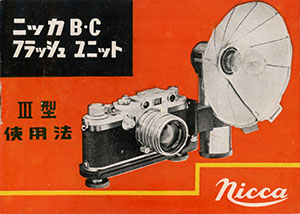Nicca
Leotax rival & Yashica ancestor
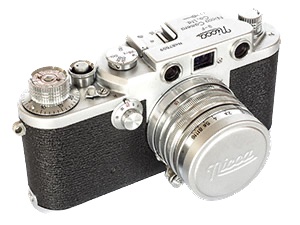
Contents
(Scroll down or click on Links)
The Beginning - 1935 to 1948
The Nicca Era - 1948 to 1958
Nicca and Hinomaruya Addresses
Not Every Nippon is Real - Checking for Fakes
Made in Occupied Japan & Other Markings
Changeover from Stamped to Die-cast Bodies
Film Loading Flaps
Flash Sync
From Nippon to Nicca - Models, Features & Specs
Nippon
Nicca Original
Nicca Type-3
Nicca Type-III A & Type-III BType-III S
Nicca Type-4 & 3-S
Nicca Type-5
Nicca 3-F & 3-F (lever)
Nicca 5-L (aka the 3rd 3-F model)
Nicca Type 33
Nicca III-L
Catalogues & Names
Sugiyama Gets it Wrong Too
The Models
Tower Models & Serial Numbers Table
Tower Type-3 Flash Sockets
Sears Supplied Lenses
K.O.L./Sun Xebec Lenses
Nicca Lenses
Nikkor Lenses
Shutter Speeds
Rangefinder
Nicca Accessories
Lens Caps
Ever-ready Cases
Lens Hoods
Filters
Reloadable Film Cassettes
Nicca and Other FindersNicca Universal Finder
Variable Framing Type
Other Finders
Nippon Kogaku Varifocal and Sports Finder Alternatives
Tower Lens Caps
Tower Ever-ready Cases
Tower Lens Hoods/Filters
Finders Offered by Sears
Tower Flash
From Nicca to You - Boxes
Useful Links
Contact Details
The Nicca Story - 1935 to 1958
Sources for this story and the subsequent model histories include Peter Dechert, Koichi Sugiyama, Mikio Awano (both in collaboration with Sugiyama and in referenced Camera Collectors' News articles), McKeown's Price Guide to Antique & Classic Cameras, Massimo Bertacchi (Innovative Cameras) and my own research and observations using the tools I have described elsewhere on the site. Peter Dechert's “Contax Connection” published August 1, 1990, available as a web archive, traces the Japanese 35 mm camera from Canon through Nicca to Yashica to Contax. Peter was the author of “Canon Rangefinder Cameras 1933-68” among other books, Shutterbug columnist, professional photographer and recognised authority on photographic equipment. Note, “Contax Connection” is well researched but he is not immune from idle speculation and some “fuzziness” with detail and some of it misses the mark, e.g., because of the “Nicca” name on front of the YF, he is convinced that the YF was a ready to go Nicca update of the III-L and Yashica simply assembled it from already produced parts - I think all the evidence says otherwise.
In regard to model details and specs, I have relied most heavily on Mikio Awano. It is noteworthy that Peter Dechert has acknowledged him as a significant source for his Canon book. Mikio Awano has used period advertising to support his claims and his information pretty closely matches the cameras in my database. Our main difference is that he sees the early model changes as hard cut-offs for features whereas my having access to many examples via the Internet clearly indicates that some features were introduced mid-model and even significant changes often involved a short transition period. One model we do disagree about is the 5-L, that is explained at the relevant point.
The Beginning - 1935 to 1948
In 1935, Genji Kumagai, the inspiration behind the Nippon/Nicca camera, started work at camera maker Seiki Kōgaku Kenkyūjo which was later to become Canon. Some stories say that he left in the late 1930s as work turned increasingly to military contracts, however, according to Japanese author Hayato Ueyama (“Canon Vol.1 All About Seiki Kogaku” and a contributor to Dechert's Canon book) Kumagai was in charge of Seiki Kogaku's advertising and was sacked when the military complained and banned a photo. The details are not clear from the machine translation but it may have had something to do with Seiki Kogaku's new enlarger in mid-1937. Kumagai then started a Leica repair and modification shop, e.g. adding rangefinders to models without them. In 1940, at the behest of Canon distributor, Omiya Shashin Yohin (Omiya Photo Supply), he and seven other former employees of Seiki Kōgaku Kenkyūjo founded Kōgaku Seiki-sha (Optics & Precision Co.), the future Nicca, as an official Canon repair agency in a workshop in a building owned by the Canon distributor. Peter Dechert names assembler-engineers Tachikawa and Karasawa and another person, Araki, who became foreman and later, a director. An ad in the June 1941 Asahi Camera magazine says that the company can install slow speed shutter dials in older Canons without them, presumably the Hansa Canon (Peter Dechert). The similarity in the original company names of Canon and Nicca is almost certainly no coincidence.
Due to difficulties of supply from Germany because of the war in Europe, in 1941 Kōgaku Seiki-sha was given a military order to develop a Japanese Leica copy. The first example was delivered in 1942. Although outwardly a faithful Leica III copy, the rangefinder magnification was 1x instead of the Leica III's 1.5x. It was initially patriotically named “Nippon” with the maker name engraved as “Kogaku Seiki”. Later, in early 1948, the company would adopt the camera name for itself to briefly become Nippon Camera Works, Ltd.
Although both innovation and the reality of economics would eventually erode faithfulness to some extent, all of Nicca's future cameras would be Leica copies, typically bottom loading and with separate viewfinder and rangefinder viewing windows except on the final model (and also a version of the first model which was without rangefinder and slow speeds, e.g. for scientific work). The bodies themselves are well regarded as Leica copies and seemed to reach a high standard right from the beginning.
Only small numbers of the Nippons were built during the War and post-War, from serial numbers, perhaps between 800 to 1,000 in total. The original lens was a K.O.L. Xebec f/2 5 cm collapsible type which under a restructured lens company was rebranded Sun Xebec in 1945.
Immediately below is the special version without rangefinder and slow speeds fitted with the original K.O.L. Xebec lens. Its serial number is 1810010 (from 1943) - the photo is from Japanese magazine, Camera Collectors' News, but the same camera is featured by Peter Dechert (different photo). Below that is 1948 camera 23001 with the Sun version of the lens:
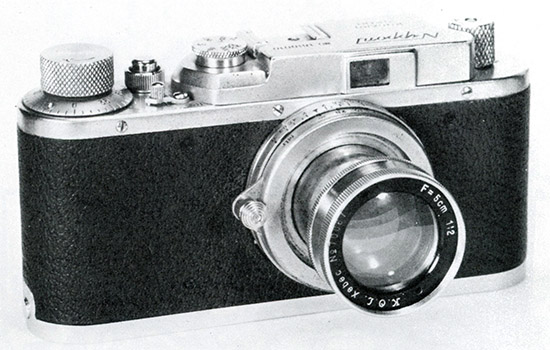
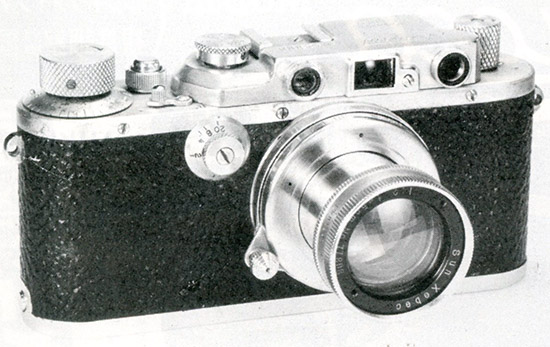
(Both images from Mikio Awano's article in Camera Collectors' News, July 1978)
The Nicca Era - 1948 to 1958
The camera name was changed to “Nicca” (likely from “Nippon” and “Camera”) earlier in 1948, with the company soon changing its own name to Nicca Camera Works Ltd. before the end of 1948 (confirmed by camera serial numbers and engravings). According to Camera-wiki.org, Genji Kumagai left at about the same time to become an independent camera designer and evidence suggests that he was later associated with several other Leica copies in the 1950s. In 1951, the company became Nicca Camera Company, Ltd.
Apart from a Nicca branded f/3.5 5 cm collapsible Elmar copy (rare but eight in my database, see Nicca Lenses), the Nicca branded f/2.8 50mm lens on the late 33 model and the Snider version Schneider-Kreuznach exception noted further below, Nikkor 5 cm lenses were now fitted as standard (typically f/2 with f/1.4 available as an option and on earlier models, f/3.5 too) and also the range of Nikkor wide angle and telephoto lenses were offered as accessories, making the cameras very attractive options.
Sources, including Camera-wiki.org, claim that Hinomaruya was Nicca's domestic Japanese distributor from 1951 to 1958 and also the distributor of Nikkor LTM lenses for the same period, however an ad further down the page for the “Nicca Type III” (Type-3) already appeared in Asahi Camera magazine in September 1950 with a prominent “Hinomaruya” in Japanese. Given lead times, the arrangement must have commenced at least a month or two earlier than that. The earliest Hinomaruya ad that I have seen featuring specific reference to Nikkor lenses is from August 1951 and as there was no mention in an earlier April ad, the year is probably correct.
Little is known about Hinomaruya. It is claimed to have already been advertising in early 1946 and was an authorised dealer of Masmy cameras in 1951 (Camera-wiki.org). Later it was also the distributor of Melcon cameras which, like Nicca, were supplied with Nikkor lenses. The Nippon Kōgaku Nikkors had arrived on the World stage in 1950 and were being compared to Leitz lenses so the full range being offered by Nicca was certainly attention grabbing, although probably also costly for the company. Nicca's accessories range was more extensive than that of direct competitors such as Leotax, however, Hinomaruya is directly associated with many of the Nicca accessories, and with copy stands, both Nicca and Nippon Kōgaku versions. I think it is fair to say that Hinomaruya helped make Nicca look like a more well rounded camera company than it probably really was.
Versions of various Nicca models were branded for their importers. The first was the 1949 Nicca Type 3 engraved “Peerless Type-3” on the viewfinder cover and “Made for Peerless Photo Supply by Nicca Camera Works” on the base plate (two examples in my database with photos plus a third serial number from Camera-wiki.org and a fourth from Christie's camera auctions - for photos see also Massimo Bertacchi's “Innovative Cameras” site):
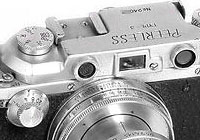 (Detail from larger web image)
(Detail from larger web image)
According to Pacific Rim Camera, the cameras for New York based Peerless were a small batch, all supplied with f/2 5 cm Sun Sophia lenses. My experience is the same as Pacific Rim, four serial numbers found, all within 100 cameras of each other (within 60 in my case) and the two with lenses still, featuring the Sun Sophias.
The arrangement probably ended before, or with, the Sears partnership. US department store and mail order chain, Sears, Roebuck & Co. sold Nicca and many other makers' cameras rebranded as “Tower” (most Nicca models from 1950 onward, even in 1959 under Yashica's ownership and finally, the Yashica YF under its own name). The marketing power of Sears through its Tower brand and its catalogues meant easy access to the lucrative US market and important cash flow and growth opportunities for the small company.
Unique to Australia is the later re-branded Nicca Type-5 based “Snider” (engraved “Snider35”). According to the 12th edition of McKeown's, 90 were ordered by Gardner and Salmon Pty. Ltd. of Sydney with less than 60 sold and 3 still known to exist. Unusually, the Snider was supplied with a German Schneider-Kreuznach Xenon F/2 lens in place of the Nikkor choices. The two Sniders I have seen photos of feature the lens and retailer Senes & Co. Pty. Ltd ad in the October 1956 edition of Australian magazine, Popular Photography, proudly states “Lens by Schneider & Co.”, whilst incongruently displaying the photo of a Nicca with Nikkor lens from the Nicca Type-5 user manual. Detail from actual Snider 35 on right:
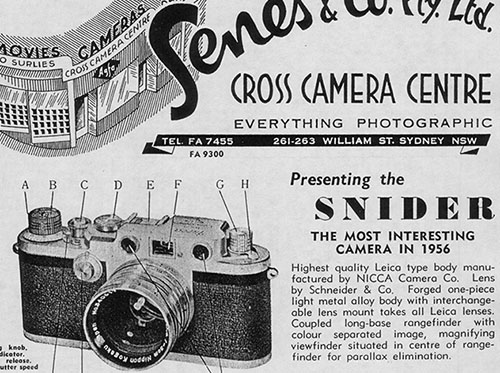
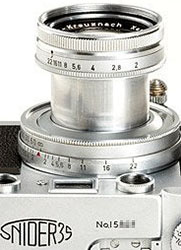
(Detail from larger web images)
However, by the second half of the decade, with a difficult shrinking market created by the Leica M3, the expansion of Canon into all price segments of the market and then the rise of the Japanese SLR, Nicca found itself in financial difficulties and was acquired just before the impending bankruptcy by Yashima (Yashica) in 1958, probably May. It became the wholly owned subsidiary, Taiho Optical Co., which was fully absorbed into Yashica 8 years later in 1966. Whilst there is a pair of rare M42 35 mm and 135 mm f/2.8 preset lenses bearing the names of both “Nicca” and “Taiho Optical Co” which were offered as accessory lenses for the Yashica based Wards SLR 500 and 600 cameras (Montgomery Ward 1965 Spring Summer Catalog), this was most likely a rebranding exercise and there is no known product of Taiho Optical Co. Yashica also used the “Nicca” name for a version of one of its later movie cameras (see Yashica the Company - Success & Failure).
Note: “Nicca” branded microscopes were marketed by Aikatsu Co., Inc., Tokyo, as may have been “Nicca” binoculars. There is no known connection to either Nicca or Yashica.
Nicca and Hinomaruya Addresses
According to Camera-wiki.org, in 1943 Kōgaku Seiki-sha (Nicca) was located at Tokyo-to, Honjo-ku, Higashi-Ryogoku 3-10. As a relatively small scale maker, the company had been comparatively mobile location wise with a move late in the War and again in 1946 and 1947. The Nicca Type-III user manual, circa 1949, has the Nippon Camera Co., Ltd now located at 1-1232 Denenchofu, Ota-ku, Tokyo whilst the Type 3S/Type-4 manual has the address as 1-1263 Denenchofu, Ota-ku, Tokyo, seemingly a short way down the street. The pair of 3-F manuals clarify the two Ota-ku addresses as 1-1232 being the plant and 1-1263 the headquarters (the HQ site may be a slightly later addition).
Camera-wiki.org lists distributor Hinomaruya's address from 1946 to 1953 as 1-2358 Araijuku, Otaku, Tokyo and in 1954 as Tokyo-to Chiyoda-ku, Kanda-awaji-cho. 1955 and later documents show the address as 4-3 Nihonbashi Muromachi, Chuo-ku, Tokyo which is not far from Yashica's head office at the time at 1-8 Nihonbashi Muromachi Chuo-ku, Tokyo, the address that started appearing on some Nicca III-L documents.
Models & Serial Numbers
According to Peter Dechert, there was a small batch of Nippon prototypes and in the “Contax Connection” there is a picture of No. 19. I have since found recent photos of No. 20 which seems to match it in every critical way. Production cameras are said to use the first two digits on the left for the Japanese Showa year. There are several production cameras in my database with serial numbers beginning with “18”, or Showa 18 which is equivalent to 1943 (add 25 to the Showa number). Peter Dechert thinks that 7 digit serial number 1810010 is camera number 10. Next follow two 6 digit number before the system settles into 5 digit numbers, still beginning with “18” before going onto “19” and “20” prefixes. As not many were made, the lack of digits didn't become an issue until the Nicca era.
Although the “Nicca Original” examples in my database start with a 5 digit serial number beginning with “23”, equating to 1948, they are problematic, see notes below the table. As expected, the first “Nicca Type-3” cameras also start with a 5 digit serial number beginning with “23” and reach 2399x, i.e. they were in danger of running out. So early “24” numbers may be Showa 24, i.e. 1949, or they may be from near the end of 1948. Whenever the tipping point occurred, rather than adding a digit, the Showa link was dropped and the numbers just increased sequentially and more or less carried on from model to model until the new body was introduced after which each model had its own discrete series. Serial Numbers found (note, does not include Tower models or serial numbers, see comments below table):
Model |
Engraved Name |
Serial Numbers |
Showa |
Release Year |
|
From |
To |
||||
| Nippon (prototypes) | Nippon | 19 | 28 | - |
1942 |
| Nippon | Nippon | 1810010 | 18 |
1943 |
|
| Nippon | Nippon | 18106x | 18112x | 18 |
1943 |
| Nippon | Nippon | 1953x | 1955x | 19 |
1944 |
| Nippon | Nippon | 2081x | 20 |
1945 |
|
| Nippon | Nippon | 23001 | 23 |
1948 |
|
| Nicca (original) | Nicca | 2307x | 2327x | 23 |
1948 |
| Nicca Type-3 | Nicca Type-3 | 2302x | 2765x | 23 |
1948 |
| Nicca Type-III A | Nicca | 2825x | 4518x | - |
1951 |
| Nicca Type-III B | Nicca | 317xx | 4008x | - |
1951 |
| Nicca Type-III S | Nicca Type-III S | 50002 | 6014x | - |
1952 |
| Nicca Type-4 | Nicca Type-4 | 80007 | 8119x | - |
1953 |
| Nicca 3-S | Nicca 3-S | 5888x | 7323x | - |
1954 |
| Nicca Type-5 | Nicca Type-5 | 125001 | 13153x | - |
1955 |
| Nicca 3-F | Nicca 3-F | 85002 | 9692x | - |
1956 |
| Nicca 3-F (lever) | Nicca 3-F | 151000 | 15761x | - |
1957 |
| Nicca 5L with 3-F markings | Nicca 3-F | 16180x | 16208x | - |
1957 |
| Nicca 5L | Nicca 5L | 16204x | - |
1957 |
|
| Nicca 3-F (lever) oddity | Nicca 3-F | 18288x | - |
1957 |
|
| Nicca Type 33 | Nicca | 15236x | 16072x | - |
1958 |
| Nicca III-L | Nicca | 18106x | 18420x | - |
1958 |
In a couple of cases, I have used low numbers found on cameras in brochures and user manuals - these are likely to be pre-production cameras but in each case, the numbers are consistent with following cameras found in the wild. There are seven “Nicca Original” examples in my database with similar serial numbers to each other and also to the first Type-3 examples. Understanding them is complex and not clear cut, see Nicca Original, but in the table, I have only included the serial number range of the four most likely to be the real deal. Tower serial numbers are included in the Tower Models narrative and Tower Models & Serial Numbers Table further below. The two found Peerless Type-3 cameras have serial numbers 2403x and 2405x and Camera-wiki.org makes reference to 24001 and Christie's camera auctions to 24039 all of which fit in the middle of the Nicca Type-3 numbers. On the other hand, the two Nicca Type-5 based Sniders in my database have their own serial numbers, 1550x and 1551x. I have put the Type-4 earlier than the 3-S based on Japanese authority, Mikio Awano - the logic is explained here. There is only one 5L marked camera found but just before that are five cameras with serial numbers only up to 60 cameras less which are in every way a 5L but three are engraved “3-F” and one has a metallic label marked “5L” stuck over the engraved model name. There is now a sixth one with serial number 40 higher than the 5-L. The 3-F (lever) oddity has an unusually high serial number, 18288x, which is what sets it apart from other examples found so far.
Working out likely production from serial numbers is not a simple matter. Whilst there are no obvious patterns and they appear to be consecutive, there are also unexplained gaps in the numbers. Nikkor lens numbers don't assist because different aperture serial numbers use separate ranges of numbers and they weren't exclusive to Nicca, however, the unique Nicca f/2.8 lens fitted to all Type 33s does illustrate the problem. By body serial numbers (i.e., highest serial number minus lowest serial number), the apparent Type 33 production may be thought to be 8,353. By lens serial numbers, the production appears to be 2,785 which I think is fairly close. Massimo Bertacchi (Innovative Cameras) estimates the number at 1,000. I don't know on what basis or source, he may be correct, but I suspect that is too low - I can find examples on the Japanese auction sites fairly regularly and they are not priced for rarity.
Model Names
People sometimes ponder, “there was the Nicca and the Nicca Type-3, what happened to the Type-2?” Some may argue that the Nippon was the first, the original Nicca the second and therefore the Type-3 makes sense. However, let me also note that whilst there was also the Type-4 and Type-5, there was another eight models with “3” in the name somewhere (plus a 9th if you count the lever wind 3-F as a separate name). And four of them were in the form of “III” (plus the Type-3 was advertised as the “Mod III” in the ad further down the page) you know, somewhat like as in Leica III, to which all of them owed their inspiration and to a lesser or greater extent, their design, features and appearance.
The earlier Nicca models were largely Leica III copies and the Nicca Type-4 was a pretty straight Leica IIIa clone except for the added flash sync. The Nicca Type-5 and 5-L variants took the die-cast Leica IIIf and added some Leica M3 features. Then Nicca released the more budget friendly 3-F that really did look just like a Leica IIIf, except for the missing 1/1,000 top speed and dioptre adjustment. 3-F, IIIf, pretty obvious really.
Without knowing the full story, it seems that around 2/3rds of Nicca's names were paying homage to the Leica originals in some way.
Note: With model names, my preferred format is what is engraved on the cameras. Not all models have engraved names but with those without, I follow the format of similar vintage engraved names (which is the opposite of what worked for me with Yashica TLRs). Names in manuals, ads and brochures often use different formats with dashes (hyphens) in different places etc. They are rarely consistent and there is little that doesn't rely on machine translation. In that context, e.g., I use “Type-3” as engraved instead of the “Type III” found in advertising. On the other hand, Mikio Awano notes the difference but uses, e.g., “Type III” as advertised. Other sites vary. I doubt that there is an official Nicca style guide so there is unlikely to be a right or wrong usage.
Not Every Nippon is Real - Checking for Fakes
In conjunction with features described below, the serial numbers are extremely useful in deciding whether what you are seeing is the real thing or not. On the Yashica YE & YF page, I have described Massimo Bertacchi's “Innovative Cameras” as one of the best Nicca resources currently available, however, not necessarily the most accurate. In fact, I have doubts about several of his displayed models. The Nippon serial number beginning with “25” rings alarm bells straight away, that would make it 1950, if it is a Showa number and is strange because he explains how the Showa prefixed serial numbers work for the following “Nicca Original”. The camera has a rectangular viewfinder window with one curved corner - I have only seen that on two other Nippon/Nicca examples. I thought that I had seen a fourth one but that has turned out to be a fake of a possible fake - more below.
I have some concerns about his Nicca Original too, not the least being that it has a dioptre adjustment when Massimo Bertacchi himself says, “without dioptre adjustment on viewfinder and eyepiece”. It also has a later accessory shoe and a serial number that looks too cramped and uneven to me. More on that in Nicca Original.
Sometimes these are misidentification errors but with very rare cameras come high prices and temptations for fraudulent misrepresentation by forgers. The source/s of Massimo Bertacchi's photos is/are unknown. I'm certainly not suggesting that he is in anyway responsible or even aware of the issues. With the displayed, Nippon, the serial number is certainly a fundamental problem. Massimo Bertacchi's photo of the Nippon has also been “borrowed” by several other sites (or vice versa) thus spreading the idea that it is a legitimate example.
The two other examples of the Nippon with curved viewfinder corner have a much more plausible serial number beginning with “22” which would make it 1947. What's more, one of them appears in the authoritative McKeown's guide. However, as we shall see further below, McKeown's has already been very badly caught out by one very obvious fake. All three cameras look identical and obviously fall into the same category of either dubious and probably fakes from the same source, or real with an unknown serial number series for one of them, certainly not Showa based like previous and following cameras.
A cut and dry forgery case is the Nippon offered for sale in 2016 by a well known European auction house complete with an improbable “Seiki Lausar” lens (“Seiki” likely implying Kogaku Seiki, “Lausar” being a Tomioka brand name for its Tessar type lenses - there is no known connection between the two) and “For. Oc-ciro” engraving on the top plate. The body is clearly of Soviet Union origin, probably a 1940's FED, and also likely the lens too. It sold for €4,400, link here, getting close to US$5,000 at 2016 exchange rates. The auction house was perhaps an unwitting player, but for one of the doyens of the camera world, there is an even more embarrassing post script to this story - see near the end of this section.
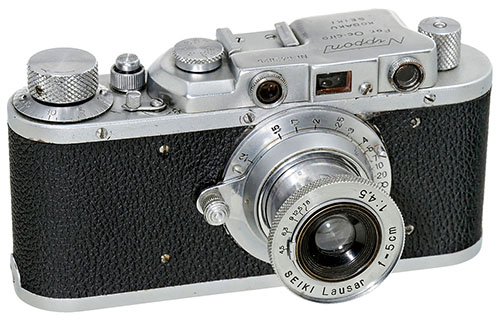 Soviet Nippon
Soviet Nippon
The most obvious issue is the missing slow speed dial. Soviet cameras are often used as the basis of fake versions of much more expensive Leicas and their copies. Most Soviet cameras don't have slow speeds (a little known version that does is far too rare and valuable to repurpose) and neither does this one. The scientific Nippon without rangefinder also doesn't have slow speeds either but all with rangefinder do.
All the Nippons to at least 1945, whether with rangefinder or not, have a rectangular front viewfinder window with four square corners. Except for some early and rare and hence expensive examples themselves, Soviet cameras also have squared off rectangular viewfinder windows but the top edge of the frame is level with the top of the viewfinder housing whereas on the Nippons, the top edge of the frame is below the top, i.e. there is a lip. The Soviet viewfinder, unique as far as I am aware on stamped body Leica (pre-IIIc) copies, is always its greatest give away, as it is with the camera in question. If the lens was removed, no doubt that the fixed pointy focus follower would be visible instead of the roller used on Leicas and other copies.
Also, the 6 digit serial number beginning with “64” shows a careless lack of understanding of the Nicca numbering system. All the Nippons I have seen photos of have the film rewind release marked “R” and clearly visible, on this camera it is a “B” and partly covered by the viewfinder housing, another typical feature of some Soviet models. The first Nippons didn't feature strap lugs but 1944 camera 1955x does already. None of the Soviet copies do. The four screws in the leatherette around the lens are chrome on Soviet copies, black on Leicas and other Leica copies.
For reference purposes, these are the various viewfinder windows. First is the rectangular window surround found on War-time Nippons, including those without rangefinder. Second is a notched Nicca Type-3 representing all early body type Niccas/Towers and the last of the Nippons. Third is the Nippon from Massimo Bertacchi's website with one curved corner representing three found examples. Some Leica, Leotax and Chiyotax models have notched surrounds like the Type-3, some have the curved corner except the glass area on this seems larger and wider than its Japanese cousins. Maybe Kogaku Seiki experimented too but of course, the serial number of one example remains a very big problem. Certainly not a Russian viewfinder housing but even Leica parts have been used when the dollars make it worthwhile. Fourth is one of my three FEDs, same as the auction item. The Zorki viewfinder housing is the same too but Zorkis are trickier to pass off as something else because of external body reinforcing/borders on the more available/affordable bodies.

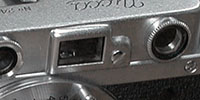
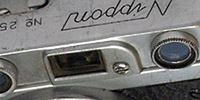

(Images 1 and 2 are details from larger web images, image 3 is detail from Massimo Bertacchi's website)
Left is the auction camera rewind release, middle is one of my matching FEDs, right is a Tower Type-3 release, same as Nippon.


(Left detail from larger web image, right detail courtesy of Chris Whelan)
There is a post script to the stories of the fakes. I stumbled onto a forum post on USSRPhoto.com where the owner of the site, Vladislav Kern, was discussing the auction referred to above and posted the following image from the 12th edition of McKeown's:
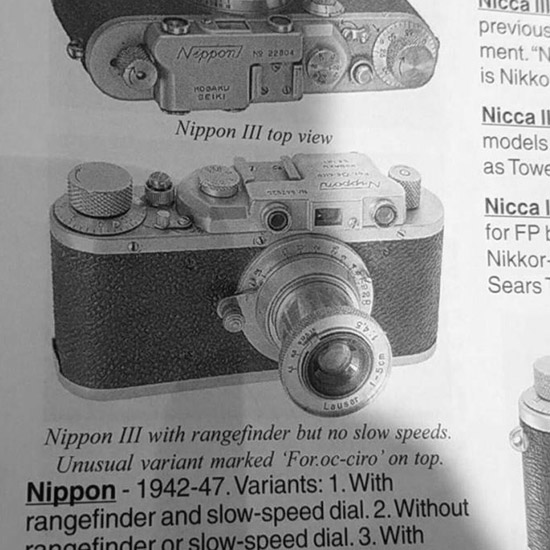
Lo and behold, it appears to be the fake Nippon from the auction. The serial numbers match as does the unusual “For. Oc-ciro” engraving on the top plate. However, in McKeown's the lens name is “Lausar”, still highly improbable, whereas at the time of auction, it had been extended to “Seiki Lausar”. This edition of McKeown's was published in 2004 and the auction was in 2016. So even the experts do get caught out.
But that is not the end. The Nippon above this one also caught my eye. This has the unusual viewfinder window with one curved corner, one of the three found so far and discussed further above. Whilst the serial number of this one, 22804, and another of the three, 22802, suggest 1947 and are in the ballpark, Massimo Bertacchi's 25172 is out of range and I think that real doubts remain about the three of them. But it is certainly not cut and dry, see Nippon.
And now I have discovered another oddity:
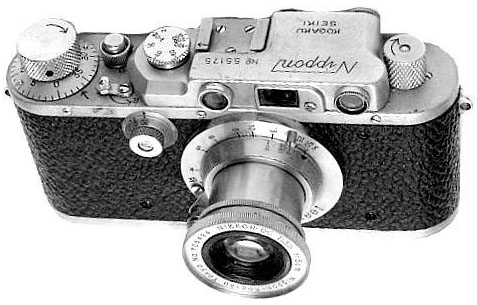
This is a faked photo (actual size found) of Massimo Bertacchi's camera, 25172. Note the photo is identical except that it has been crudely cut from its background, it has been inverted (compared to his website) and the serial number has been changed to 55175 (first and last digits changed). Below is a slightly larger version of the top plate of the same photo (looks photocopied) found elsewhere on the web with Massimo Bertacchi's camera below that and McKeown's example below that for comparison:
 Fake 55175
Fake 55175
 Massimo Bertacchi's 25172
Massimo Bertacchi's 25172
 McKeown's 22804
McKeown's 22804
I have bigger versions of the top two of the three images. Clearly, they are the same camera - all the visible screw slots point in the same directions and the same marks on the top plate to the left of the slow speed shutter dial and down from the rewind knob are present in both. Clearly, they are also the same photo - as well as the markings and screw slots, all the knobs are in exactly the same position and the perspective, highlights and shadows are the same. Just the serial numbers are different. Why?
And finally, just to demonstrate how interchangeable parts are on the earlier stamped body Leicas and copies, one of the forum members in the USSRPhoto.com discussions about the fake auction Nicca posted a photo of his FED-Nicca Type-3:
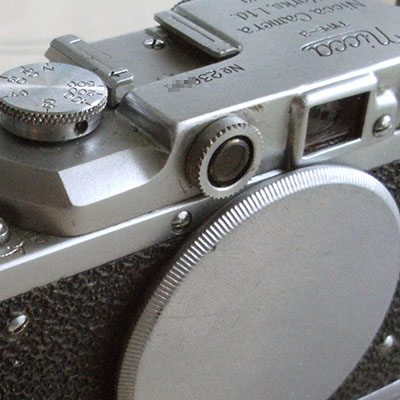 (Detail from larger web image)
(Detail from larger web image)
The lack of slow speeds, chrome screws in the leatherette, the obscured “B” on the top plate and the flat profile of the rangefinder window ring confirm the body's Soviet origins but with the Leica notch window, the viewfinder/rangefinder housing appears to be a genuine Nicca Type-3 item.
Made in Occupied Japan & Other Markings
The Supreme Commander for the Allied Powers in Japan issued an instruction on 20 February 1947 requiring all export products to be marked “Made in Occupied Japan” (MIOJ). With General MacArthur handing power over to the Japanese government, the requirement to use the MIOJ marking was repealed on 5 December 1949. However, the occupation only ended with the San Francisco Peace Treaty signed on 8 September 1951 and taking effect on 28 April 1952. Some camera makers continued to use the MIOJ marking until 1951, including Nicca (the changeover to “Made in Japan” started after the Type-III A and Type-III B releases in 1951) but not e.g., Canon.
Whereas all the cameras from the period appear to be compliant, I am yet to see the marking on a lens for a Nicca. Standard 50 mm lenses generally appear to have been exempt because they were sold with the camera and accessory lenses may have had the MIOJ marking elsewhere, e.g. in Canon's case, on the rear lens caps and cases. I have not been tracking Nikkor accessory lenses but they were likely offered on Niccas only after the decree was repealed. During the MIOJ period, Nikkor lenses used “Tokyo” on the beauty ring - see Nikkor Standard Lenses.
The first Nicca cameras the engraving is visible on in my database are two Nicca Originals and the earliest Type-3 from 1948 (earlier photos rarely show anything other than front views). These three were engraved on the base plate itself:
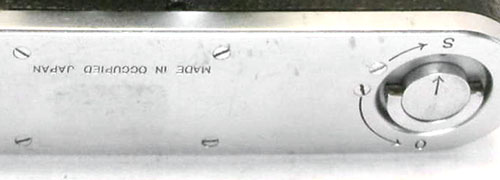 (Detail from larger web image)
(Detail from larger web image)
The subsequent cameras were engraved on the base plate locking ring, as in the first image below. If the ring is flipped over, as it is in quite a few photographs, the engraving is not visible. This was a feature until 1951 camera Type-III A, serial number 3502x, which is the last with it in my database and also the first Nicca with the maker name engraved “Nicca Camera Company, Ltd.” From thence until Type-III S number 5613x and some Type-4s (mixed but probably 50%), the engraving on the locking ring was “Made in Japan” (image 2). After that, until the end of the early body models (Nicca 3-S), “Japan” was engraved on the base plate instead with a new “open” and “close” dialogue replacing the single characters (image 3). A similar style variation with the text inverted appeared on all die-cast body types (image 4):
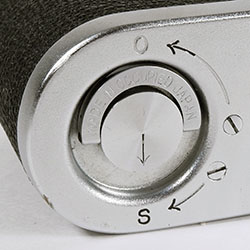
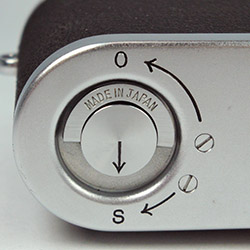
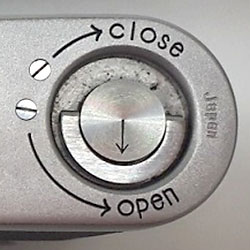
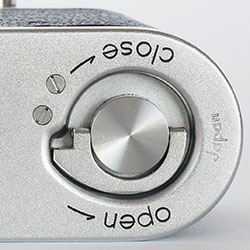
(Images 1 and 2 courtesy of Chris Whelan, image 3 detail from larger web image)
Cameras sold to occupation forces, typically through US military Exchange stores, were not subject to the very high taxes applied to post-War domestic Japanese consumption and in order to control those sales, starting in, some say, 1948 or 1949 but perhaps 1947 based on found Minolta 35 examples, the cameras (and other goods including porcelain) destined for the Exchange stores (and possibly other duty free outlets) were marked with a diamond and inside that, either the letters <CPO> standing for Central Purchasing Office (an office within General MacArthur's Allied occupation forces), or their Japanese katakana equivalent <シーピーオー>. I haven't yet found any Nicca examples with the <CPO> mark in English, only the katakana version. Found Canon and Minolta 35 examples clearly indicate that the English version predates the katakana. The practice seems to have only lasted until the end of 1949. Note, the Exchange stores are typically Army Post Exchange (PX), Navy Exchange (NEX), Air Force Base Exchange (BX) and Marine Corps Exchange (MCX) but I don't know whether all were represented in Japan at the time.
After the end of the Allied occupation on 28 April 1952, probably in 1953, the <EP> mark was introduced for the same purpose as the earlier <CPO> mark. For more detailed information, see <CPO> and <EP> on the Canon page.
Below left is an early Nicca Type-3 marked “Made in Occupied Japan” with the katakana version of the <CPO> mark on the locking knob. Unusually, “Japan” is also engraved on the base plate - I'm not sure what is going on, the opening/closing dialogue is correct but the “Japan” is both superfluous and from later, no other camera has both. In the middle is a Type-3 with the katakana <CPO> mark more typically located in the middle of the base plate. This arrived within 32 cameras of the first type. On the right is a Nicca 3-S with the later placement of the <EP> mark on top of the rewind knob but on two earlier Type-III A examples, it is on the film winding knob, the change no doubt due to the film type reminder added to the 3-S (an early example of the Type-III A still features the CPO mark of the middle example below):
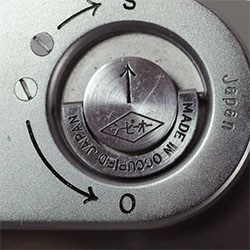
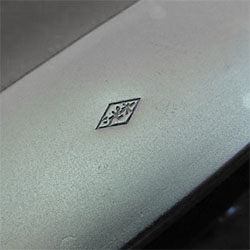
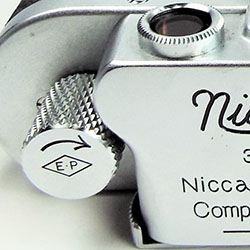
(Image 1 is detail from larger web image, image 2 is detail from Massimo Bertacchi's website where it is somewhat confusingly described as “a rare Japanese Military marking”, although his Minolta 35 page does provide a detailed and correct explanation, and image 3 is courtesy of Chris Whelan)
Changeover from Stamped to Die-cast Bodies
The Nippon and the first Nicca models up to and including the Type-4 and 3-S were based on the earlier, smaller bodied Leica II/III with the III's front mounted slow speed shutter dial. Like the earlier Leicas, the bodies were assembled from stamped parts. Later models starting with the 1955 Type-5 were based on the slightly larger die-cast Leica IIIc-IIIg body, probably inspired by the popular IIIf (basically pre-War IIIc with flash sync added, released in 1950). The new Nicca bodies also added the ball bearing to the shutter introduced by the War-time Leica IIIc (principally to operate more reliably in low temperatures) and also moved the viewfinder and rangefinder windows next to each other as on the Leica IIIc-IIIg and first implemented on the 1938 Leica IIIb. Like with the Leica models, the dioptre adjustment moved from the rangefinder window to under the rewind knob.
Last of the early stamped bodies, the Nicca 3-S with separate viewfinder housing:
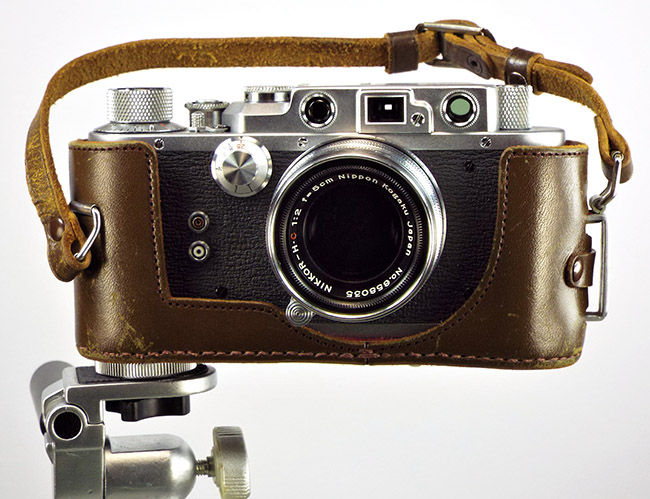
(Image courtesy of Chris Whelan)
Below is the first of the late die-cast bodies, the Nicca Type-5 with one piece top plate. The Leica-like top plate extensions down the sides of the lens mount makes removal of the shutter cage easier without requiring lifting of the leatherette. Also featured on the new body was the slow speed shutter dial lock introduced by Leica on its die-cast bodies. Both the extensions and lock were removed on the Nicca Type 33 and III-L:
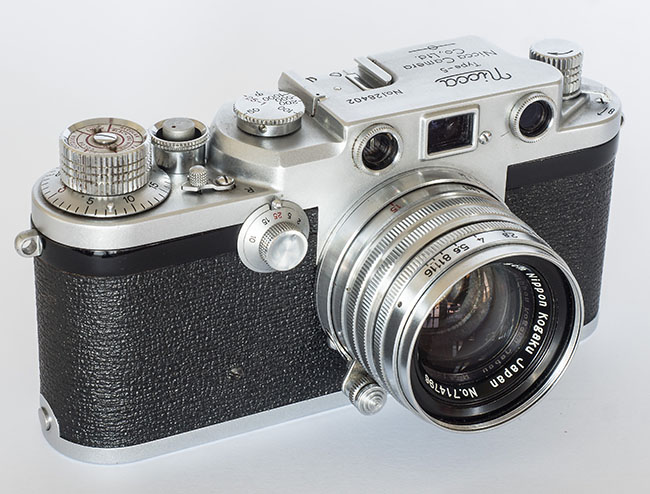
Except for the trapdoor on the back of the Type-5 to aid with film loading, the Type-5 and subsequent knob wind 3-F are the same size. Below is a size comparison between the Nicca 3-F (on left) and early bodied 3-S (on right).

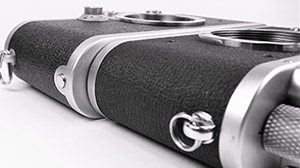 (Images courtesy of Chris Whelan)
(Images courtesy of Chris Whelan)
The 3-F was released in both knob wind and lever wind forms, the latter with higher shoulders like also the following 5-L and Type 33. With the lever wind, the shutter button moved to the front of the top plate and the rewind release lever moved from the front of the top plate to a button behind the shutter button. Presumably, the lever wind models share common dimensions and in that regard, the overall height of the lever wind 3-F/Type 33 based Yashica YE is about 2mm more than the knob wind 3-F with, surprisingly, the base plate seeing an approximate 1 mm increase and the rest is at the top of the rangefinder/viewfinder housing:

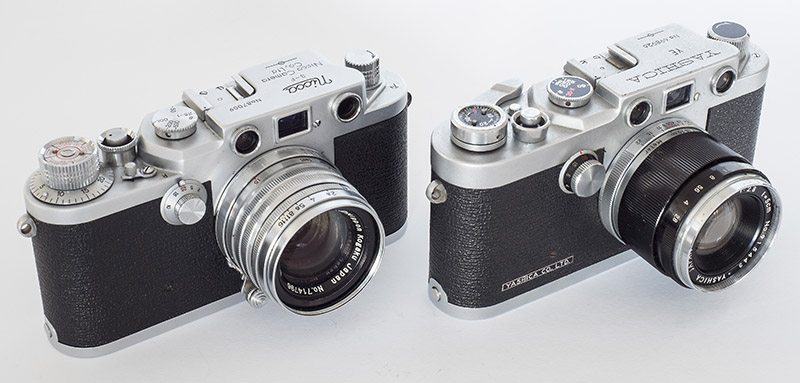
The top image particularly shows the deeper base plate of the Yashica and the extra millimetre (or a fraction less) above the viewfinder.
The following table summarises the approximate dimensions (to the nearest millimetre) and weights of early body and late body examples of select Leica and Nicca models (they are an indicator only):
| Dimension | Leica II/III |
Leica IIIc/f |
Nicca III S |
Nicca 4/3-S |
Nicca 3F |
Yashica YE |
|---|---|---|---|---|---|---|
Base Plate Length |
133mm |
135mm |
133mm |
133mm |
139mm |
139mm |
Camera Height |
67mm |
69mm |
67mm |
68mm |
71mm |
73mm |
Base Plate Width |
30mm |
30mm |
30mm |
31mm |
31mm |
|
Weight (grams) |
406 |
425/430 |
437 |
431 |
448 |
472 |
Note: The lens mount, slow speed shutter dial, viewfinder bezels and lever wind all make the body deeper than the base plate width. Reported Leica dimensions vary all over the place, e.g. the height of the Leica II/III varies from 65 to 67 mm, the height of the Leica IIIc/f from 65 mm to 68 mm. The otherwise excellent LeicaWiki is just as inconsistent. The weight shown for the Leica II/III is for a Leica II without slow speeds, so not really a fair comparison to the Nicca Type-III S. The Leica IIIc dimensions and weight are as measured and weighed by me and the Leica IIIf by correspondent Terry Byford. According to Mikio Awano, the Nicca Type-4 and 3-S rangefinder was improved and as a result, the viewfinder housing increased in height by about 1 mm (Camera Collectors' News 1978, September). The Type-4/3-S weight is for the 3-S as measured by contributor Chris Whelan. For the sake of completeness, the Nicca Type-5, with a cast trapdoor in its back, weighs 463gm. That's 15gm more than the otherwise similar 3-F so a 5-L might weigh approximately 15gm more than the YE, i.e., about 487gm. The protruding door adds almost 3 mm to the body's overall depth.
Film Loading Flaps
In several places on this page I refer to the “Leica M3 inspired” rear flaps to help with film loading, sideways hinged on the Nicca Type-5 and top hinged on the 5-L (and other named variants) and III-L. Whilst that origin seems self-evident, what is little known is that Leica itself contemplated both variations some 20 years previously. Pictured on a website page (about halfway down) featuring Leica prototypes is a Leica II based test camera with sideways opening flap from around 1934. Below are two stills from a video for Wetzlar Auction 5 featuring a 1934 prototype of the die-cast Leica IIIc (released in 1940) complete with top hinged rear flap (apart from the flap and the platform under the rewind release lever which was there on War-time examples, the obvious differences from the production IIIc are the screw still in the centre of the slow speed shutter dial and the rounded platform under the rewind knob instead of triangular):
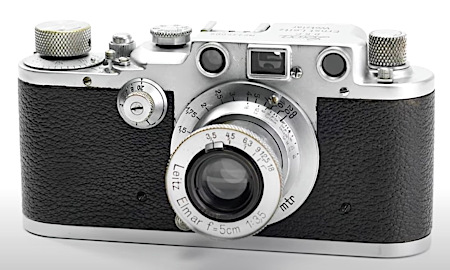
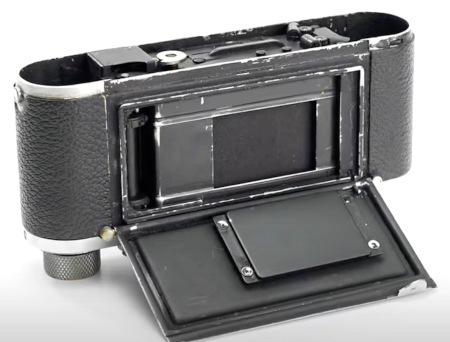
There is no evidence to suggest that Nicca designers were aware of these internal Leica mullings over design.
Flash Sync
Flash Sync Early Bodies
The first flash synchronised body, the 1951 Nicca Type-III B, featured twin posts for a non-standard type of flash connection (possibly 2 post ASA/Wollensak), the sync being FP according to Mikio Awano, Sugiyama and Japanese Wikipedia (the two posts do the work of one coaxial socket).
Subsequent early bodies featured a pair of coaxial PC terminals on the front (top - FP sync, red and bottom - X sync, white), positioned vertically below the slow speed shutter dial, offset towards the side. On the shutter cover plate of later 3-S examples (also last two Type-III A, which lack sync, and two late Type-4 examples), the terminals are described as “High” for the Red terminal and “Slow” and “Strobe” for the White terminal.
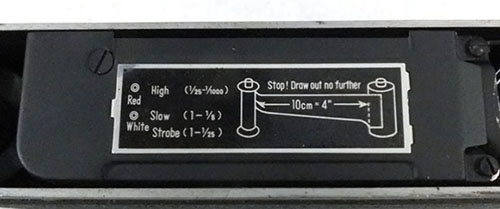 (Detail from larger image)
(Detail from larger image)
“High” is for shutter speeds 1/25 to 1/500, or 1/1000 for the Type-4, but “1/1000” is indicated on all plates, even on two late unsync'd Type-III A cameras. Maybe not ideal, but it's obviously more economical to make one type of plate rather than three. In accordance with the user manual, FP flashbulbs must be used. Both the label and user manual suggest that flashbulbs can only be used at the “Slow” speeds of 1 to 1/8 when using the white terminal (flashbulbs must either be FP or “open” type) but “Strobe” can be used from from 1 to 1/25.
Shown below, first Type-III B sync posts, first Tower Type 3 coaxial sockets (from the same time as the Nicca sync posts, see Tower Type-3 Flash Sockets below, almost certainly installed in the USA), typical FP/X PC sockets and typical FP/X PC sockets with labelling found on Tower Type-3S (Nicca Type-III S based), Tower 42 and/or 43 (Nicca 3-S based) and some Nicca Type-4 examples, about 50% (the Nicca 3-S on the cover of the combined 3-S/Type-4 user manual also features the labelling but is the only one I have seen):
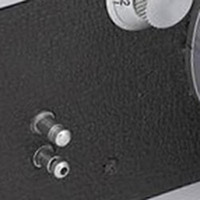

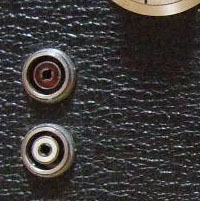
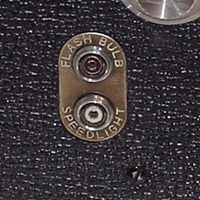
(Details from larger web images)
The sync posts were lower and more towards the side than the later PC sockets, the early Tower type even more so.
Flash Sync Late Bodies
The flash sync on the die-cast bodies is now a single PC socket on the back of the one piece top plate and except for the Type 33, sync type switches automatically (confirmed by user manuals and brochures), depending on speed selected. On the Type-5 (left), the socket is offset to the right in-line with the edge of the shoe, on all others, it is centred under the shoe (3-F shown).
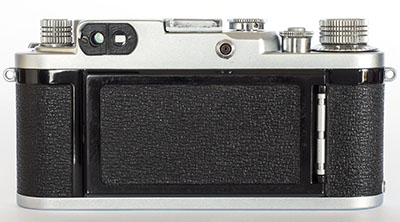
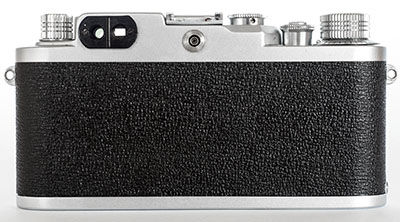
Note, because there is only one socket, some sites claim that the late bodies only feature X sync. The highly regarded by many HPR, Hans P. Rajner, in his book, “Leica Copies”, shares the misconception and has perhaps helped popularise it.
Also except for the Type 33, see further below, X sync is at the the changeover speed for the high speeds, anything above that selects FP sync and any type of flash can be used below the changeover speed. The changeover speed for the earlier die-cast bodies was 1/25 and for the Type 33 and III-L, 1/30, with the Type 33 offering X sync at 1/60, but not FP sync above 1/30.
Again except for the Type 33, the baseplate of die-cast models features an adhesive label with film loading and flash synchronisation information. The label indicates that flash bulbs can be used at any shutter speed from 1 second to 1/500, or 1/1,000 for models so equipped. However, in accordance with user manual instructions, above 1/25, or 1/30 on the III-L, flash bulbs must be of the FP type. Unlike the restrictions with earlier twin socket models, “any types of flash bulbs” may be at used at speeds “slower than” 1/25, or 1/30 as relevant. Electronic flash can be used from 1 second to, and including, 1/25 or 1/30.
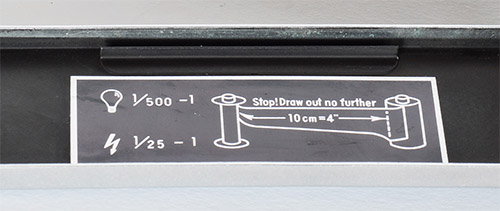
From Nippon to Nicca - Models, Features & Specs
All models, except the Nippon without rangefinder, feature slow speeds with a separate slow speed dial on the front with a full range of shutter speeds from T & 1 to 1/500 (no T and from 1/2 on the Type 33) or T & 1 to 1/1,000 on the Type-4, Type-5, 5-L and III-L. Stamped bodies and the Type 33 and III-L do not have a slow speed shutter dial lock, the other die-cast bodies do. All the nuances are covered in Shutter Speeds.
Nippon
Nippon cameras were engraved “Nippon” with the maker name “Kogaku Seiki”.
The original lens was a K.O.L. Xebec f/2 5 cm collapsible type which was rebranded Sun Xebec in 1945 (see K.O.L./Sun Xebec Lenses). The LTM version of the Canon mount Nikkor f/3.5 seems to have become available from Nikon in 1946 (see Nikkor Lenses) but may not have been offered on the Nippon until it became the Nicca in 1948 (Nippons as early as 1944 have been found with them but these are unlikely to be original fitments).
The initial prototype series is believed to have 2, or up to 2, digit serial numbers. Found numbers in my database include 19, 20 and 28. Below left is the special version without rangefinder and slow speeds fitted with the original K.O.L. Xebec lens that was featured earlier. Its serial number is 1810010, the leading “18” believed to indicate the Showa era for 1943 and “10” the 10th camera of the production series. Below right is a 1944 example of the standard model with lens replaced by a later Nikkor f/3.5 5 cm collapsible type:


(Left image from Mikio Awano's article in Camera Collectors' News, July 1978, right detail from larger web image)
At some point, probably in 1947, the Nippon front viewfinder frame changed from the original rectangular with square corners to the more Leica-ish notched shape typical of the early body Niccas. And/or, to rectangular with one curved corner (also Leica-ish) - I have discussed the rectangular with one curved corner at length in Not Every Nippon is Real - Checking for Fakes (complete with examples). My concern is that one of the three known examples of the curved corner type has a higher serial number than expected but otherwise, they look like Nippon bodies, which isn't saying much because I can't tell them apart from the Leica III. So three examples, two with seemingly plausible serial numbers.
McKeown's curved corner example, 22804, made a cameo appearance in the fakes section. Here is another scan showing it more completely plus with front view and Soviet Nippon below. The reference to “Nippon III” is not something I have seen commonly, although Massimo Bertacchi refers to a “Nippon 3” so maybe that is something HPR and/or Pont and Princelle have called it? Certainly not the the Japanese sources. McKeown also describes the Soviet FED based fake as “Nippon III with rangefinder but no slow speeds” (no such version is known to exist). The Nikkor lens is from later, more below.
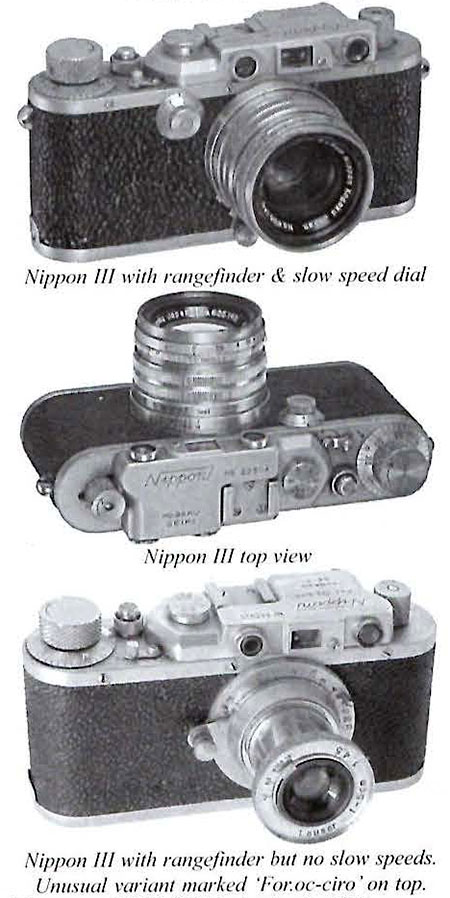
(McKeown's 12th edition, page 719. Scan courtesy of Tom Heckhaus)
I am aware of only two examples of a Nippon with the notched window. One appears in Sugiyama's book credited to Mikio Awano and the other is from Mikio Awano's article and is displayed further below. In fact, I think that they are the same camera - the photos are slightly different but the screws all point in the same direction as does the text on the lens beauty rings. Nevertheless, I am convinced that it is real as it matches the Nicca Original and the only change was supposed to be the name.
Sugiyama splits his two separate Nippon entries between War-time and post-War. In regard to the post-War version, he says that it is “almost” the same as the War-time version and gives the date of introduction as 1947. Neither he nor Mikio Awano mention any other version nor make specific reference to the viewfinder window. Was there one window change, or two? (I find two really hard to believe, by all accounts, Kogaku Seiki was really struggling to survive and made very small numbers of cameras in this period. A tooling change would have been a big thing, two changes in a short period would have been extravagant. Plus, both notched and curved windows are copies of 1930's Leica styles. On the Leica, the notched came first with the Leica II and early IIIa and changed to curved corner on the late IIIa and IIIb - the Nippon change would have been back to front.)
These are the Nippon cameras and lenses that came after the original ones with rectangular viewfinder window frames:
| Body Serial No. |
Showa Year |
Window Frame |
Lens | Aperture |
|---|---|---|---|---|
| 22802 | 1947 |
Curved |
Sun Sophia | f/2 |
| 22804 | 1947 |
Curved |
Nikkor | f/2 |
| 23001 | 1948 |
Notched |
Sun Xebec | f/2 |
| 25172 | 1950 |
Curved |
Nikkor | f/3.5 |
The serial
number of the last, 25172, is clearly not Showa based like the earlier Nippons and following Originals. The Nikkor lens might be OK but I suspect that maybe it should still be a Sun. The Sun Sophia on the first camera, 22802, is a later lens than the Sun Xebec, possibly first appearing in 1948. They are not known to feature on Nippons or Niccas but two of the found Peerless cameras from early 1949 are fitted with them and according to Pacific Rim Camera, they were the standard fitment for that version (not found on the corresponding Nicca Type 3 examples - all found with Nikkors). The Rigid Nikkor on camera 22804 is clearly a replacement from 1950 or later. So, perhaps the only camera with original lens is the notched window example.
So far I have presented the possibilities and problems without a clear conclusion. Based on serial numbers, I'm going to stick my neck out and say that I think that the notched window camera is real and the curved corner cameras are all fakes. From 1943 to 1945 when all the cameras still look like the original Nippon, the serial numbers seem to count up from 1 to 813 (camera number 20813, the 20 being the Showa era). Then come our three curved corner cameras, one with a number that doesn't fit and the two others, 22802 and 22804, i.e. Showa 22 (1947) with camera count 802 and 804. What are those numbers counting when camera 813 was reached in 1945? Extremely unlikely to be counting that many made in 1947, it has been suggested that only a “few dozen” were made in the post-War period. On the other hand, the camera with notch, 23001, seems to be the first one for 1948 and thus representing a change in the numbering system. The number is in step with the first confirmed Nicca Original in my database which is numbered 23078, just 78 cameras later. They appear identical, the only difference between the two are the engravings which fits with Peter Dechert's claim referred to in Nicca Original below.
This is the 1948 Nippon 23001 with the notched window and the rebranded Sun Xebec f/2 5 cm collapsible lens:

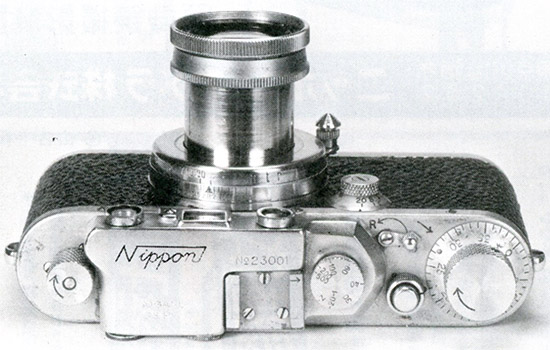
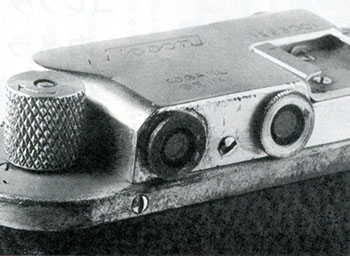 (Photos from Mikio Awano's article in Camera Collectors' News, August 1978 - the maker name is there in the middle photo, just very faint but clearer in the original magazine photo)
(Photos from Mikio Awano's article in Camera Collectors' News, August 1978 - the maker name is there in the middle photo, just very faint but clearer in the original magazine photo)
Nicca Original
According to Peter Dechert, the original Nicca is the same as the last iterations of the preceding Nippon model. Whereas Nippon cameras were engraved with the maker name “Kogaku Seiki”, the first Niccas were engraved with “Nippon Camera Works, Ltd. Tokyo”.
Visually, the original Nicca and various permutations of “3”/“III” models differed only in small refinements and details like flash sync. Nevertheless, their nomenclature and relationships are confusing. Top plates are engraved “Nicca”, “Nicca Type-3”, “Nicca Type-III S” and finally, “Nicca 3-S”. The “Nicca” engraved examples can be split into three models; the first is the Nicca Original, called that by collectors (April 1948 according to Mikio Awano, 1948 according to Peter Dechert, 1947 according to Japanese Wikipedia - as there is still a 1948 Nippon, 1948 sounds more likely). The other two “Nicca” engraved models come after the next model, the Type-3.
Peter Dechert and Sugiyama both tell us that the Original is the only early bodied “Nicca” named model without dioptre adjustment (the lever around the rangefinder viewing window described as “Eyebrow Rest” in user manuals) and the fitting of that is the feature change that defines the following first Nicca Type-3 examples, otherwise they outwardly appear identical (there were a couple of internal changes, see Type-3 below).
Note the lack of dioptre adjustment in the third image:
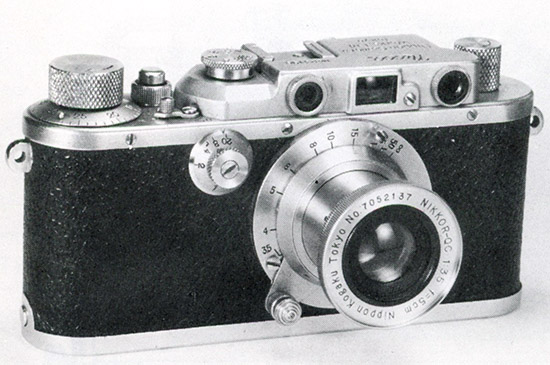
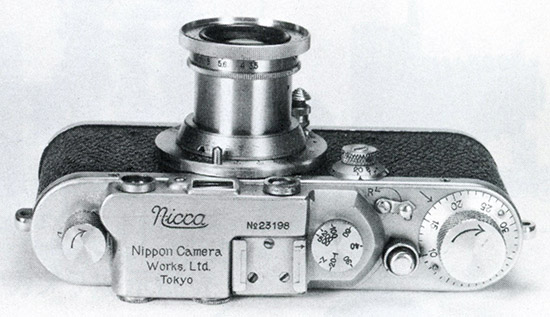
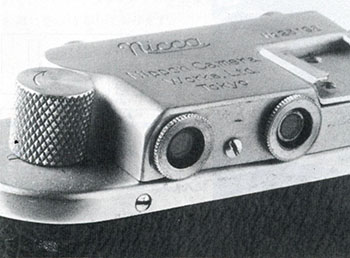 (Photos from Mikio Awano's article in Camera Collectors' News, August 1978)
(Photos from Mikio Awano's article in Camera Collectors' News, August 1978)
Peter also claims that the “Nicca Original” is very rare. I concur but I'm not sure what I am looking at. The serial numbers of the seven Nicca Originals in my database range from 2302x to 2387x, the first six with “Nippon Camera Works, Ltd. Tokyo” maker name, the last one with “Nicca Camera Works, Ltd. Tokyo” which might be OK but I am doubtful about the camera itself (see below). According to the serial numbers, all are from 1948. However, the first two Type-3 serial numbers seem to parallel the Nicca Originals' range with 2302x to 2303x and match the Originals' first maker name. In fact, the first eight Type-3s have serial numbers in the same range as the examples that claim to be “Nicca Original”s.
It is possible that there are earlier “Nicca Original” examples which I haven't found and are more clearly an earlier camera meaning that those in my database represent a crossover period of one model to the next - only the first of the Originals in my database has a lower number than the earliest Type-3 and that is only by one camera and the camera itself seems like a fake (dioptre adjustment and other later features)! What it looks like at the moment is that the Nicca Original was released and the Type-3 with a few improvements was launched almost at the same time and they continued for a little while as separate models.
More concerning is that some features on some of the Originals are questionable. Some items like dials may have been changed by owners over time but only four of them are without dioptre adjustment (2nd, 3rd, 4th and 6th cameras). Two of them, one from Massimo Bertacchi's site with dioptre adjustment, have accessory shoes with four screws, a feature that didn't come to Type-3 cameras until later in production (cameras with serial numbers starting with “24”). At least one of them doesn't have the plugged focus adjustment hole that was there from the beginning and according to Mikio Awano, is still there on the Originals. By definition, the four without dioptre adjustment are probably the real deal, these are also the only Originals in my database with the central screw in the slow speed shutter dial still. Their serial numbers are 2307x, 2319x, 2322x and 2327x.
Nicca Type-3
This early ad says “Nicca Mod III”, but the body is engraved “Nicca Type-3”. Featured lens is the Nikkor f/3.5 but the collapsible f/2 is offered too:
.jpg) (Click on ad for larger version)
(Click on ad for larger version)
The ad is from Mikio Awano's article in the August 1978 edition of Japanese magazine, Camera Collectors' News. I can only make out “1948 April” in the description under the ad.
Type-3 pictured with the Nikkor f/1.5 lens and advertised as the “Nicca Type III”, as most found ads do:
.jpg) (Click on ad for larger version)
(Click on ad for larger version)
This ad is from Mikio Awano's article in the following September 1978 edition of Camera Collectors' News. The magazine's text at the bottom translates as “Nicca III, 1950 September, Asahi Camera”, i.e. it is from late in the model's life. The large Japanese text near the bottom of the ad translates as “Hinomaruya”. The top line of the three lines above it says “Nicca domestic distributor”. As noted further above, that makes Hinomaruya's confirmed arrival in 1950 earlier than the 1951 suggested by some other sources. The reference to “Sakura Film” in the bottom left corner is interesting. “Sakura” is the brand name for photographic film produced by Konishiroku, the modern day Konica. Presumably Hinomaruya was taking the opportunity to promote its other interests.
As well as the addition of the dioptre adjustment, there were two other initial changes which were internal. According to Mikio Awano (Camera Collectors' News, September 1978), both the Nippon and Original feature a rangefinder with the Leica II standard of 1x magnification but the Type-3 increases the magnification to the Leica III standard of 1.5x thus also increasing the effective rangefinder base and accuracy. He also claims that the Type-3 introduced click stops to the slow shutter speed dial, apparently the earlier models didn't have them.
Nicca Type-3 with collapsible Nikkor f/2 5 cm lens, note the dioptre adjustment around the rangefinder eyepiece:
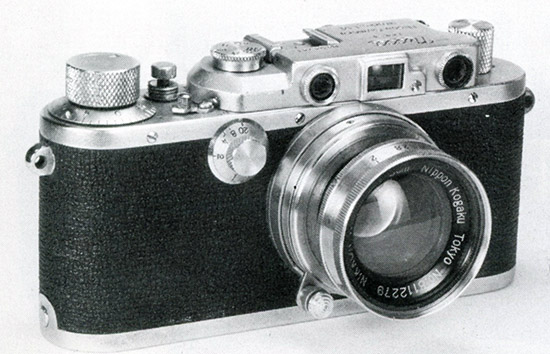
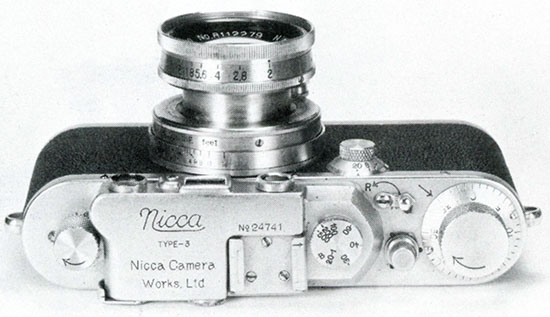
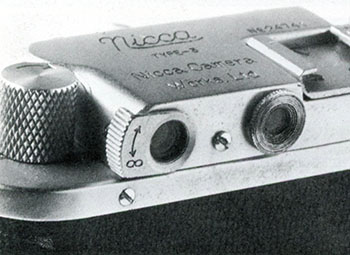 (Photos from Mikio Awano's article in Camera Collectors' News, August 1978)
(Photos from Mikio Awano's article in Camera Collectors' News, August 1978)
The earliest example, 2302x, still has the central screw in the slow speed shutter dial (the dial is not visible on the next camera). Both it and the next example, 2307x, still have the plugged focus adjustment holes in the backs of the cameras. Both feature the earlier maker name engraving “Nippon Camera Works, Ltd. Tokyo”. After those two cameras, the serial numbers jump to 2343x and both the slow speed shutter dial screw and focus adjustment hole disappear and the maker name briefly becomes “Nicca Camera Works, Ltd. Tokyo”.
Nicca Type-3 2375x shortens the maker name to “Nicca Camera Works, Ltd.” but cameras 2375x, four cameras later, and 2382x briefly revert. Then come 2393x to 2399x with the new name followed by serial numbers beginning with “24”, suggesting 1949 in terms of Showa era but as explained in Serial Numbers, with numbers running out, these could be from either the end of 1948, or start of 1949, but the Showa naming convention was effectively at an end.
At some point, probably earlier on in the Type-3's life, the larger 3/8" tripod mount favoured by Leica was replaced with the more common 1/4" type - adaptor bushes were and are available (note the top camera has “Made in Occupied Japan” engraved on the base plate, this moved to the locking ring near the beginning - see previous section):

 (Details from larger web images)
(Details from larger web images)
The top base plate also features four fixing screws for the front and rear locating channels to prevent the camera body flexing. Nippon prototype No. 20 had no channels but they appeared by the Originals. The screws are still there on some Originals and early Type-3s but then there are some with rivets replacing the screws, still visible from outside as above, but the last of the riveted types disguise the fact completely even though they are still there as evidenced from inside:

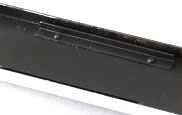
(Details from larger web images)
Late Nicca Type-3, early Nicca Type-III A and early Tower Type-3 cameras received the baseplate type below with the front and rear supports in the form of a single wide channel piece without obvious physical fasteners. This effectively gave the bottom a double thickness.
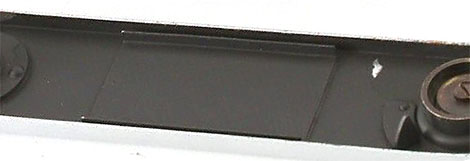 (Detail from larger web image)
(Detail from larger web image)
The short shutter collar that seems to have remained the same since the prototype Nippons was replaced with a taller mushroom type but it's hard to say when, there is a mix of earlier and later cameras (photo below this features the earlier collar):
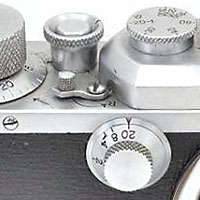 (Detail from larger web image)
(Detail from larger web image)
The “20-1” marking on the main shutter speed dial, “20” on the slow speed dial and the “0” on the frame counter dial changed to red from serial number 2498x onward (the red appears to overlay black on earlier cameras and can wear off):
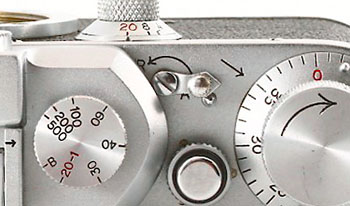 (Detail from larger web image)
(Detail from larger web image)
The first 2/3 of the Type-3s in my database still have 3 screws in their plain accessory shoe but around camera 2498x, the shoes changed to the 4 screw type with a pair of pressure springs (there is one earlier camera by itself, 2404x):
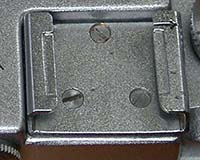
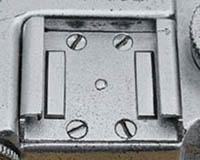 (Details from larger web images)
(Details from larger web images)
Note, the new shoes appear to have been individually modified to fit the tight radius of the viewfinder/rangefinder housing - quite a few early ones are square across the top/front, some have a 45 degree bevelled left front corner and then the standard seems to have been a shallow curve, although some bevelled ones still continue to appear.
As noted earlier, the last of the Nippons introduced the notched viewfinder window on the left found on all early Niccas. The last three Nicca Type-3 in my database (2763x, 2763x and 2765x) feature a revised notch with less acute angle (Type-III S pictured) which carried through to the end of the early body model:
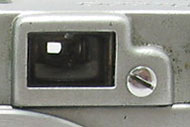
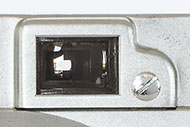 (Left detail from larger web image)
(Left detail from larger web image)
The early left type window type still features on the two first Tower Type-3 examples (Sears version of the Nicca Type-III A) in my database (serial numbers of these first two are slightly less than the last Nicca Type-3), but all subsequent examples are the new type. So, as with the earlier feature changes, whilst the changeover clearly occurred near/at the model changeover, there was a transition as parts were used up rather than a hard cut-off.
Nicca Type-III A & Type-III B
Following the “Nicca Type-3”, the two other models with only “Nicca” engraved as the model identifier were released. In most respects, they were identical to each other except that one was advertised as the Nicca Type-III A without flash sync and the other as the Nicca Type-III B with flash sync added for the first time (according to both Mikio Awano and Japanese Wikipedia, released in April and June 1951 respectively). They are also still very similar to the late Type-3 cameras. Both seem to use the same serial number range. Correspondent Mark Cunningham's Type-III A, with early type maker name engraving, which belonged to his father-in-law and was bought from another U.S. Army member:
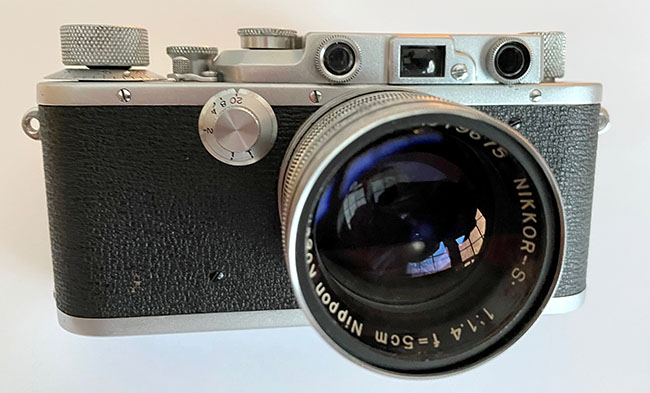
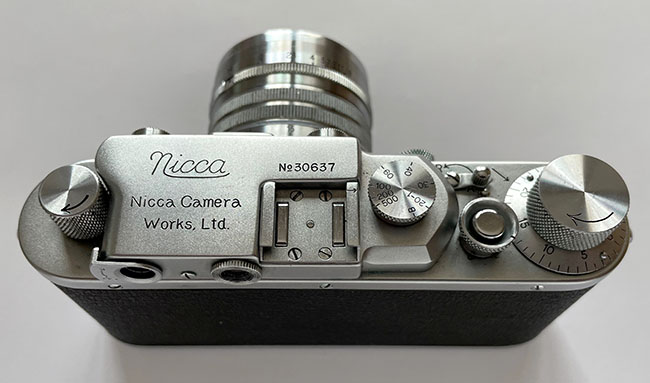
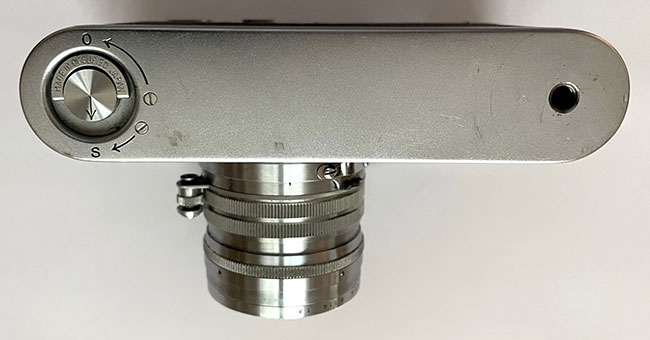
(Images courtesy of Mark Cunningham)
Note the “Made in Occupied Japan” on the baseplate locking ring, this changed to “Made in Japan” at about the same time that the maker name engraving changed and the film plane mark was introduced (see below). The Nikkor f/1.4 lens has the early “Tokyo” marking matching the MIOJ body (explanation and lens featured in Nikkor Lenses).
Below is a Type-III B with its signature sync posts (note, the camera features a non-standard oversize shutter button and mushroom collar):
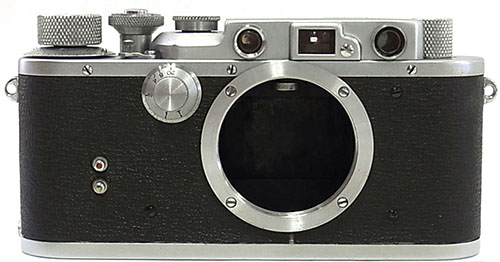 (Detail from larger web image)
(Detail from larger web image)
Type-III A ad below left. The heading on the ad below right translates as “Nicca Camera” and immediately below as “Nikkor Lens”. Near the bottom is “Hinomaruya” in both Roman and large Japanese text, similar to the left ad. The camera is a Type-III B with the first type sync posts but as far as I can make out, the model and specs are not mentioned - this looks like a Hinomaruya marketing exercise about its brands:
(Click on ads for larger versions)
These ads are from Mikio Awano's article in the September 1978 edition of Japanese magazine, Camera Collectors' News. The magazine's text at the bottom translates as “Nicca III A, 1951 April, Asahi Camera” left image and “Nicca III B, 1951 August, Asahi Camera” right image and line up reasonably well with the claimed release dates. The large Japanese text near the bottom of the ad translates as “Hinomaruya”, as it does in all the ads from Type-3 until Yashica's name appears. The line above it says “Nicca domestic distributor”, as it does in all ads up to and including the Type-4.
After the first twenty one cameras in my database (representing about 1/3rd of the production run), the maker name changed to “Nicca Camera Company, Ltd.” (camera 3489x) and at the same time, a film plane mark was added to the top plate:
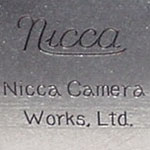
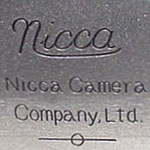 (Detail from larger web images)
(Detail from larger web images)
To digress for a moment. Up until now, the bottom of the shutter crate had been unadorned and all models from the early Nippon forward pretty much looked like the image below:
 (Detail from larger web image)
(Detail from larger web image)
Approximately the first 2/3 of Type-III A examples in my database also look like this. Type-III A number 3759x is the first with a cover plate added and 3755x is the last without it except for one slightly later camera - there may have been a transition period. The earliest Type-III B in my database with shutter crate visible is 3261x and that has the cover plate but I suspect that they all have them as the cover's main purpose was to protect the new Type-III B flash sync mechanism which sits at the bottom of the shutter crate at the spool end (left in the photos). Picture below is of a later 3-S with cover removed:
 (Detail from larger web image)
(Detail from larger web image)
Example below is an early Type-III S. What is visible is identical to the Type-III A and B with cover plates:
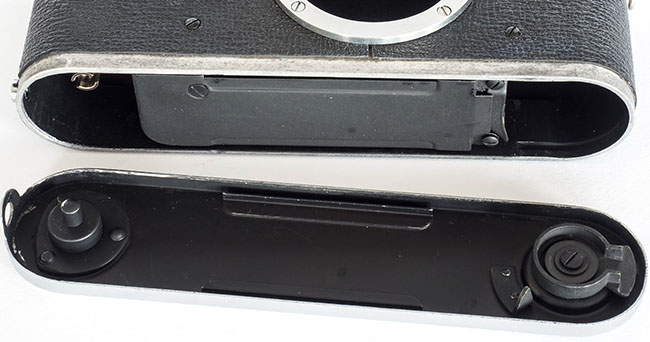
Note that the base plate locating channels to prevent the camera body flexing have returned to two separate pieces (now without visible fastenings). The change back to the separate pieces occurred at the same time as the shutter cover was introduced - the base plate sits very close to that and perhaps was the reason. The Tower Type-3 examples with flash sync featured a different partial cover - see Tower Models.
Below are Asahi Camera ads from 1952 on the left and 1953 on the right. Translated, the left says “III A standard type” and “III B with sync”. This is the only Nicca document where I have seen the III B mentioned by name (it does also make a cameo appearance in the above Hinomaruya marketing ad for its two brands). The right ad says “III-S with built-in sync” and “III-A general type. There is no built-in mechanism. Otherwise is exactly the same as S type”:
(Ads are from a Japanese website featuring manuals and other downloadable material)
(Click on ads for slightly larger versions)
Note, the two cameras in the left ad are still engraved “Type-3” with not a sync post or socket between them - obviously old photos reused. What appears to be the III S in the right ad is still engraved plain “Nicca”, meaning that it is likely a picture of the Type-III A with socketless sockets explained below.
The implication seems to be that the III B morphed into the III S with only the name to separate them. That would also explain the English language user manual cover and brochure below, both featuring the “III-A” and “III-S” together:


(Detail from larger web images)
At first glance, the cameras on the cover of the user manual, brochure and the example in the right hand Japanese ad above seem to be the Type-III S, i.e. with sync sockets, but at least in the brochure and ad they can't be because there is no “Type-III S” engraving. This also applies to the camera inside the manual cover with features labelled, including “Synchroniser socket”. They can't be the earlier Type-III B which featured sync posts, not sockets. Zoomed in to the full size images, the chrome rim of the sockets seems much flatter than usual and there is no hint of the sockets themselves which usually show up clearly. In fact much like the example below for sale in Japan:
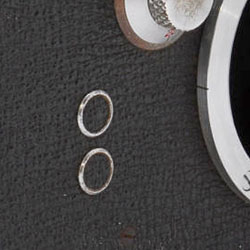
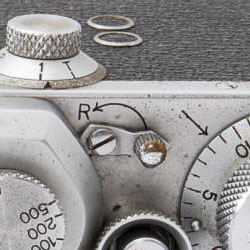 (Detail from larger web images)
(Detail from larger web images)
I originally thought that this camera may have been modified but the leatherette inside the chrome rings matches that outside. The serial number of the camera is 4501x, the highest serial number of any Type-III A or B I had found until then. My only thought was that it is a form of Type-III A. Now I know it is. A second one turned up with serial number, 4363x, complete with box with matching serial numbers and “Model III A” stamped on the bottom:

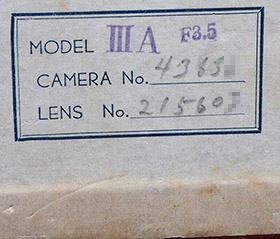
(Detail from larger web images)
Now there are seven, the last ones in my database, 4332x to 4539x. They progressively add/change some other features too so I have examined them as a separate group further below.
By the way, the camera on the cover of the user manual is 39021, about 2/3rds of the way through production of the III A and higher than any confirmed B example except the last found, 4008x, so the manual is from quite late. That is to be expected with a manual covering both an earlier model and later model (Type-III S numbers begin with “5”).
As noted above and described in Flash Sync Early Bodies, when flash sync first appeared on the Type-III B, it was in the form of two posts instead of PC sockets. The introduction of the PC socket type with the Type III-S is what defines the two models. My database clearly supports that.
One other change that occurred late in Type-III A production and early in Type-III S production was a revised viewfinder/rangefinder pressing with a larger radius for the accessory shoe and hence the shoe itself features a large radius corner much like the Leica III models:
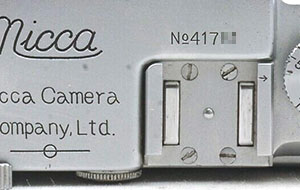
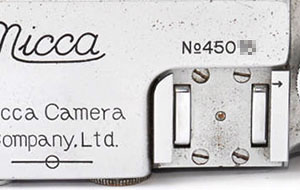
(Detail from larger web images)
With the Type-III A, the change occurred between late cameras 4187x and 4312x with both types found in between (on the Type-III S, it was between early cameras 5150x and 5238x).
Late Version Nicca Type-III A
I have already mentioned the seven examples with the highest serial numbers featuring the blanked flash sync sockets. There are some other later features being introduced as well (note, the last typical example being used for comparison purposes does not have the base plate engraving “Made in Japan” visible, that is assumed from the following camera and earlier examples):
| Nicca Type-III A with Blank Sockets | ||||
|---|---|---|---|---|
Serial No.s |
Base Plate Engraving |
Base Plate Cam |
Shutter Changeover Speed |
Nicca 3-S Film Guide |
| Last Typical Type-III A Without Blank Sockets (for comparison) | ||||
| 4329x | “Made in Japan” |
Black |
1/20 |
No |
| Type-III A with Blank Sockets | ||||
| 4332x | “Made in Japan” |
? |
1/20 |
No |
| 4342x | “Made in Japan” |
New, plated |
1/20 |
No |
| 4345x | “Made in Japan” |
New, plated |
1/20 |
No |
| 4363x | ? |
New, plated |
1/20 |
No |
| 4501x | “Japan” |
New, plated |
1/25 |
No |
| 4518x | “Japan” |
New, plated |
1/25 |
Yes |
| 4539x | “Japan” |
New, plated |
1/25 |
Yes |
The second last camera, 4518x, is probably the nicest Type-III A in my database. There are very few signs of use and the screws appear untouched. Note the blank sockets, plated base plate locking cam, “25” and “25-1” on the shutter dials and the 3-S/Type-4 type flash sync and film loading guide at the bottom of the shutter crate, presumably included for the loading guide only:
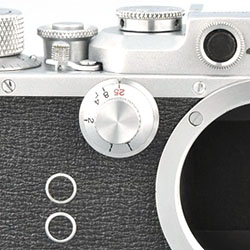
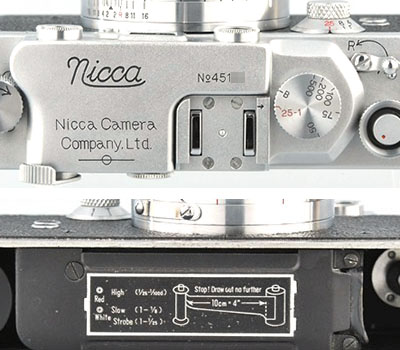

(Detail from larger web images)
Last camera, 4539x, is almost as nice and exhibits all the same features.
The first Type-III A engraving on the base plate locking ring started off with “Made in Occupied Japan” (MIOJ) and later changed to “Made in Japan” (MIJ). The last three feature the plain “Japan” on the base plate itself (more here). That change didn't come to the following Type-III S until about 2/3 of the way through my database and the Type-4 is a mix of both until it was consistently “Japan” on the Nicca 3-S.
The base plate cam lock changed from the first black type to a plated pressed metal type a little earlier, perhaps about 1/2 through my 3-S database (more here).
The changeover speed from slow speeds to the main dial had been 1/20 from the first Nippon onward. The increase of this to 1/25 was ushered in by the Type-4 (more here). When the Type-4 was released, the Type-III S soldiered on for a while but it wasn't upgraded straight away - when it was, it became the 3-S. As the III A and the III S were the same camera, apart from flash sync, it seems to me that the very late Type-III A cameras (last three in the table) were perhaps built on the chassis of the 3-S but without the film reminder in the winding knob. If that was the case, I wonder if the late III A received the improved rangefinder with 1 mm taller housing?
It's not that the Type-III A received any of these features first, it appears that it inherited these as they were being introduced to new models and therefore it is probable that it continued on as a budget alternative for far longer than most commentators, myself included, have previously thought. However, the big jump in serial numbers for the last three may mean a special late batch for some reason.
Nicca Type-III S
The Nicca Type-III S, with the model name helpfully engraved this time, is claimed to have replaced both the Type-III A and B. As confirmed by the ad, user manual and brochure in Nicca Type-III A & Type-III B, as well as the ad below and Japanese promotional booklet linked below the ad, the cheaper Type-III A continued to be available after the Type-III S release. The Type-III S certainly replaced the III B but the III A may have even outlived the III S, see Late Version Nicca Type-III A above.
Some, including Japanese Wikipedia, say the III S is from 1952, Mikio Awano says September 1952, Sugiyama claims 1953.
.jpg) (Click on ad for larger version)
(Click on ad for larger version)
This ad is from Mikio Awano's article in the September 1978 edition of Japanese magazine, Camera Collectors' News. The magazine's text at the bottom translates as “Nicca III S, 1953 March, Asahi Camera”. However, a form of the user manual seems to have been offered as a promotional booklet with a Japanese magazine in January 1953 already. Given lead times, Mikio Awano's date is looking good.
The camera pictured in the ad doesn't have have a model name engraved, again is likely to be a late III A with the blank sockets as above, but in any case, the III A, III B and III S were essentially the same camera except for the flash sync aspects. Below is correspondent Bill Tata's lovely Type-III S. The upper red PC flash sync socket is FP sync and the lower white is X sync:
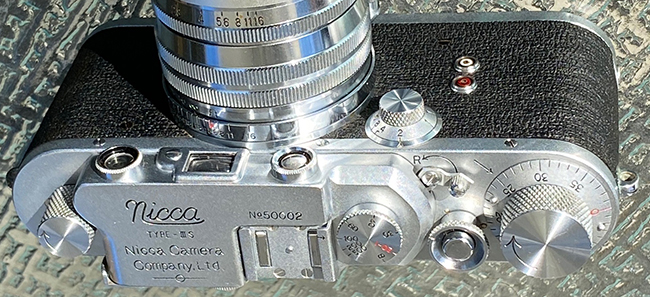
(Image courtesy of Bill Tata, note Canon lens mounted)
Incidentally, this camera is noteworthy for its remarkably low serial number, 50002. The III S numbering seemed to begin at 50000 (the 3-F lever wind begins at zero), or more likely, 50001. One of the examples in the combined Type-III A & Type-III S English language user manual is 50004. Usually, it is expected that there would be some numbered preproduction cameras that are used for final testing and also photos and reviews etc. that don't make it into the market place. Perhaps because the three Type-III models were basically the same camera, there was no separate preproduction run?
The camera below features the more curved left front corner of the accessory shoe compared to the early example above. This appeared during late Type-III A production and with the Type-III S, earlier on between camera 5150x and 5238x, providing further evidence of a substantial production overlap. Note, on this camera, the outer Chrome rings of the sync sockets appear original but the PC connectors themselves (green upper, red lower) appear to have been replaced, originally they would have been red upper, white lower as on the camera further above:
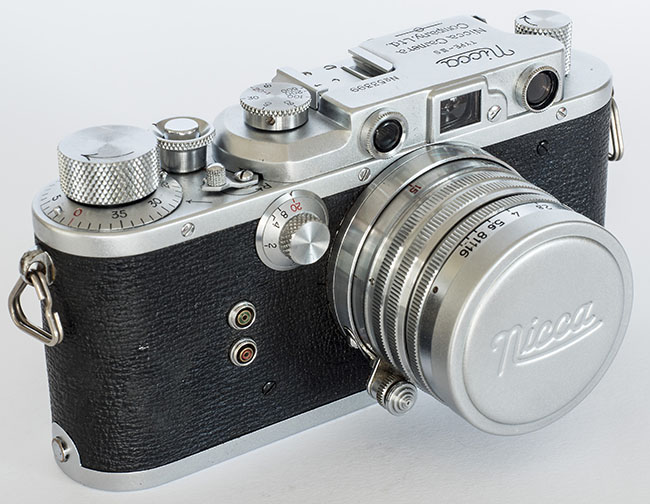

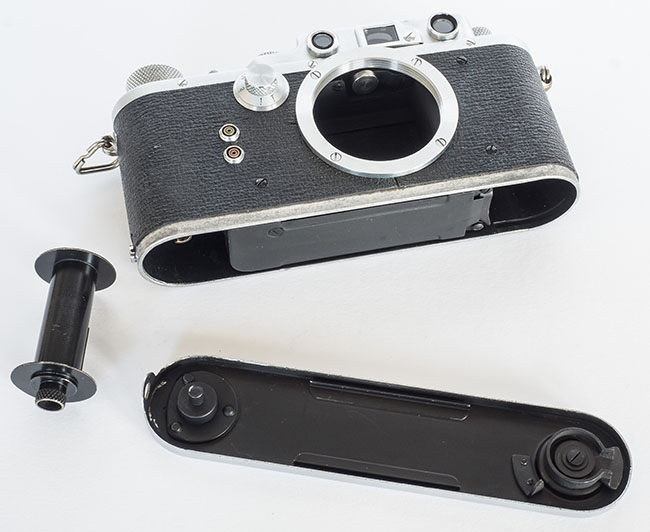
Somewhere between Type-III S 5496x and 5613x, the cam lock for the bottom plate changed from the earlier black painted type (left image, a variation of the original Nippon type and very similar to early Leicas) to a plated, pressed metal type (right image, Leica introduced their version, albeit in black, on the post-War IIIc in 1946 or 47). They are probably interchangeable as a late Type-4 seems to have been retrofitted with the earlier painted variety.
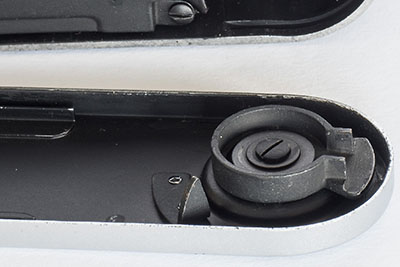
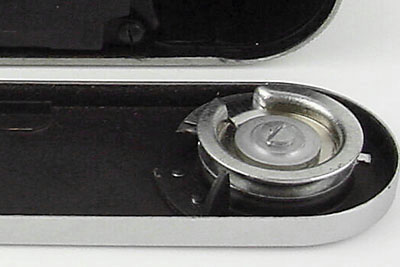
(Right detail from larger web image)
Nicca Type-4 & 3-S
It is easy to assume that logically 4 follows 3. Japanese Authority, Mikio Awano, offers an alternative logic and says that the Nicca Type-4 followed the Type-III S and was released first in August 1953 (Dechert, Sugiyama and McKeown agree with the year and Japanese Wikipedia with the date). According to Mikio Awano, it divided the family tree of models into two, its half leading to the Type-5, the 5-L and the III-L, effectively the premium range. The Type-III S soldiered on for a while and then was replaced by the Nicca 3-S in July 1954 which updated the Type-III S with the Type-4 improvements. Sugiyama only quotes years but he agrees (some claim that the Nicca 3-S, like the Type III-S, is also from 1952 but Japanese Wikipedia seems to conflate the two models into the one September release, implausible either way I think). According to Mikio Awano, this line of Nicca models led to the two 3-F models and Type-33, the mainstream more budget friendly line.
A clear indication that Mikio Awano is correct is that, as noted earlier, the “Japan” engraving arrived on the camera base plates towards the end of the Type-III S and features on all found 3-S examples whereas the Type-4 features approximately half with “Japan” and half with the earlier “Made in Japan” on the locking ring (no clear cut-off, a mix).
Also supporting this claim is the combined Type-5/3-S brochure below. When the Type-5 was released, it is likely that the Type-4 ceased to be available but it seems that the 3-S continued on as the budget alternative, probably until the 3-F was released (see 3-F brochure further below with reference to 3-S). The f/2 5 cm Nikkors follow much the same pattern, the Type-4 and 3-S starting in a similar place but the 3-S ending much higher at the same point the early lenses do on the Type-5. Both the 3-S and Type-5 share similar numbers for the new chrome 71xxxx lenses before the Type-5 alone moves to the 72xxxx lenses with black band.
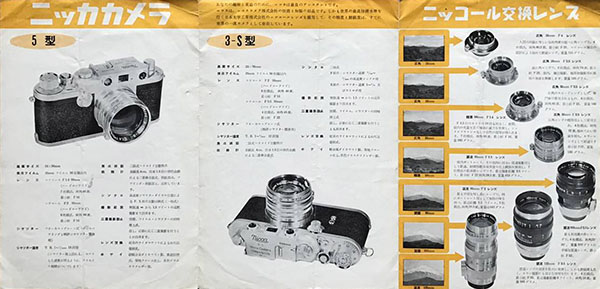
(Inside page from larger web brochure scan)
Below are Type-4 and 3-S ads:
(Click on ads for larger versions)
These are from Mikio Awano's article in the September 1978 edition of Japanese magazine, Camera Collectors' News. The magazine's text at the bottom translates as “Nicca 4, 1953 October, Asahi Camera” left image and “Nicca 3-S, 1954 December, Asahi Camera” right image.
The two models share both the found English and Japanese language user manuals (three and two examples respectively) so either the release dates must have been closer than commonly claimed, or more likely, there was a separate earlier manual for the Type-4 which has not been found yet. That would not be surprising, there are approximately 5 times as many 3-S examples in my database as Type-4s.
(Left manual scan courtesy of Chris Whelan, right cover from larger web image)
(Click on left cover for PDF of full manual)
Compared to the earlier Type-III S (left top plate knobs below), the Type-4 headline change was the addition of the 1/1000 shutter speed. A film speed/type reminder was added to the top of the film winding knob and the speed separation between low and high speeds (and also X-sync) changed from the earlier 1/20 to 1/25 with the new high speed progression B, 1/25, 1/50, 1/75, 1/100, 1/200, 1/500, 1/1000. Approximately half of Type-4 examples used an ASA only film reminder shared with the following 3-S type (see below) but the other half featured a combined ASA/DIN reminder with a flush face design that was totally unique to the Type-4:
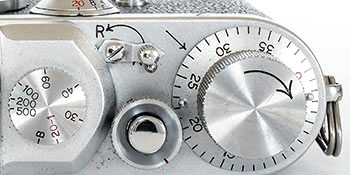

(Right detail from larger web image)
The two types are spread throughout the Type 4 serial number range and were presumably intended for different markets.
Below is the the 3-S with its updated shutter speed separation and progression and new ASA film speed reminder shared with 50% of Type-4s:
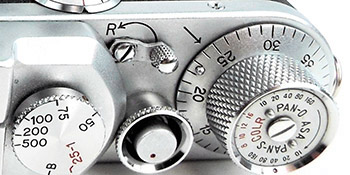
(Image courtesy of Chris Whelan)
The Type-4 with highest serial number, 8119x, has the late Tower 3-S/Nica Type-5/3-F film reminder which features film type only without any speed scales. It is not possible to tell whether this is original to the camera but it may be a late Type-4 update:
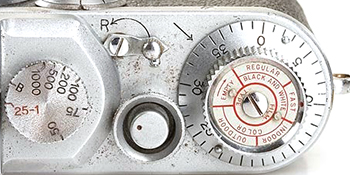
Also, according to Mikio Awano, the Nicca Type-4 and 3-S rangefinder was improved and as a result, the viewfinder housing increased in height by about 1 mm (Camera Collectors' News 1978, September).
As noted in Flash Sync Early Bodies, about 50% of Type-4 examples feature the sync socket name plate shared with several of the Tower models:
 (Detail from larger web image)
(Detail from larger web image)
Most of the examples in my database are from Japan. The pattern of approx 50% with the ASA/DIN film reminder dial and 50% with the sync socket name plate seems to be completely random with both early and late cameras affected with each possibility. If there are any patterns, I would say that probably batches were the same and there is a slight correlation between cameras with the ASA/DIN reminder not having the sync socket name plate, but there are exceptions. A mystery.
A little way into its production, between camera 6131x and 6184x, the 3-S received a Leica-like plate attached to the bottom of the shutter crate with film loading and flash sync information, similar to the adhesive label found inside the bottom plate of most die-cast models (see further below), except the Type 33. The plate is only fitted to the last two Type-4 examples in my database with the shutter crate visible (8105x and 8113x). Both models likely received the plates at a similar time and to me, this is further indication that the Type 3-S arrived later and survived longer:
 (Detail from larger web image)
(Detail from larger web image)
The high speed sync is indicated as 1/25 to 1/1000 on both models' plates whereas the top speed of the Type 3-S is 1/500. No doubt that was to save production costs but clearly, they were designed to suit the Type-4 when they were introduced, not just added to the Type-4 as an afterthought.
Nicca Type-5
The Type-5 was an important milestone for Nicca. It was the company's first die-cast model and its specs closely matched the Leica IIIf plus there was the Leica M3 idea of adding a flap to the camera back. To show it off, Nicca supplied a new style ever-ready case which to my eyes is over-designed and big, but regardless, was probably expensive to make. The design wasn't used for any other models. With at least some of the Japanese market Type-5 cameras, rather than the usual booklet style user manual, Nicca supplied a more comprehensive 197 page book - more details in User Manuals.
Whilst still available with the Nikkor f/1.4 5 cm lens, the Type-5 also introduced a new version of the Nikkor f/2 5 cm lens with slightly updated barrel (still all chrome). The lens serial numbers begin with “7” instead of the earlier version's “6”. The f/2 Nikkors on later Type-5 cameras were further updated with a black band for the aperture scale and minor changes to the distance scales:

The Nicca Type-5 is claimed by Mikio Awano and Japanese Wikipedia to be released in March 1955. The ad below featuring camera serial number 125001, possibly the first one in the series, is from May 1955 so that makes sense:
.jpg) (Click on ad for larger version)
(Click on ad for larger version)
This ad is from Mikio Awano's article in the September 1978 edition of Japanese magazine, Camera Collectors' News. The first part of the magazine's text at the bottom translates as “Nicca 5, 1955 May” but the magazine name is beyond my translator's capability. The camera was also mentioned as a news item in the June 1955 edition of Japanese magazine “Photographic Industries” (title in English).
The Type-5 continued with the higher Type-4 1/1000 shutter speed and features the Leica IIIc/f/g like dioptre adjustment under the rewind knob. Unlike the Leica M3 and later Nicca 5-L and III-L models, the trapdoor in the back is side-hinged. The black metal band above the leatherette is unique to the Type-5. Contributor Chris Whelan's example:
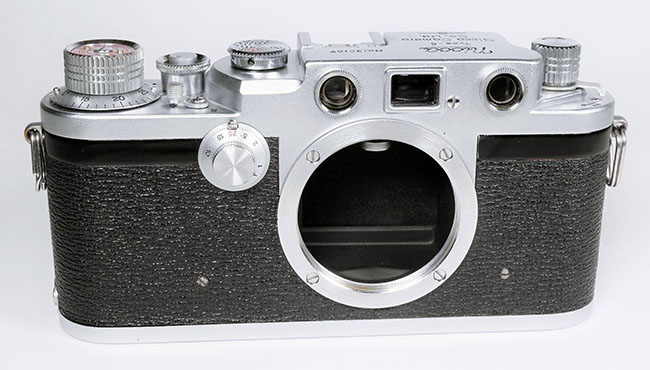
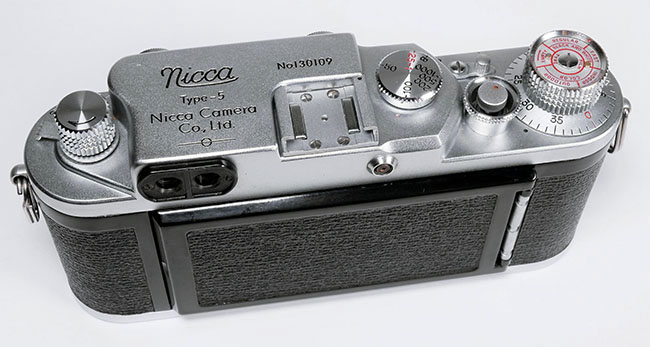
(Images courtesy of Chris Whelan)
Note, the rear flaps on both the Type-5 and later 5-L are removable.
This is is the Type-5 brochure with accessories and Nikkor lenses on the reverse:
(Click on either for double sided PDF)
The Type-5 omitted the two body support angle pieces from inside the base plate. I have also seen these referred to as “light baffles”. Whilst that may be one function, why did earlier Niccas and other makers bother with a front one when that area could be sealed by the shutter crate and why isn't there one all the way around, particularly at the spool end? The rear one is the important one, providing support to the camera back if somebody squeezes the large expanse of back hard. The front of the cameras is supported by the structurally strong shutter crate. Nicca probably felt that with the stronger die-cast body and the frame around the hole and the solid trapdoor itself provided sufficient resistance to flexing. The one at the rear of the camera was reinstated on the other die-cast bodies including the 5-L. Upper is 3-F base plate, lower is Type-5 base plate:
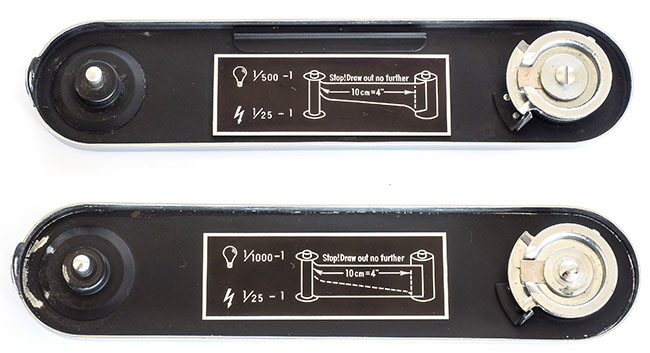
Nicca 3-F & 3-F (lever)
Confusingly, with the knob wind Nicca 3-F, Nicca nomenclature reverted to having a form of “3” in the model name for all future models (except for the 5-L development of the Type-5 but even then, there was the confusingly “3-F” named version of the 5-L which has been found in greater numbers - see Nicca 5-L). Initially, the thinking may have been that the Type-5 was a leap in features and followed the Type-4 but the 3-F was a 3-S in an updated body (somewhat like Leica following its stamped body III/a/b models with the die-cast IIIc). If that was the thinking, the final III-L model was based on something else.
The 1956 (October, Mikio Awano and Japanese Wikipedia) 3-F looks like an economy version of the Type-5 with the trapdoor, black band and 1/1000 top speed being deleted. Both of the 3-F models and subsequent Type 33 also lost the dioptre adjustment that had been there from the Type-3 on (lever around early body rangefinder viewing window, lever under rewind knob on Nicca Type 5 and later 5-L).
Note that neither the ads nor brochures further below mention the availability of the Nikkor f/1.4 lens with either version of the 3-F. Early 3-F knob wind examples still feature the all chrome version of the updated f/2 5 cm Nikkor but the majority were already fitted with the black aperture band version (the camera below could still have been fitted with either but the low lens number suggests the lens, bought separately, originally belonged to a Type-5):
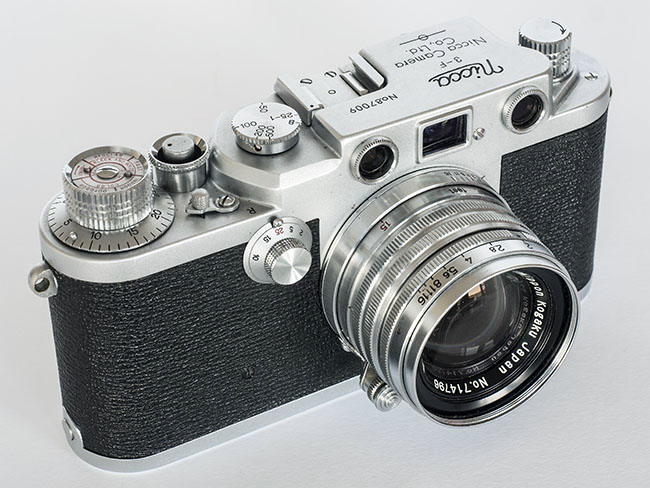
Like all die-cast models, except for the Type 33, the bottom plate features a film loading and flash sync guide:
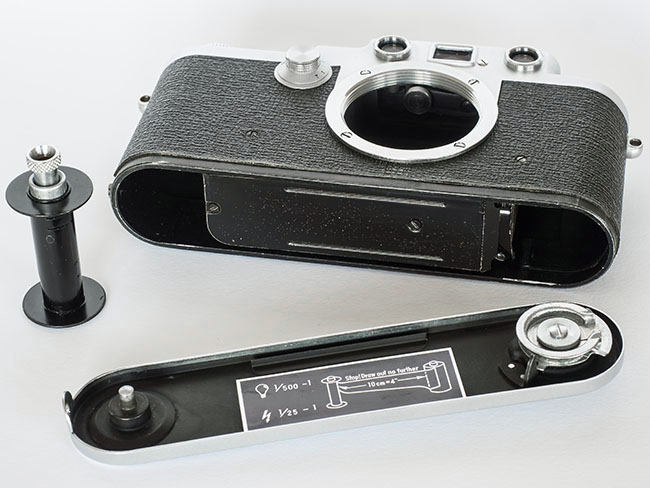
This is the 3-F brochure with accessories and Nikkor lenses on the reverse:
(Click on either for double sided PDF)
At the top of the yellow page is the following (machine translated):
“Nicca Camera 3-F
- Type-5. 3-S type is a popular model with a new design by the well-known Nicca camera engineers who are well received.
- The best-priced high-end machine has become the most affordable price due to the rationalised production.
- Please share various accessories except the case (ever-ready) with the Type-5.”
To me, it seems to be drawing on the legacy of both the Type-5 and the 3-S and is replacing the 3-S as the more affordable companion to the Type-5, thus perhaps explaining the absence of the f/1.4 Nikkor.
A lever wind Nicca 3-F appeared in 1957 (July, Mikio Awano and Japanese Wikipedia), almost certainly as a replacement (same release price, no additional version identifier on the top plate). The lever version user manual simply refers to the “3-F” without qualifying it with “lever”, or in any other way. It also doesn't appear to acknowledge the original knob wind version. Whereas we tend to see it as two models, it seems to me that Nicca just saw it as one model with a mid-life update, hardly worthy of mention, although the serial number ranges are quite separate.
The specs are identical, the only difference is the lever wind and a slightly altered body to accommodate it - see Changeover from Stamped to die-cast Bodies for details. In the process, the film reminder in the top of the film winding knob was replaced by the new manually re-set film counter:
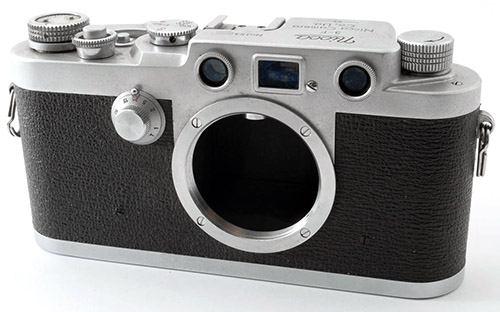 (Detail from larger web image)
(Detail from larger web image)
The 3-F in the left ad is from right at the beginning (serial number 85002) and the 3-F (lever) on the right is serial number 151144 from near the beginning of its range (Japanese user manual camera 151000 appears to be the first, an unusual number to start at) so the dates of the ads are probably in the ballpark of the claimed release dates:
(Click on ads for larger versions)
These are from Mikio Awano's article in the September 1978 edition of Japanese magazine, Camera Collectors' News. The magazine's text at the bottom translates as “Nicca 3F, 1956 September, Asahi Camera” left image and “Nicca 3F (L), 1957 September, Asahi Camera” right image. Note, the release price of both is the same, no obvious reference to “lever” in the right ad. The ad also lists 180 mm, 250 mm and 500 mm Nikkor lenses (the only time that I am aware) that would require an accessory reflex housing to use - see Wide Angle & Telephoto Lenses.
This is is the lever wind 3-F brochure with accessories and Nikkor lenses on the reverse:
(Brochure scan courtesy of Chris Whelan)
(Click on either for double sided PDF)
There is also a third type of 3-F, a 5-L with the 3-F engraving, see below.
Nicca 5-L (aka the 3rd 3-F model)
The follow-up to the Nicca Type-5 was the Nicca 5-L, basically the Type-5 with the flap now top hinged in a 3-F lever wind body. It is extremely rare (not so much the Tower 45/46 versions sold by Sears in the US or the “other” Nicca version which we are coming to) so there is little concrete information about it. Peter Dechert thinks that the 3-F lever wind and 5-L may have been released at the same time in 1957. Mikio Awano says uncharacteristically that it “seems” to have been released in 1956 (his other dates are precise to the month). As we shall see later, the Nikkor f/2 lens serial numbers suggest that in fact the Tower versions sold by Sears in the US may have indeed arrived at the end of 1956, beginning of 1957, however both body and Nikkor serial numbers indicate that the actual “5-L” named model and the “other” one were released at the end of 1957, or beginning of 1958, basically at or near the end of 3-F lever wind production. Whilst there is only the one identical body, we are actually looking at three individually named models separated by markets and time.
Whilst there are 26 examples of the Tower 45/46 version in my database, according to Stephen Gandy's CameraQuest website, HPR's well known collectors' volume, “Leica Copies”, says the “5-L” named version “has never been seen” and Japanese authority, Mikio Awano, says that he hasn't seen one either and claims that the 5-L model wasn't sold in Japan. Below is an actual 5-L from Massimo Bertacchi's “Innovative Cameras” website, the only sighting I know of:
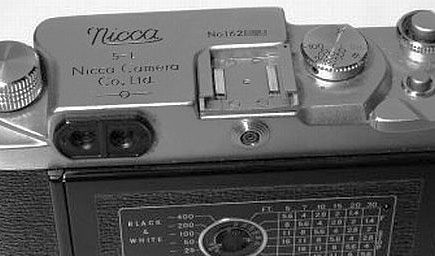 (Detail from Innovative Cameras)
(Detail from Innovative Cameras)
However, very strangely, my database also contains ten lever wind cameras which are identical with typical 5-L features including top hinged trapdoor, 1/1,000 shutter dial and dioptre adjustment lever under the rewind knob, except that nine have top plates engraved “3-F” and one has a metallic label marked “5-L” over where the model type engraving is usually found. Eight have serial numbers in the 161xxx range, all within 240 cameras of the 5-L serial number, 162xxx, one has a serial number 162xxx only 8 cameras below the 5-L and one has a serial numbers within 40 cameras above the 5-L. The serial numbers of these cameras are higher than typical 3-F serial numbers which top out at 15761x (there is a single unexplained 18288x, perhaps a new range because of the numbers used for the 5-L versions). The clear conclusion is that they share the serial number range with the 5-L. To state the obvious, the “3-F” named version of the 5-L seems many times more common than the “5-L” named version. The source of one of the cameras is unknown and from memory, all bar one of the others have been for sale in Japan.
These images of the 3-F version have been provided by Mike Eckman with kind permission of owner Casey Winstead. Mike has done an excellent review of the Tower version (see also Useful Links). Except for the reinstated dioptre adjustment under the rewind knob, the front appearance of all three (5-L, Tower 45/46 and 3-F versions) is the same as the lever wind Nicca 3-F:
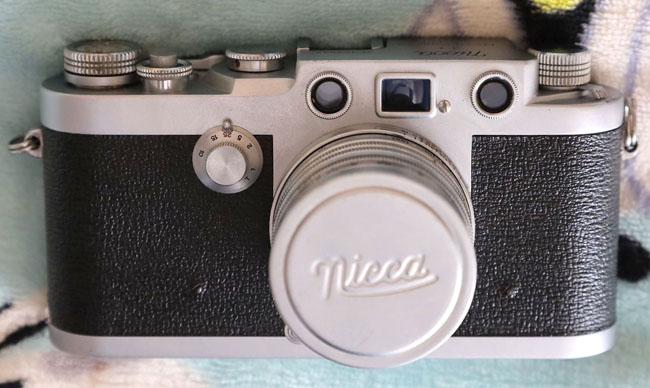
Replacing the film type reminder in the top of Type-5 film winding knob is a larger reminder and flash exposure guide that takes up much of the rear flap area:
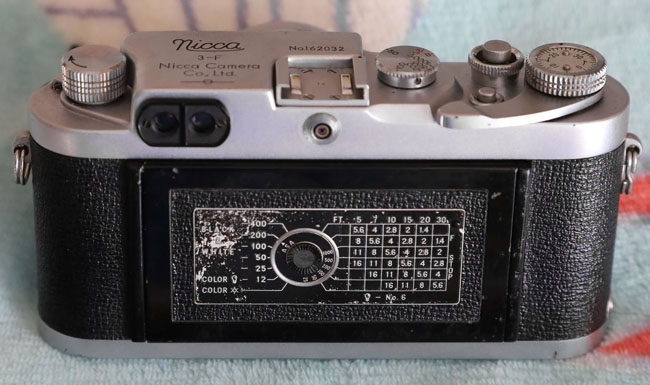
The trapdoor is now top hinged and closely matches its Leica M3 inspiration:
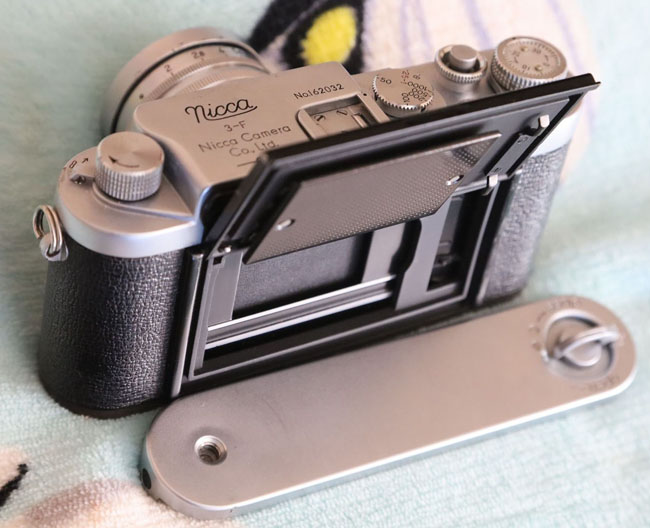
Note the diopter adjustment lever and 1000 top speed which set it apart from the typical 3-F lever wind model:
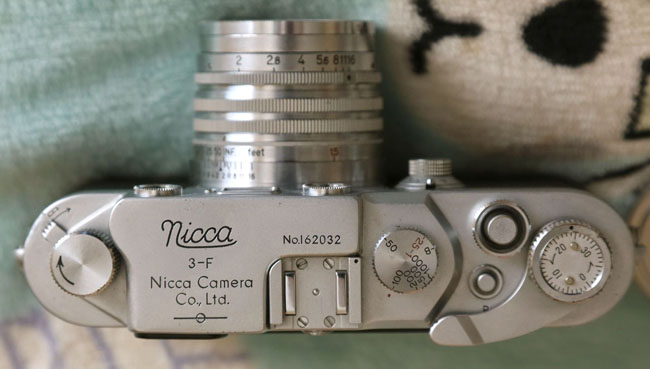
(Images courtesy of Casey Winstead)
Note, the lens is an earlier all chrome version from a Nicca Type-5.
The serial numbers suggest to me that perhaps the 5-L was not just released after the 3-F lever model was released but near that model's end of life. Three of the “3-F” named versions of the 5-L were found with f/2 5 cm Nikkor lenses still with serial numbers relatively close to each other (so more likely to be original), 750xxx to 759xxx, which at one end puts them into the last of the 3-F lever examples and at the other, almost as high as any lens found on the III-L so far (751xxx-762xxx). So late 1957 or even into 1958.
On the other hand, the Sears version of the camera with the f/2 Nikkor lens, the Tower 45, features lenses with serial numbers 725xxx to 752xxx, the start of which is more like the end of the Nicca 3-F (knob) range suggesting that when the 3-F (lever) was released in Japan, the Tower 45 and f/1.4 Tower 46 version had already been released in the USA. There the Tower 48, the Sears version of the Nicca 3-F (lever), seems to have been released much later than in Japan. I also think that whilst the Tower 45/46 was the camera destined for the US market and the 3-F was the Japanese named 5-L version, the actual “5-L” named model was destined for the rest of the world, noting that that there is no evidence that Nicca had successfully developed other markets and this may have been desperation near the end of its life, hence its lack of penetration and elusiveness these days.
So whilst serial numbers are suggesting an even more extreme divergence in release dates, one thing I feel relatively comfortable concluding is that the Tower 45/46 cameras were released in the US earlier than the other variants elsewhere including Japan.
In regard to the Japanese version, here is an observation on price. The ads above for the two 3-F models indicate a release price of ¥49,500 for each. The III-L, admittedly being released into a difficult market, was priced at ¥53,500, a difference of only ¥4,000 yen, or approximately 8% premium for the higher 1/1000 shutter speed, opening film loading flap and dioptre adjustment all found on the 5-L already plus the III-L automatic frame counter reset and new viewfinder, not to mention recouping development costs. That didn't allow much space for the 5-L to slot into. Maybe in Japan, the 5-L was marketed as an updated 3-F, much as the lever version had been.
Nicca Type 33
The final Leica IIIf look-alike model was the Nicca Type 33, probably released in early 1958 (no name on the top plate, “Type 33” label inside on the base plate). Mikio Awano and Japanese Wikipedia claim May 1958 which is the same month Nicca was acquired by Yashica, Peter Dechert says late 1957 and Sugiyama simply 1958. Unlike with the III-L, there are no Yashica fingerprints over any of the marketing material I have seen. Why “Type 33”? A Japanese blogger has suggested it is named for Showa 33, the Japanese era equivalent for 1958.
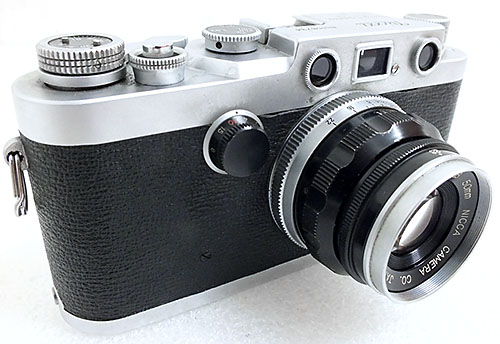

(Detail from larger web images)
If there is any doubt that it was a bargain model, the Japanese ad below tells potential customers to “consider the price when faced by possible criticism.” Although similar to the 3-F with lever wind (I'm not sure whether to replace it or supplement it), this version featured an X flash sync of 1/60 instead of the 1/25 on the 3-F and a cosmetic change with the top plate of the larger body type no longer continuing down the sides of the lens mount. The slow speed shutter dial was now black with a new Canon VT-like profile (introduced 1956). The slow speed shutter dial lock introduced with the Type-5 was deleted on both this model and the III-L. Note, the X sync speed of 1/60 came at the cost of being able to use flash bulbs at above 1/30 at a time when amateurs were still relying on them and was more likely to be about cost cutting than an upgrade (the 3-F and other models could sync FP bulbs at any speed, restored on the III-L and Yashica YE and YF).
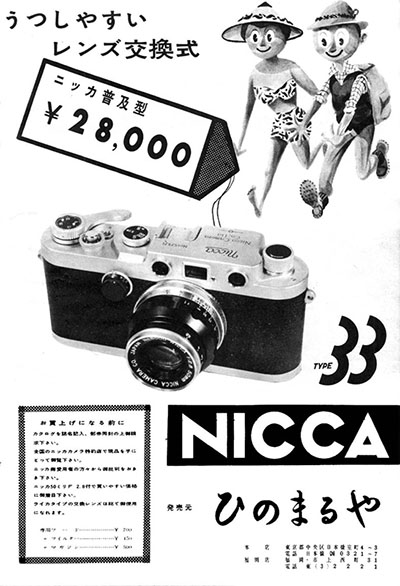 (Scan courtesy of Chris Whelan)
(Scan courtesy of Chris Whelan)
(Click on ad for larger view)
The bottom right corner features distributor Hinomaruya's name and address (as all Nicca ads since 1950 had). This ad appeared/also appeared in the August 1958 edition of Asahi Camera magazine. It could have been pre-booked months earlier or business continued on as normal for a while as arrangements were sorted out. Unlike with the III-L, no Type-33 ads, brochures or manuals have been found with Yashica's name and/or address.
Mikio Awano, in an article in Japanese magazine, Camera Collectors' News, September 1978 edition, claims that by the end, the price was further discounted by ¥8,000 yen to ¥20,000.
The biggest change was the dropping of the Sonnar type Nikkor standard lenses in favour of the f/2.8 50 mm Nicca branded, and most likely, Tessar type. The 4 element design is confirmed by this Japanese brochure (the reverse features accessories):
(Brochure scan courtesy of Chris Whelan)
(Click on either for double sided PDF)
Speculation has surrounded the source of this lens. Some suggest that it is a rebranded Fujinon and whilst the cosmetic appearance is superficially somewhat similar, there are key differences too such as the Fujinon has 5 elements (table on page 23 of Leotax TV2 user manual), basically end of story. But I'll go on. Nicca has 9 curved aperture blades with progressively spaced aperture scale and the Fujinon 10 straight blades with equally spaced aperture scale and the ribbing on the Nicca aperture ring is on the higher ridges whilst on the Fujinon it is in the hollow valleys. There are plenty of other smaller differences too. Make no mistake, this was a budget lens designed to reduce the cost of the package whereas the Fujinon was from one of the premium suppliers. I have to definitely agree with Japanese Wikipedia that the source of the lens is unknown. There is more here, comparing it with the early YE Yashikor including noting that there are two versions; early small front barrel with 34.5 mm filter thread and found serial numbers 805x to 1003x (left image) and late large front barrel with 40.5 mm filter thread, double row ribbing for the aperture ring and serial numbers 10100 to 1084x (right image):

 (Detail from larger web images)
(Detail from larger web images)
Special thanks to correspondent Leland who wrote to me about his late lens 10100, gave me a new earliest lens number, 805x, and helped fill out my database. His lens, 10100, is now the earliest late type. It is only 60, or so, after the last of the first type and the intriguing question is whether, with such a nice rounded number, it is actually the first of its type, or whether the changeover just occurred somewhere in the middle of the 60:
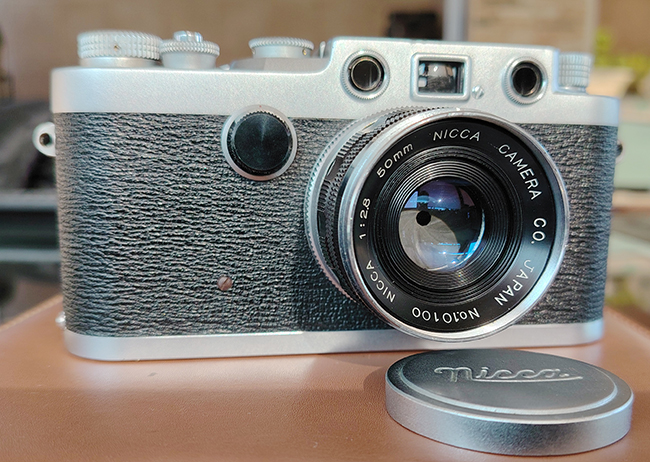
(Image courtesy of Leland)
The total made is probably less than 3,000, approximately 2/3 early type and 1/3 late type. This is well less than half suggested by Type 33 body serial numbers, confirming that Nicca body numbers are not a reliable indicator of production figures.
Nicca III-L
The last model, the Nicca III-L (sometimes written without the hyphen but III-L on the orange label inside the camera and on the user manual and box) was released in June 1958 according to Mikio Awano and Japanese Wikipedia, i.e. one month after Yashica's usually quoted date of acquisition, May 1958. As noted on the YE & YF page, there are some unanswered questions about the dates but whilst not immediately obvious, most (but not all) found marketing material is linked to Yashica through the contact addresses - see also below.
Some have described it as a Leica M3 with screw mount but most of that commentary is focused on the M3-like flap, which had its genesis with the Nicca Type-5, and the improved viewfinder (not to M3 levels). The reality is that Nicca (and Leotax with its Leotax G) was at least trying to stay in touch with advances being introduced by the more expensive Canon and Nikon models and it took the route requiring least expensive development and retooling work. It's easy to blame the advent of the SLR for Nicca's demise but Canon's capable budget model, the Canon P, released in March 1959 and its premium model, Canon 7, released in September 1961 became Canon's two biggest selling interchangeable lens rangefinder models. It's difficult to know whether the III-L was simply too late to make a difference to Nicca's future, or whether it was no longer competitive enough feature-wise.
The design features a clean, minimalist aesthetic. It is still a Leica copy under the skin but the top plate design is very different and the camera features some innovative ideas. The body is based on Nicca's previous highest spec model, the 5-L, but the top plate is quite flat across the top and taller too to accommodate the larger and more refined combined 1x viewfinder/ rangefinder and its windows with parallax corrected projected frame lines (for a 50 mm lens only whereas its successor, the Yashica YF, also has them for 100 mm, or 105 mm depending on which Yashica ad/brochure). As well as the slow speed dial looking even more like that on Canon's 1956-1958 models than the black Type 33 iteration, the III-L's pop up rewind knob was another similar feature debuting with the 1956 Canon VT.
The featured camera belongs to correspondent Mr. Cheyenne Morrison @BigShotPhotos:
.jpg)
New large single eyepiece and the simple film type reminder on the back which is more discreet than that on the 5-L with its combined flash exposure calculator. The film advance is no longer on the top plate but operates through a slot on the side of the body:
.jpg)
.jpg)
.jpg)
.jpg)
(Images courtesy of Mr. Cheyenne Morrison @BigShotPhotos)
Model name inside. Unlike the Yashica YF and other Niccas, the frame counter reset is automatic when, I'm guessing, the baseplate is removed (like opening the back on post-60s SLRs). I assume that it is operated by the new fixed pin on the base plate (silver dot towards the left below) which engages with the end of the actuating rod above it at the bottom of the shutter crate (just to the left of the name label) and which presumably connects to the film counter above it at that end of the top plate:
.jpg)
(Images courtesy of Mr. Cheyenne Morrison @BigShotPhotos)
This is another view of the base plate pin. Whilst the same in other respects, this baseplate is not interchangeable with earlier lever wind Nicca models or the Yashica YF:
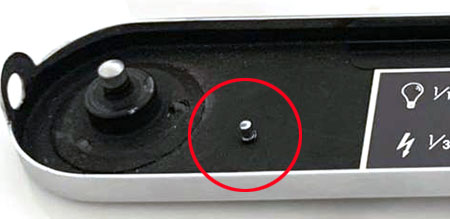 (Detail from larger web image)
(Detail from larger web image)
The camera back features the large 5-L top hinged Leica M3-like flap to assist with film loading. Below is the III-L flap compared to the inspiration on the Leica M3 underneath:
.jpg)
(Image courtesy of Mr. Cheyenne Morrison @BigShotPhotos)
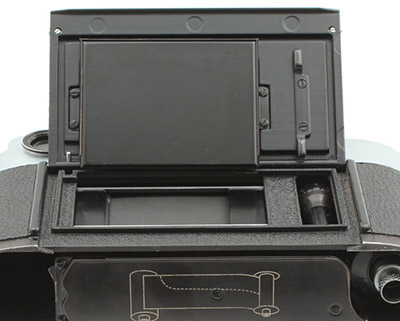
(Detail from larger web image)
The shutter mechanism and two dial operation remained as before. The flash sync speed dropped to 1/30 instead of the Type 33's 1/60 but on the other hand, it retained the high speed FP sync, 1 sec and Time settings dropped from the Type 33 and the maximum 1/1000 speed of the Type-4 and the two 5 models. The standard lens continued to be a Nikkor f/2 5 cm, or the optional f/1.4 version.
The film advance reportedly works very smoothly with just the right stroke length and is ergonomically sound but on the other hand, there is something a little disturbingly Heath Robinson-ish about its appearance and it is certainly not from the Leica mould. A small number have appeared for sale with snapped levers. It's not an entirely original idea either. The concept, if not the execution, is not unlike Shinano's Pigeon 35 Model III which was amongst the leaders in adopting lever wind, the first version putting the lever in a slot (abandoned for a conventional lever soon afterwards). That was in 1952 (Sugiyama) or 1953 (Asahi Camera ad). Pigeon 35 Model III:
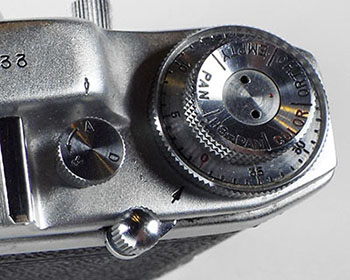
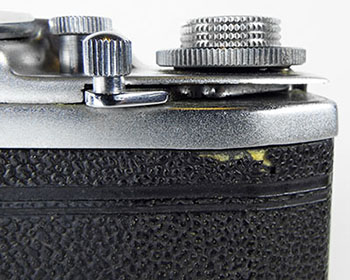
(Images courtesy of Chris Whelan)
The Nicca III-L version:
.jpg) (Image courtesy of Mr. Cheyenne Morrison @BigShotPhotos)
(Image courtesy of Mr. Cheyenne Morrison @BigShotPhotos)
Definitely an easier to use Leica screw mount camera but many features and polish short of the M3, as you would expect with the very sizeable price differential. However, there was no compromise with lens quality, the standard lenses remaining the highly regarded f/1.4 and f/2 5 cm Nikkors with access to the rest of the Nikkor ecosystem and therefore offering a less expensive alternative to its Canon and Nikon competition and even the M3 in terms of outright image quality.
As noted on the YE & YF page, a comprehensive brochure, probably mostly prepared before release, has neither distributor Hinomaruya's nor Yashica's name/branding but the address is Yashica's head office as it is in the III-L ad with “Yashica” in the bottom right corner. Below left is the back panel of the four panel brochure, and on the right, most of the ad :
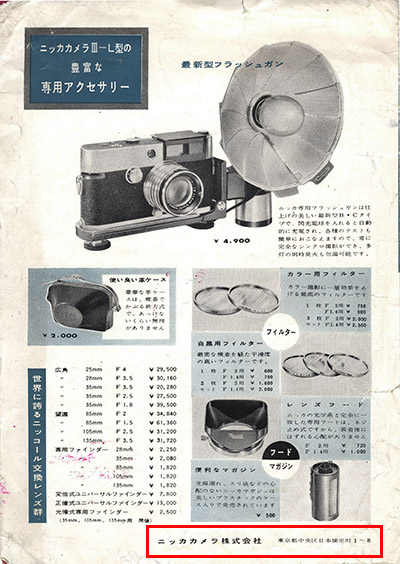

(Detail from larger web images)

The address on the brochure in the red rectangle, shown larger below the ad, translates as “Nicca Camera Co., Ltd. 1-8 Nihonbashi Muromachi Chuo-ku, Tokyo”, as do the last two lines of the ads above right and below.
 (Detail from larger web image)
(Detail from larger web image)
Clearly, Yashica marketed, or took over marketing of the III-L from Hinomaruya, however, does the ad below with Hinomaruya's name and address in the bottom right corner mean that the III-L was released still under Nicca ownership? Possibly, or perhaps the ad was pre-booked sometime in advance. I think that most likely nothing changed initially as Yashica took over ownership and found its feet running things. Nicca was acquired as a going concern before bankruptcy could take place and no doubt there were contracts in place, certainly with Hinomaruya but also possibly Nippon Kogaku. Some things we just don't have answers to but Mikio Awano didn't seem to be conflicted by the May takeover, June release and September ad dates:
.jpg) (Click on ad for larger version)
(Click on ad for larger version)
This ad is from Mikio Awano's article in the September 1978 edition of Japanese magazine, Camera Collectors' News. The magazine's text at the bottom translates as “Nicca III L, 1958 September, Asahi Camera”.
Tower Models
Catalogues & Names
Some people, including Camera-wiki.org, refer to a “Tower 35” model. In my view, there is no Tower 35 model. Sears used the name generically for its Nicca based models, as one would for “Leica”, or “Canon Rangefinder”. There was usually only one model on sale at a time and not a lot of differences so it was easy shorthand for marketing purposes.
The 1952 catalogue page is headlined with “TOWER 35 - Sears own imported precision camera” yet the camera depicted is engraved “Tower Type-3”:
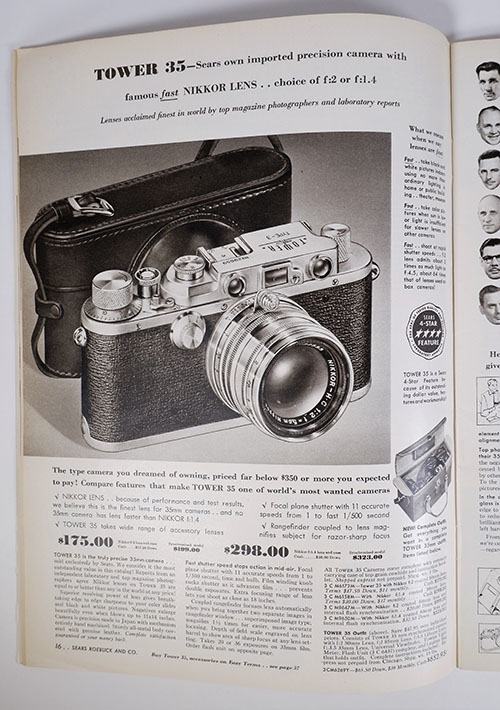
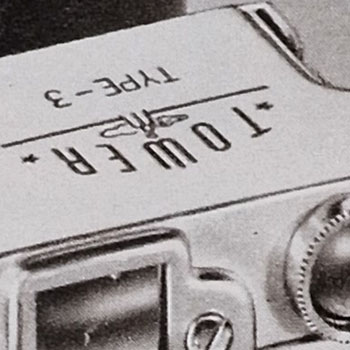
(Images courtesy of Chris Whelan)
Just to confirm that, the user manual for the the Type-3 says “TOWER 35 mm CAMERA Type III”. The only confusion is whether we should call it “Type-3” or “Type III”:
.jpg)
_2.jpg)
_3.jpg)
(Scans courtesy of Chris Whelan)
The 1955 and 1956 catalogues both feature a camera engraved “Tower Type-3S” but the page headlines and text still describes it as the “Tower 35”.
Although the text on page 6 of the 1957 catalogue is all about one new die-cast model with 1/1000 shutter speed, three different models are pictured but the headline remains the earlier “Tower 35” without any other model identifiers mentioned. The main picture and the “Complete Tower 35 Camera Outfit” features the Tower version of the knob wind Nicca 3-F (it is not the Type-5, there are not enough speeds on the main shutter dial for there to be a 1/1000, there is no diopter lever under the rewind knob and there is no black band below the top plate). At the bottom of the page on the left, it says, inter alia, “Famous Tower 35 Camera described above but without the lens.” The drawing is of an earlier stamped body model. The middle drawing of the three on the top right shows a top hinged rear flap in the open position with the description “Back of the new TOWER 35 now is removable...”. The camera to its right features lever wind and diopter lever, it is unequivocally the Tower version of the Nicca 5-L and is most probably the camera that is being featured in the text, regardless of the images. From Sears' own user manual, we know that the version with Nikkor f/2 lens is the Tower 45 and the version with Nikkor f/1.4 is the Tower 46:
.jpg) (Click on page for larger version)
(Click on page for larger version)
The Tower 1958 catalogue is headlined with “TOWER 35 .. Sears Finest 35mm Camera” but this time we can tell that it is clearly the Tower 45/46 pair that are being featured. However, as previously, there is no mention of those model identifiers:
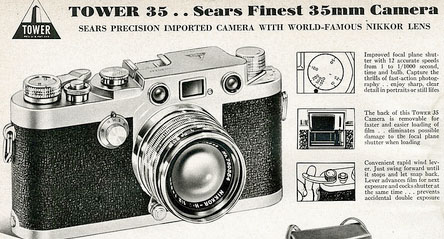 (Detail from larger web image)
(Detail from larger web image)
Finally, the 1959 catalogue is headlined “Prices Cut on Our best TOWER 35mm Cameras” and the fine print tells us that they are the Tower 45 and 46:
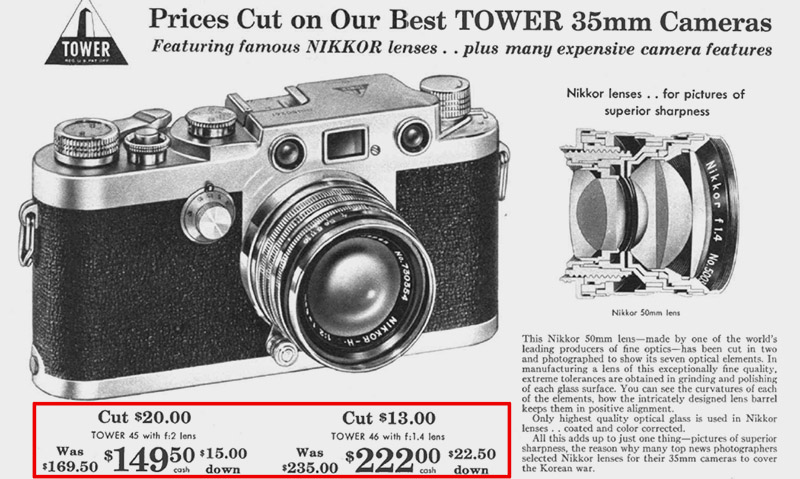
(Detail from larger web image)
It's not surprising that different people have identified both the Tower Type-3/3S and Tower 45/46 as the “Tower 35” depending on which camera they were researching. Clearly, “Tower 35” is a camera type description rather than a specific model name. Also, as will become obvious, there are more Tower models than names discovered yet and not all models appeared in the catalogues.
Sugiyama Gets it Wrong Too
Sugiyama's “Collector's Guide to Japanese Cameras” is the bible, as its name suggests. However, as much as westerners often make a hash of Japanese camera history, that works in reverse too when he attempts to catalogue US Tower Models. Although premature as “The Models” below will clarify things, I have included this section here because he has a “Tower 35” too - his is based on the Nicca 3-F lever wind (almost certainly the Tower 48).
His other Nicca based Tower models are:
- Tower 3 (actually Tower Type-3), 1949, is claimed to be based on Nicca Type-3. 1949 is too early for Tower models and as explained below, the Tower Type-3 seems to match the Nicca Type-III A and B.
- Tower 3S (actually Tower Type-3S), 1954, is claimed to be based on Nicca Type-III S. Agreed regarding the model but 1954 seems too late, the Nicca version seems to have been released towards the end of 1952.
- Tower (actually Tower Type 46, he refers to its f/1.4 lens), 1957. Apart from the incomplete name and no mention of the Type 45 version or its f/2 lens, agreed.
The Models
It is easy to assume that this was just a re-branding exercise. Yes and no. Also, whilst the two earliest models have an engraved model name, the rest don't. The earlier models seem to share Nicca serial numbers, or at least fit at one or the other end of the range for the model. However, because of the way they are allocated in blocks, you can't compare Nicca and Tower serial numbers directly - what looks like a low Tower number might turn out to have the features of a high Nicca number. The Tower 48 model based on the lever wind 3-F is most definitely a separate series (5 digit vs. 6 digit numbers) and the Tower 45/46 pair looks that way too, albeit both Nicca and Tower numbers are 6 digit and look close.
As noted above, the earliest model is engraved Tower Type-3 but called the “Tower Type III” in the user manual (much like Nicca's practice), so it might be a re-brand of the “Nicca Type-3” but very unlikely. Its found serial numbers (2598x to 3780x) closely match the Nicca Type-III A/B, both released by mid-1951 in plenty of time for the 1952 catalogue, although they start a little lower in my database than found Type-III A/Bs. What's more, many but not all are fitted with flash sync which fits with the Nicca Type-III A/Type-III B models. So a re-brand of the Type-III A/B? Maybe. Surprisingly, the flash sync sockets are different to any of the Nicca models. They are pairs of surface mounted coaxial sockets on a plate secured by a central screw, the backing plate being engraved “FLASH BULB” top and “X-STROBE” bottom. In physical form, they are more like posts than sockets, comparison to Nicca models shown further above. Basically, they look like an after market addition, which they are, see Tower Type-3 Flash Sockets below. Early flash sync equipped Tower Type-3 (Soviet lens mounted):
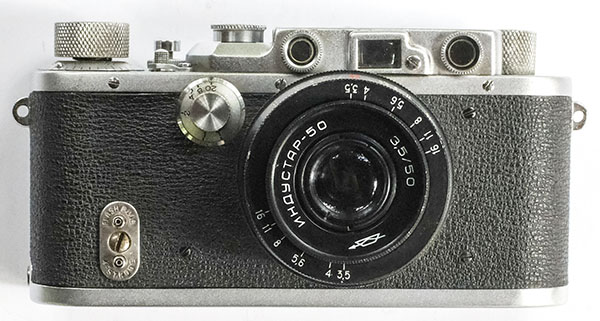
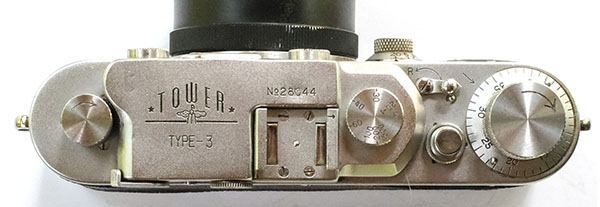
(Images courtesy of Neal Wellons)
I do think that the Tower Type-3 is the Nicca Type-III A. Both the earliest Nicca Type-III A/B and Tower Type-3 examples are still without the film plane mark but slightly later examples of both have the mark. Pictured below is an early Tower Type-3 without flash sync and without film plane mark (as is the sync equipped model above):
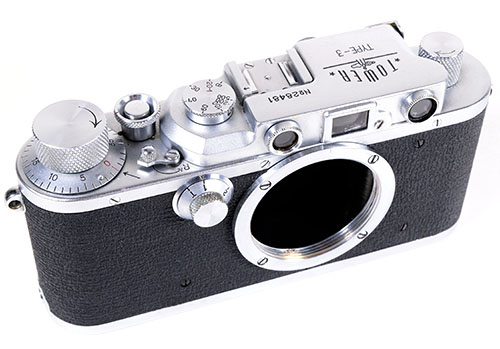 (Image courtesy of Chris Whelan)
(Image courtesy of Chris Whelan)
And a slightly later one with the film plane mark (Nicca Type-III A/B examples further above):
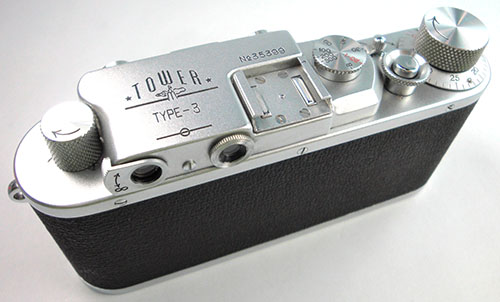 (Image courtesy of Chris Whelan)
(Image courtesy of Chris Whelan)
Next is a Tower Type-3S (engraved as that). It has typical Nicca PC flash sync sockets but with labelling, as also found on some Nicca Type-4 examples but not the Type-III S or 3-S. Is it a re-brand of the “Nicca Type-III S” or “Nicca 3-S”? The serial numbers (5026x and 5124x, only three found) suggest early III-S, confirmed by the 1/20 speed separation and lack of film type reminder on the film winding knob.
 (Detail from larger web image)
(Detail from larger web image)
The next seven Towers still have similar serial numbers (5157x to 7419x, ranging from low Nicca Type-III S like to high Nicca 3-S like) and the same sync socket labelling but are now different. There is no longer a model name engraved (as for all subsequent examples) and they now have the 1/25 speed separation and a film type reminder first seen on the Nicca 3-S, except different, being the film type only version usually found on the later Type-5/3-F whereas the Nicca 3-S also features ASA film speeds. Nevertheless, these Tower examples are almost certainly Nicca 3-S based.
 (Detail from larger web image)
(Detail from larger web image)
By process of elimination, they may be the Tower 42. Most sources mention both the Tower 42 and 43 and the year 1954. It's possible that like the Tower 45 and 46, one is the f/2 version and the other is the f/1.4. Also, I don't know if there is a Tower version of the Nicca Type 4 (that was released in 1953, i.e. it followed the Nicca Type III-S, not the 3-S).
Part of the way through production, the Nicca 3-S shutter crate was fitted with a plate with film loading and flash sync guidance (see further above). Starting with the Tower Type-3S (i.e., equivalent to Nicca Type-III S), both it and what I think is the Tower 42, instead received more detailed film loading instructions on adhesive labels split between the bottom of the shutter crate and inside of the bottom plate:
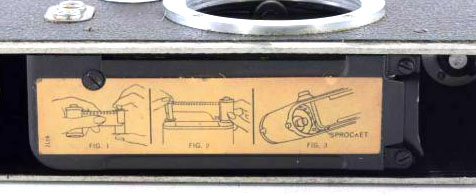
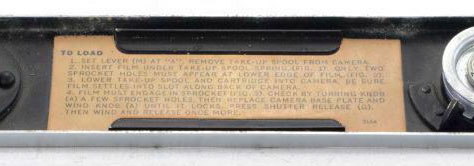
(Detail from larger web images)
There are Tower versions of the Nicca Type-5, one example found (serial number 7471x), and knob wind Nicca 3-F, two examples found (serial numbers 7445x and 7488x). The Tower model names are unknown. Although I have seen the Type-5 based model referred to as the “Tower 5”, that model name seems to officially belong to a Bilora made 127 camera. Strangely, the two Nicca based models, probably from a similar time, seem to share serial numbers. The Type-5 based camera:


(Details from larger web images)
One of the two 3-F based cameras:

(Detail from larger web image)
The next Tower examples in my database (found serial numbers 15021x to 15199x) are Nicca 5-L based:
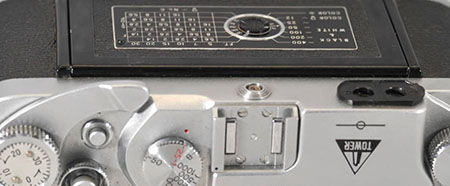
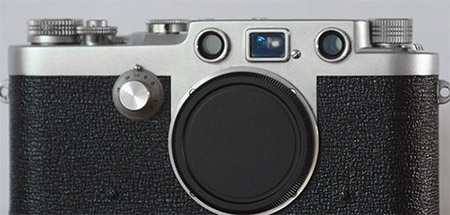
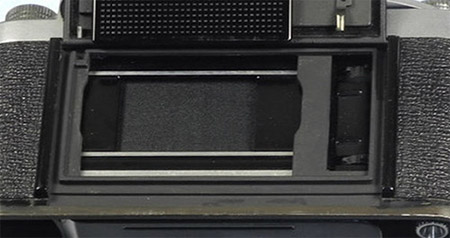 (Details from larger web images)
(Details from larger web images)
The Tower 45 is fitted with the f/2 Nikkor lens and the Tower 46 features the f/1.4, confirmed by the Sears user manual. In fact, there are two user manuals. The Sears user manual is heavily branded “Tower” and not typical of Nicca manuals, being more of a narrative style. It is in an unusual portrait format shared with the Tower Type 3 manual and is marked “Copyright 1957 Sears, Roebuck and Co.”, as expected. The model used for illustrating certain settings/functions is Caucasian. Then there is another manual which is much more typically Nicca with the models used being Japanese. The camera name inside is simply “Tower Camera”. On the plain white cover is “Directions for Using TOWER 35 Camera Model 5-L”, no mention of 45 or 46. It did occur to me that maybe someone just replaced the cover on an English language Nicca 5-L manual but “Tower Camera” appears at least three times inside and is a perfect match to surrounding text. So there seems to be both a Nicca produced manual, undoubtedly a slightly modified but otherwise standard Nicca 5-L item, and a Sears one and both are completely different to each other. An apparently intact Tower 45 outfit, except for box, was offered for sale with both manuals, perhaps both were also provided originally? Both manuals are available for download from the Mike Butkus OrphanCameras.com site.
As discussed in Nicca 5-L, it also seems very likely that the Tower 45/46 pair was released significantly earlier in the US than the other two variants were in Japan and elsewhere.
There is also the lever wind version of the 3-F which is called the Tower 48 (found serial numbers 5005x to 5117x). In the reverse of the Tower 45/46 release process, lens serial numbers suggest that this was released much later in the US than the 3-F in Japan, most likely in late 1957. The image below is from the well known Ian Norris “Leica Copies” website, now unfortunately defunct but with much stuff still available through the Wayback Machine:
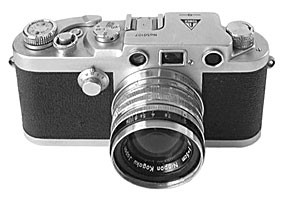
(Note, no diopter adjustment, the only way to tell tell the 45/46 from the 48 in front view)
In confirming the name, he has identified it from the user manual, cover shown on his site, “Directions for Using 48 TOWER 35mm CAMERA with NIKKOR f:2 lens”, with the Sears Roebuck name below that. The size and plain white cover are similar to the plain Tower 45/46 manual. Both Tower 45/46 and Tower 48 manual covers are shown in User Manual Covers, the 48 cover belonging to a similar manual sold by KEH .
No Tower versions of the Nicca Type-33 have been found and it seems likely that this budget model was skipped. However, there is a Tower version of the III-L. I have only seen two examples, the first with serial number 182383 on Massimo Bertacchi's “Innovative Cameras” website and the second for auction with close serial number 182445. Although referred to by some as Tower III-L, I haven't been able to confirm whether that name was official or not but the “Nicca III-L” label is still there on the bottom of the shutter crate. It would certainly not be a typical Tower model name. The top of the black viewfinder housing is engraved “Tower” without the usual logo but also unusually for a Tower model, the back of the top plate is engraved with the maker name, “NICCA CAMERA CO., LTD.”, the same as the Nicca named variant:
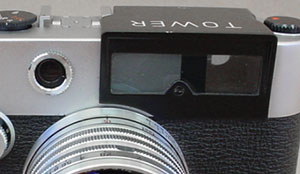 (Detail from Massimo Bertacchi's website)
(Detail from Massimo Bertacchi's website)
I have seen no Sears Roebuck advertising or catalogues that refer to this variant, things probably changed very quickly with the Yashica acquisition.
Tower Models & Serial Numbers Table
This table summarises the Tower models, found serial numbers and their Nicca equivalents but to understand it, it is recommended that the narrative in the preceding section be read first:
Tower Model |
Engraved Name |
Serial Numbers |
Equivalent Nicca Model |
|
From |
To |
|||
| Tower Type-3 | Tower Type-3 | 2598x | 3780x | Nicca Type-III A/B |
| Tower Type-3S | Tower Type-3S | 5026x | 5124x | Nicca Type-III S |
| Tower 42 (1954) | Tower | 5157x | 7419x | Nicca 3-S f/2? |
| Tower 43 (1954) | Tower | same as 42 | same as 42 | Nicca 3-S f/1.4? |
| Tower ? | Tower | 7471x | Nicca Type-5 | |
| Tower ? | Tower | 7445x | 7488x | Nicca 3-F (knob) |
| Tower 45 | Tower | 15021x | 15199x | Nicca 5-L f/2 |
| Tower 46 | Tower | same as 45 | same as 45 | Nicca 5-L f/1.4 |
| Tower 48 | Tower | 5005x | 5117x | Nicca 3-F (lever) |
| Tower ? | Tower | 18238x | 18244x | Nicca III-L |
Tower Type-3 Flash Sockets
As noted further above, the Tower Type-3 flash sockets are surface mounted PC coaxial types and no doubt are an after market installation carried out in the USA on behalf of Sears. The Nicca body that formed the basis of the Tower Type-3 was almost certainly the Nicca Type-III A.
The Japanese domestic market (and anywhere else the Nicca may have been sold) was offered a flash sync'd version of the III A called the Type-III B. However the twin sync posts of this model perform the function of a single coaxial socket and are FP (flash bulbs for focal plane shutters) sync only, probably all that was needed for the Japanese market, whereas I suspect that the US market was already experiencing interest in electronic flash and Sears was keen to add this functionality, or it could have been as simple as the type of connector used on most Sears flashguns.
Flash sync is not shown or mentioned in the relevant Tower user manuals I have seen but I suspect that separate instructions were issued, perhaps by the installer.
As noted in Nicca Type-III A & Type-III B, a fair way into its lifecycle, the Nicca Type-III A and almost certainly the III B from the beginning, received a full length cover for the bottom of the shutter crate. The purpose was to safely cover the Nicca Type-III B's new flash sync mechanism. Instead, the flash socket equipped Tower Type-3 received a different partial cover. They look like this (note, the image is upside down compared to the earlier photos so that the warning is readable):
 (Detail from larger web image)
(Detail from larger web image)
These are the flash instructions on the bottom plate, they refer only to using flash bulbs, not electronic flash:
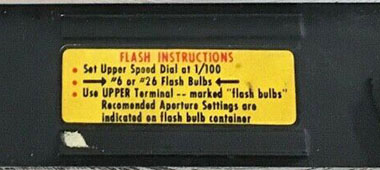 (Detail from larger web image)
(Detail from larger web image)
A Canon II B (circa 1949) that was for sale on eBay in the US is the proverbial “smoking gun” that explains everything. Below left are the Tower Type-III's sockets and on the right, the Canon's, and below those are the Canon's shutter crate cover and bottom plate instructions:



 (Web images)
(Web images)
The Canon II B was never factory fitted with flash sync and later bottom loaders used a side rail with hot sync in any case. Clearly, the sockets on the Tower and this Canon are identical as is the cover plate on the shutter crate. The bottom plate instructions are different but similar and the wording is near identical. Whilst neither mention X sync, the Canon came with an instruction sheet for both flash bulbs and X sync issued by International Camera Corporation of Chicago, Illinois, same name as on its bottom plate.
International Camera Corp. is a well known camera service facility that has been an authorised service agent for most of the major camera brands. It was established in 1949 and was initially associated with manufacturing Perfex cameras, but that is another story. They still, or at least until the last few years, exist/existed as simply International Camera, a much smaller operation. As both International Camera Corp. and Sears were located in Chicago, the connection makes sense.
Sears Supplied Lenses
As far as I can make out, the standard lenses offered on the Tower models were either f/2 or f/1.4 5 cm Nikkors throughout (i.e., neither version of the Nikkor f/3.5 seems to have been offered). The Tower Type III user manual (camera engraved “Type-3”) covers both collapsible and the more “recent” rigid versions of the f/2.
Peter Dechert tells us that the cameras “were sold by Sears in conjunction with Tower-marked accessory sets of German Steinheil 35 mm, 90 mm and 135 mm optical equipment.” That's really not very accurate. The early Type III user manual only mentions Nikkor accessory lenses. The Type 45/46 user manual does indeed only feature the Steinheil lenses but the short telephoto is a 85 mm, not 90 mm. Both early and late Sears catalogues continue to feature Nikkor accessory lenses for the “Tower 35” on a separate lenses page. However, whilst earlier catalogues up to 1958 do also offer the Steinheils as budget alternatives to the Nikkors on the lenses page and also as part of a discounted kit on the main “Tower 35” page, the 1959 catalogue replaces the Steinheils with Japanese made Kyoei Optical Co., Ltd. 35 mm, 105 mm and 135 mm lenses as the budget options (35 mm branded “W. Acall” and telephotos “Super-Acall”). The 135 mm version was also rebranded “Super Yashinon” for sale by Yashica with the YE and YF.
Below is the lenses page (page 7) from the Sears 1957 catalogue with the Steinheil lenses identified in the the top half and a limited range of Nikkors listed in the bottom half. This was fairly typical of most of the catalogues:
.jpg) Click on page for larger version)
Click on page for larger version)
The Steinheil lenses, branded “Steinheil München” (Steinheil Munich), were the f/4.5 35 mm Orthostigmat, f/2.8 85 mm Culminar and f/4.5 135 mm Culminar. Peter Dechert says that the lenses were “Tower-marked”. I don't know if all sold by Sears had the mark or not. Below is the only LTM lens I have seen with the mark (I have also seen a couple of M37 Asahiflex mount “Tower” examples). This example is the 135mm Culminar with discreet Tower logo near the base:
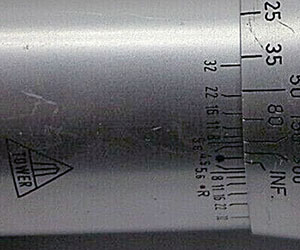 (Detail from larger web image)
(Detail from larger web image)
It was complete with leather case, “Steinheil” end cap and silver “Tower” front cap.
K.O.L./Sun Xebec Lenses
As noted earlier, the original standard Nippon lens was the “K.O.L. Xebec” f/2 5 cm collapsible. It was made exclusively for the Nippon by Kajiro Kōgaku Kenkyūjo (Kajiro Optical Laboratory, i.e. K.O.L.) founded in 1939 by namesake Hitoshi Kajiro. The company became Gojō Kōki Seisakusho in 1941 and ceased activity in 1945. It then reformed as Sun Kōki and the lens was re-branded as “Sun Xebec” (Camera-wiki.org). Both lenses are rare, the “Sun” version especially so:
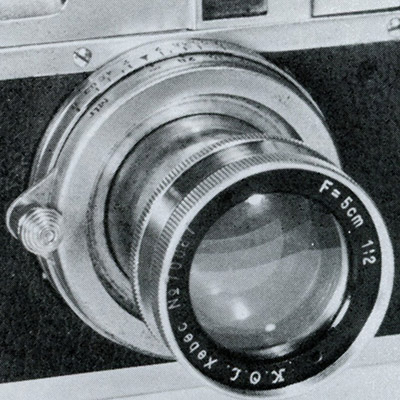

(Images from Mikio Awano's articles in Camera Collectors' News, left detail from July 1978, right detail from August 1978)
This Sun Xebec example was for sale on a non-Nippon/Nicca body:
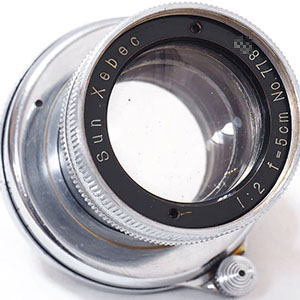
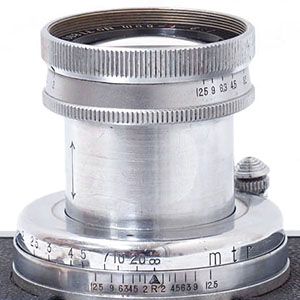
(Detail from larger web images)
Both Camera-wiki.org and a Japanese research paper, “The Development of the 35mm Precision Camera in Japan in the 1930s and 1940s” by Ryosuke Mori (Graduate School of Ritsumeikan University), tell us that the Xebec lens is a 6 element Gaussian type like the Leitz Summar it is based on. The aperture ring is marked f/2 to f/9 on the K.O.L. version and to f/12.5 on one Sun lens.
Camera-wiki.org notes that the finish of an early K.O.L. version appears to be poor. According to Ryosuke Mori, an earlier assessment of a Xebec lens based on its in-use photographic results found it to be noticeably inferior to the Leitz original, however, a later assessment based on controlled tests of its optical capabilities found it to be a much better performer and close to the Leitz original, particularly surprising as the right type of optical glass was difficult to source in Japan during War-time and was largely compensated for by design tweaks. However, the overall performance remained inferior because of it's aperture design and focusing shortcomings caused by poor machining and/or wear and/or the quality of the materials chosen.
The Sun Xebec was replaced by the Sun Sophia f/2 5 cm collapsible lens which has a somewhat similar physical appearance but is more developed and further refined and perhaps features a different optical design suggested by the different front elements. It's not known whether it was offered on a Nippon or Nicca camera but if it was, it would probably be from 1948 or thereabouts. Camera-wiki.org tells us that lens number 72715 has been found mounted on Peerless Type-3 camera 24001. I am aware of two other Peerless cameras, one without lens, the other, 24058, with Sun Sophia. Pacific Rim Camera claims that the small batch of Peerless cameras were all fitted with the Sun Sophia. These cameras are likely to be from early 1949 and in my database are surrounded by Nicca Type-3s with Nikkor lenses already. It is likely that there was a special arrangement with Peerless to achieve a particular price point.
Nicca Lenses
There are two Nicca branded lenses, both almost certainly not made by Nicca. The more recent f/2.8 50 mm packaged with the Type 33 is more familiar. What is known about it is covered in the Nicca Type 33 model and on the Yashica YE & YF page.
The other is the earlier Leitz Elmar inspired f/3.5 5 cm collapsible of which there are 8 in my database but none found with a camera to provide a clue as to when, or what model, the lens is from. The serial numbers are all “86” prefixed and run from 8675x to 8685x - not a big range so far, just over 100. It's coated so post-War and and the “Nicca-L.C” and “Nicca-Camera Tokyo” narrow it down to late 1948 or later. It looks very similar to the Nikkor f/3.5 collapsible but there are also some small subtle physical differences between the two lenses. It also looks similar to the same spec and vintage Canon Serenar, which is not surprising as the Serenar is said to be based on the Nikkor:
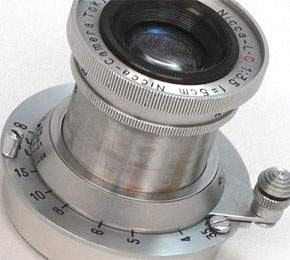
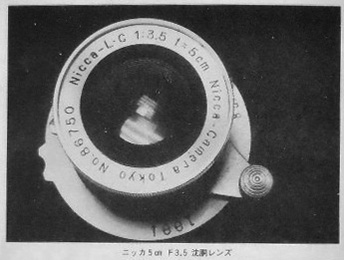
(Left detail from larger web image, right is Camera Collectors' News, December 1995 edition)
Some sites/sources mention the lens, most don't, but none have any real ideas about its origins, age or other history. A normally reliable source, Japanese magazine, Camera Collectors' News, December 1995 edition, features the lens but doesn't really add much to our substantive knowledge. It remarks on the Nikkor/Serenar look and tells us it is a copy of the Nikkor f/3.5 5 cm fitted to the 1948 Nicca Original and was intended to replace it but for some reason, the translation tells us it was “postponed”, probably abandoned would be more accurate. It also suggests that production occurred somewhere between 1949 and 1953 and discusses possible links between some of the Leica copy makers without reaching a useful conclusion.
As noted earlier, ads confirm that Nicca distributor Hinomaruya came on board in 1950 and took on distributorship of Nikkor LTM lenses in 1951. I doubt that the Nicca lens would have been attempted after that time. So perhaps a 1949 to 1951 possible production window?
However, the magazine offers one valuable insight. Whilst it shares the look and full size aperture ring of the Nikkor, Serenar and several other Tessar based f/3.5 5cm collapsibles, it's actually a Leitz Elmar based optical design (claimed to be either a 4 element modified Cooke Triplet formula, or a patent circumventing modified Tessar, with the aperture diaphragm between the first and second elements). Photographs seem to bear that out:
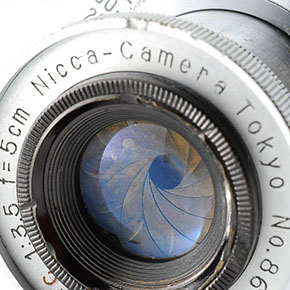 (Detail from larger web image)
(Detail from larger web image)
Nikkor Lenses
Standard Lenses
(The five main resources I have used for this section are Roland's website featuring Nikkor lens serial numbers, the article “50/1.5 Nikkor” by Robert J. Rotoloni in the Nikon Historical Society Journal NHS-27 of March 1990, sponsored by Pacific Rim Camera, the official Nikon history site, the lenses documented in my database and Nicca documents in the form of user manuals, ads and brochures.)
Following the K.O.L./Sun Xebec f/2 5 cm collapsible lenses fitted to the War-time Nippons and probably most post-War examples too, the standard fitment for the early Niccas was the Nikkor f/3.5 5 cm collapsible. This was a copy of the Zeiss Tessar, although it is claimed that the Japanese Imperial Navy had paid to legally licence the design. Whilst Sugiyama displays a 1947 Nippon with the Sun version of the Xebec and there is a 1948 Nippon in my database with one, the Nikkors first started appearing on Nippons as early as on a 1944 example. These are almost all certainly post-War replacements, Nikon tells us that production of the LTM version of the f/3.5 5 cm was “recommended” in December 1945 so the first probably appeared in early 1946 and likely would not have been originally offered on any Nippon body until the camera was renamed “Nicca”.
According to Nikon, the origins of the f/3.5 and subsequent f/2 LTM lenses date back to 1935 designs for the Hansa Canon and the optical design for the later f/1.5 was completed in 1942 and was first used for X-ray radiography.
Collapsible Nikkor f/3.5 5 cm on left and subsequently released collapsible f/2 5 cm on right:
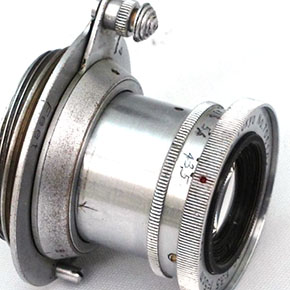

(Detail from larger web images)
Until 1944, all the Nikkor 5 cm lenses (but not most X-Ray Regno-Nikkors) were prefixed “50” signifying the focal length in millimetres. Starting in 1944, a new date coded system was introduced with the first digit signifying the year of the decade and the second signifying the month. Lenses were generally made in batches, with the small number of Canon cameras (the only customer until at least 1946) being made at that time, there might only be one batch of lenses in the year. My Canon database for f/3.5 Nikkors contains “46”, “57” and “610” numbers; 1944 June, 1945 July and 1946 October, respectively, the same pattern as in Peter Dechert's book, Canon Rangefinder Cameras 1933-1968. With the possible exception of the 1946 lenses, these were likely to be in Canon “J” mount, a coarser thread than LTM. Starting in 1947, May at the latest, Nippon Kogaku introduced a three digit prefix with a two digit month code, e.g., “705” translating to 1947 May. It appears that the year 1950 used both a two digit year and two digit month and was the last year a date code was used.
The date code raises another mystery. In my database are three 1944 Nippons fitted with 5 cm f/3.5 Nikkors with “57” prefix numbers (57044x, 57075x and 57110x). These seem to be a July 1945 batch - whilst they were almost certainly not originally supplied with a Nippon, that makes them earlier than the first LTM versions of the lens (1946). The two slightly later lenses, 57075x and 57110x are marked “Q.C” (also both with the “Tokyo” marking), the “C” indicating that the lens is coated, something Nippon Kogaku claims to have introduced in April 1946 (see further below). There is a still earlier pre-date coded Nikon, 5051x, mounted to a 1943 Nippon. Based on Nippon Kogaku's own timeline advice, these lenses presumably must have been made in Canon J mount (unlikely to have been in bayonet without helical for Canon S) and later converted to LTM, or may be later made than the date code seems to indicate, or something else. Clearly, something doesn't add up somewhere.
By the Nicca Type-3, not only does the first Nikkor f/2 5 cm lens in collapsible mount appear in my database, it has virtually replaced the collapsible f/3.5, although both still appear in an early Type-3 ad. According to Nikon, planning for production of the collapsible f/2 LTM lens commenced in 1946 with release occurring in 1947. This was a 6 element lens based on the Zeiss Sonnar design and in those early days of coated optics, it had performance advantages over the more complex double-Gauss based Planar and Xenon/Xenotar designs which, with improved coatings, came to the fore later. The earliest example in my database has a 6 digit serial number beginning with “806”, the others are 7 digit beginning with “811”. These lenses are likely to have been produced in June 1948 and November 1948 respectively.
Cameras made from early 1947 onward during the post-War Allied occupation of Japan were marked “Made in Occupied Japan” (MIOJ). This requirement ended at the end of 1949 but the practice may have continued until 1951, see Made in Occupied Japan & Other Markings. As I noted in the linked section, I am yet to see any lenses marked the same way on the body (50 mm lenses were sold with cameras and, e.g., Canon Serenar accessory lens rear lens caps and cases were marked MIOJ) but Nikkor lenses made in the occupation period used the maker name “Nippon Kogaku Tokyo”, afterwards in early 1951 (based on serial numbers fitted to Niccas) it changed to “Nippon Kogaku Japan”. It is said that most “Tokyo” lenses don't feature aperture click stops and the minimum apertures sizes tend to be larger than later, obviously not related to the marking, just the time period, and I suspect a sweeping generalisation, e.g. all examples of the f/2 5 cm Nikkors, i.e. the first “Tokyo” marked collapsible, early “Tokyo” marked rigid and “Japan” marked rigid feature a full range of f-stops from f/2 to f/16. Although the first large aperture f/1.5 lens only goes down to f/11, both the “Tokyo” and “Japan” marked f/1.4s go to f/16. Below is Mark Cunningham's early f/1.4 with “Tokyo” marking to match the MIOJ of his early Type-III A body. He has confirmed that it features click stops:
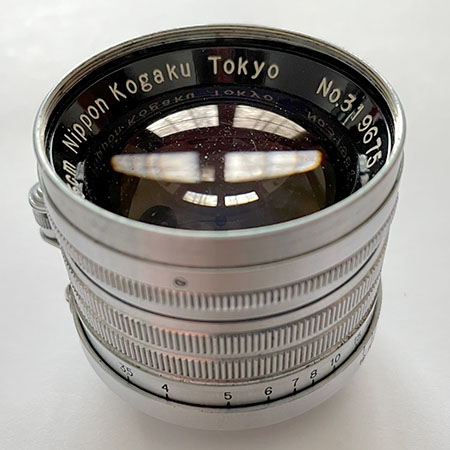 (Image courtesy of Mark Cunningham)
(Image courtesy of Mark Cunningham)
According to Nikon, the large aperture f/1.5 version of the Sonnar design was released in January 1950 and was available in both Nikon S mount and in smaller numbers, in LTM, and was replaced in July 1950 already by an improved f/1.4 version. However, there are two serial number ranges with serial numbers commencing with “905” and “907” (i.e., two batches made) and if the date code theory is to be believed, these are from May and July 1949 respectively. Obviously, either Nikon has got its own history wrong, the date code doesn't work, or the lenses were made 6 months prior to release - I don't know enough to have a view.
Both the f/1.5 and f/1.4 lenses are 7 element types but of different mechanical and optical design. The f/1.5 is unusual in that it stops down to f/11 only and has a 40.5 mm filter mount like the f/2 rather than the 43 mm of the f/1.4. In its very short life, there was a minor lettering style change on the beauty ring and the serrated filter mount ring became plain. It is reputed to be quite rare and my database contains just one example, 90771x found with almost certainly matching Nicca Type-3, serial number 2687x. The f/1.5 is featured in the “Nicca Mod III” (Nicca Type-3) ad below and a Japanese catalogue from 1951 (perhaps the information hadn't been updated yet) notes availability of f/1.5, f/2 and f/3.5 standard lenses:
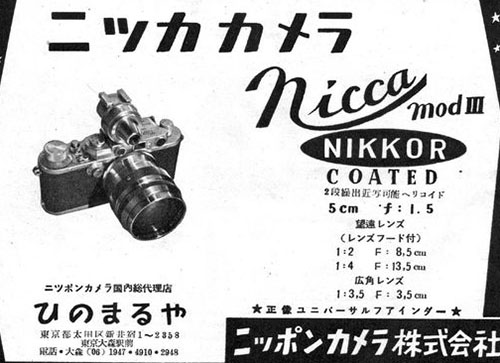 (Detail from larger web image)
(Detail from larger web image)
According to my database, the f/1.4 started appearing on Tower Type-3 and Nicca Type-III A & B examples from 1950. It was joined by a rigid version of the f/2 which replaced the collapsible version completely. The combined Nicca Type-III A and Type-III S user manual displays three “standard 50mm lens”, the rigid f/3.5 and f/2 and the f/1.4 but the rigid f/3.5 seemed to be not very popular with only relatively low numbers in my database found on Type-III A, Type-III S and 3-S models. I'm not sure when this lens ceased being offered but it certainly doesn't appear in the two 3-F user manuals and seems to be missing in the earlier combined 3-S/Type-4 user manual, although in a later combined Nicca 3-S and Type-5 brochure, it is listed as an option for what is now the budget 3-S but not Type-5.
All Nikkor f/3.5 lenses originally fitted to Niccas, both earlier collapsible and later rigid, were marked “Q.C”. The rigid f/3.5 features a 34.5 mm filter size but probably also takes 36 mm push-on types:
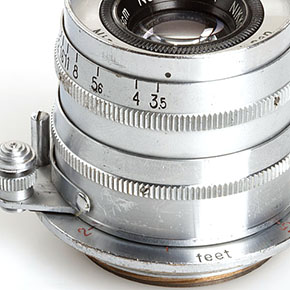 (Detail from larger web image)
(Detail from larger web image)
Incidentally, the early Nikkor lenses are marked with letters such as “Q.C”, “H.C” and “S.C”, depending on lens type. The first letter indicates the number of elements. The Nikkor codes are:
| Letter | Representing | No. of Elements |
|---|---|---|
T |
Tres | 3 |
Q |
Quattuor | 4 |
P |
Pente | 5 |
H |
Hex | 6 |
S |
Septem | 7 |
O |
Octo | 8 |
N |
Novem | 9 |
The red “C” stands for “coated”. There are claims that coating of Nikkor lenses was introduced in 1945, Nikon says April 1946 for the f/3.5 5 cm. As all competing lenses became coated, the identification became superfluous and the “C” was dropped in 1957.
With reference to the coatings, the Tower Type III user manual (“Type-3” engraved camera from about 1950) notes:
“All Nikkor lenses are coated on the inside only. It is believed the coating of inside surface only will help prevent scratches. It is evident that if the the front element or outside of the lens were coated, this coating would be more subject to scratches than the hard, uncoated
outside surface.”
The Nikon history site clarifies this with:
“In April 1946, a soft optical coating was applied to the NIKKOR 5cm f/3.5; i.e., to the surfaces of the lenses inside the lens barrel....
In the beginning, a soft coating of cryolite was used, then as of January 1948 magnesium fluoride was used and further improvement was added as of September 1950; i.e., the anti-reflection coating was changed to a hard coating.”
The only applicable Nikkor lens with 9 elements is the Nikkor-N.C f/1.1 5 cm released in early 1956. Extremely rare in LTM mount, one site says about 100 made, another claims about 200, so probably eye wateringly expensive and marketed to Leica wielding professionals. Not surprisingly, it is not featured in the usual Nicca manuals (that I have seen) or ads but it does appear in the text and as a schematic in the Japanese Nicca book, first published on 15 April 1956, which sometimes came with the Nicca Type-5 (see also User Manuals below, lens schematic and details on page 159 of the first edition but on page 68 of my 1957 printing):
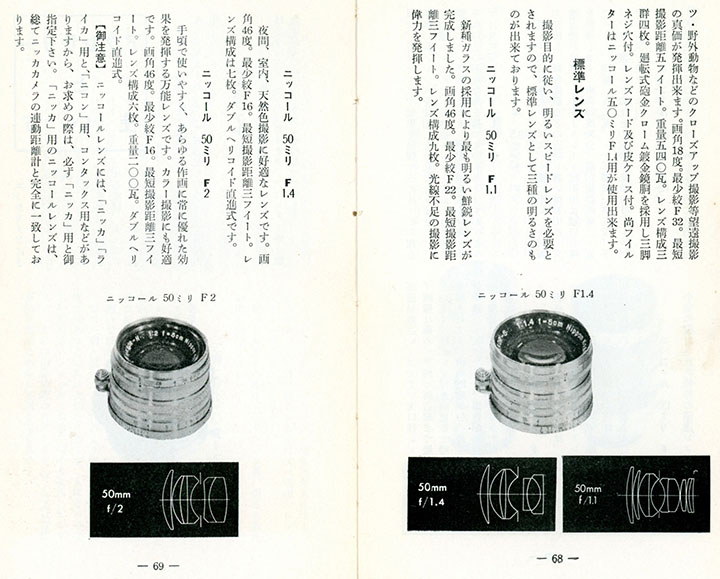
The number of f/1.4 examples found with Nicca/Tower cameras in the present day is relatively low but many could have been removed. From the few examples in my database, the f/1.4 didn't seem to change much from its introduction until Nicca's demise. Featuring 7 elements, it was marked “S.C”, as was its predecessor, the f/1.5. Although there appears to have been an initial batch made in May 1950 with serial numbers beginning with “5005”, all serial numbers of examples supplied with Niccas in my database begin with “3” (the first in my database is 321xxx). The Japanese user manual for the lever wind 3-F has one typical all chrome example, serial number 346786 but two later examples in the manual, serial numbers 347138 and 350288, feature the black aperture ring like the later f/2 version. Below is the second of the lenses together with schematics of both the f/1.4 and f/2 lenses:
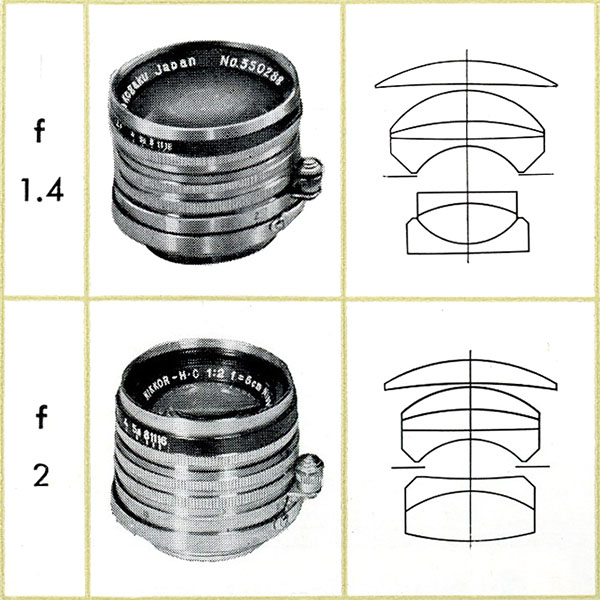
A Tower version of the III-L camera has an f/1.4 lens with serial number 34883x, i.e. in between the other two, which is still all chrome like the earlier ones, but two late lenses, serial numbers 38811x and 38908x, on Tower 46 (Nicca 5L) cameras have the black aperture ring. They are the only ones I have seen in the wild. The serial numbers are unexpectedly high for that model and it is possible that there was a numbering change.
In photos, the only differences between the earlier all chrome version and the later black aperture ring version that I can discern are that like with the f/2 lens, as noted below, the infinity mark changed from the earlier “INF.” to the infinity symbol and the focusing scale increased granularity by adding 9, 12, 20 and 30 feet whilst dropping 25 feet.
Note that the 40.5 mm filter mount of the f/2 and f/1.5 and the 43 mm mount of the f/1.4 all use a 0.5 mm thread pitch, however, whereas modern 40.5 mm filters still use this thread pitch, 43 mm filters now use a 0.75 mm thread pitch making the f/1.4 lens a problem in this regard.
Rigid Nikkor f/2 5 cm Lenses
The rigid f/2 lens is the most ubiquitous and has the most varied history. I understand that all f/2 variations, including the early collapsible, share the same basic optical design (Nikon has confirmed that the glass type was changed twice early on due to supply shortages, this necessitated some optical design adjustments to compensate). All feature aperture ranges from f/2 to f/16. Initially all were marked “H.C”. The earliest rigid f/2 examples from 1950 had serial numbers beginning with “5008” - there is only one in my database and it belongs to a Type-4 so certainly a later fitment. Then came the first solid block of non-date code serial numbers which seem to start with 61xxxx and end at 65xxxx, 66xxxx according to Roland's website. The last f/2 in my database engraved “Nippon Kogaku Tokyo” is 62135x and the first engraved “Nippon Kogaku Japan” is 62189x. Both are mounted on Nicca Type-III As. Except for screws in the flange noted below, they all physically look the same/similar including the early 8 digit 5008xxxx.
Then there were some minor changes to the barrel, mainly to the nose and tail, and the numbers started off again at 71xxxx. At about 724xxx, there was one very small change but it is very distinctive - the black on chrome aperture scale ring changed to white on black. As the serial numbers neared 750xxx, the now unnecessary “C” for “coated” was dropped from “H.C” and the marking became simply “H”.
All 61xxxx to 66xxxx lenses have a ribbed, flat black rim outside the make-up ring. On all the later lenses, it is plain and slightly dished.
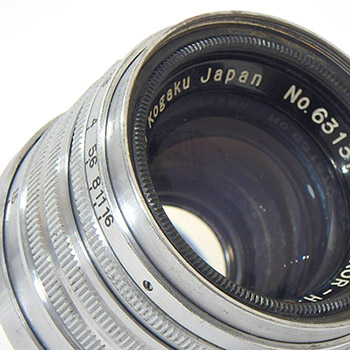 (Detail from larger web image)
(Detail from larger web image)
The very earliest 61xxxx lenses have four screws in the flange, left image, the rest are without. Also 61xxxx to 66xxxx lenses have slots in the rear retainer, left image, whereas 71xxxx to 75xxxx lenses have holes for a pin wrench, right image (both are dark and hard to see):

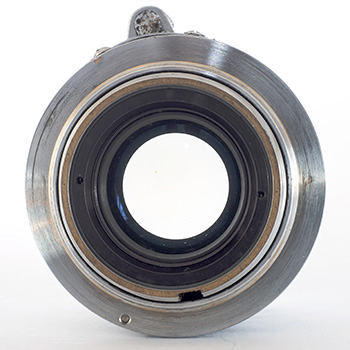
(Left detail from larger web image)
Example of the 71xxxx to 72xxxx lens, the same as later lenses except all chrome still and some differences in focus scale markings (see below):
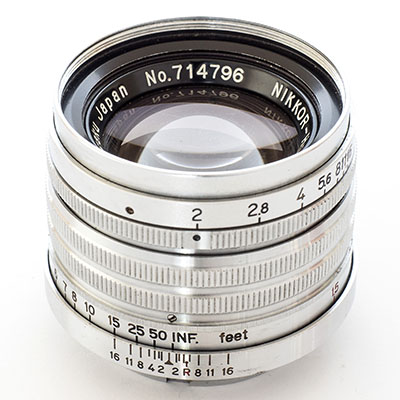
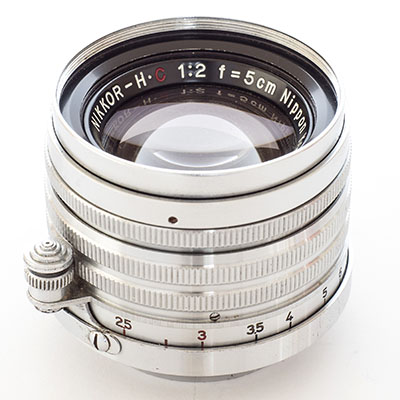
Left image below; the black aperture ring was introduced at about serial number 724xxx. The infinity mark also changed from the earlier “INF.” to the infinity symbol and the focusing scale increased granularity by adding 9, 12, 20 and 30 feet whilst dropping 25 feet. Right image below; in 1957, somewhere around serial number 748xxx, lenses dropped the “C” reference to coating and were simply classified “H” (6 elements) instead of the earlier “H.C”:
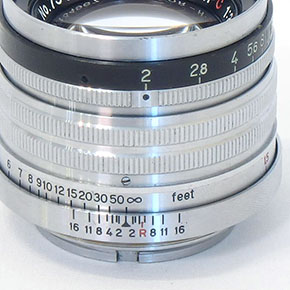
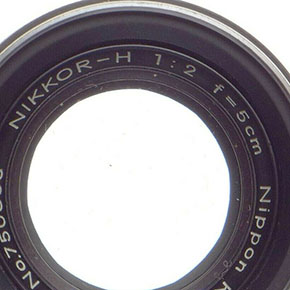
(Detail from larger web images)
Typical found rigid Nikkor f/2 serial number ranges for the different Nicca models:
| Model | Lens Version |
Serial Number Range | |
|---|---|---|---|
From |
To |
||
| Nicca Type-III A/B | Early H-C | 61xxxx | 632xxx |
| Nicca Type-III S | Early H-C | 631xxx | 642xxx |
| Nicca Type-4 | Early H-C | 641xxx | 645xxx |
| Nicca 3-S (early) | Early H-C | 641xxx | 658xxx |
| Nicca 3-S (late) | Chrome H-C | 713xxx | 717xxx |
| Nicca Type-5 (early) | Early H-C | 657xxx | 659xxx |
| Nicca Type-5 | Chrome H-C | 713xxx | 718xxx |
| Nicca Type-5 (late) | Band H-C | 724xxx | 727xxx |
| Nicca 3-F (early) | Chrome H-C | 714xxx | 724xxx |
| Nicca 3-F (late) | Band H-C | 724xxx | 742xxx |
| Nicca 3-F(L) (early) | Band H-C | 742xxx | 747xxx |
| Nicca 3-F(L) (late) | Band H | 750xxx | 755xxx |
| Nicca 3-F (5-L features) | Band H | 750xxx | 759xxx |
| Nicca III-L | Band H | 750xxx | 762xxx |
Note, the lens versions are based on the earlier descriptions.
Close Focusing
The Nikkor f/1.5, f/1.4 and rigid f/2 share the ability to focus down to 1.5 feet (about 457 mm, most/all seem to feature focus scales in feet) however the lenses don't couple to the rangefinder below 3.5 feet so between 1.5 and 3.5 feet, the distance from the subject to the film plane must be measured. (Some people modify the lenses by cutting away a section of the lens mount thread to enable the rangefinder to reach its limit, though still around 2 feet, not 1.5 feet. I'm not a fan, at those distances, you would have to assume that the rangefinder is adjusted perfectly and I don't like the idea of drastically modifying classic equipment for some limited, and often short term, modern convenience need just because you can.)
Wide Angle & Telephoto Lenses
An early ad for the Type-3 lists the Nikkor f/2 8.5 cm and f/4 13.5 cm lenses. Appearing just above the Nicca ad is one for the Nikon rangefinder with the same lenses. A slightly later Type-3 ad adds an f/3.5 3.5 cm wide angle. These three all-chrome lenses appear in the first Type-III A & B ad (the only ad featuring the elusive III B, see further above). Nikon claims that the three lenses were added in 1949. A slightly later Type-III A ad also adds the f/3.5 version of the 13.5 cm lens to the existing f/4 - Nikon says released in December 1950.
By the time of a combined Type-III A and Type-III S ad, the 13.5 cm f/4 has been dropped but the rest of the range expanded to become f/3.5 28 mm, f/2.5 35 mm, f/3.5 35 mm, f/1.5 85mm, f/2 85 mm and f/3.5 135 mm. The combined user manual for the two models doesn't yet list the 28 mm lens or the f/1.5 85 mm.
A Type-5 brochure displays a further expanded range: f/4 25 mm, f/3.5 28 mm, f/3.5 35 mm, f/1.5 85 mm, f/2 85 mm, f/2.5 105 mm and f/3.5 135 mm. Note, the f/1.5 85 mm lens is mainly black and the 105 mm also features a lot of black including a black nose.
The 3-F user manual adds a larger aperture f/2.5 35 mm. The lever wind 3-F user manual doesn't add any more lenses but the earlier chrome f/2 85 mm and f/3.5 135 mm lenses are now black with chrome noses. In summary, the wide angle lenses remain chrome, the telephoto lenses are now predominantly black.
The final III-L system brochure adds one more even larger aperture wide angle f/1.8 35 mm lens to become a range of nine. This was a hero lens for Nikon, in LTM, it is rare with only 1,600 claimed to have been made.
This set, featuring specs, is assembled from the knob wind 3-F user manual, circa 1956:


This similar set, featuring schematics this time, is assembled from the lever wind 3-F user manual, circa 1957, and also displays the updated f/2 85 mm and f/3.5 135 mm lenses:
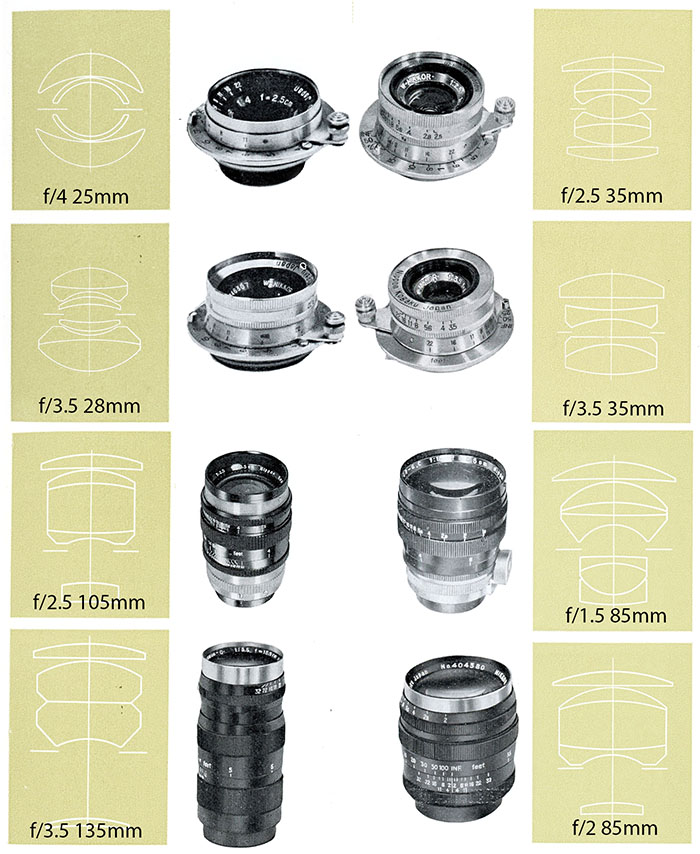
Over time, there were many small, mainly cosmetic, variations in these lenses, particularly the 13.5 cm. The best source for exploring any nuances is Roland's website linked above.
Longer Lenses
The Nicca 3-F lever wind ad further above also lists 180 mm f/2.5, 250 mm f/4 and 500 mm f/5 Nikkor lenses. Although Komura offered a range finder coupled direct mount 200 mm f/4.5 lens, most rangefinder lenses are limited to a practical maximum focal length of 135 mm because of rangefinder accuracy. However, it is possible to focus longer lenses successfully by turning the rangefinder camera into a basic SLR by inserting a reflex housing between the lens and the body. To achieve infinity focus, the lenses need to be specially designed to allow for the longer lens flange distance to the film plane, i.e. they need to have shorter bodies to compensate for the housing depth.
The original reflex housings were offered by Leitz, the Mirror Reflex Housing, code named PLOOT, before the War and various Visoflex models post-War (more here, including a photo of a Visoflex II mounted on a Nicca 3-S). There were also third party housings and Nippon Kōgaku produced its own “Reflex” and improved “Reflex II” housings, both in low numbers, around 200 and 700 respectively are claimed. However, the evidence suggests that the Nippon Kōgaku units were only produced in Nikon S mount and the small number of long focal length Nikkor LTM lenses in relatively low volume overall production were aimed at Leica owners who, it was probably assumed, would have preferred the native Leitz housings.
Unless there is something I have missed, I think that the distributor for Nicca and Nikkor LTM lenses, Hinomaruya, was a little mischievous in advertising lenses for Nicca that would require the customer to source their own reflex housing. Not all the ad is translatable but I see no reference to a housing of any brand. There is also at least one Melcon ad where Hinomaruya listed all Nikkors up to 500 mm.
In practical use, some reflex housings like the Leitz Visoflex II may be difficult to adapt because of the lever connection to the shutter button. The Canon Mirror Box II not only has a lever, it is only designed to fit the external bayonet mount on Canon 7 models. Earlier housings like the Leitz PLOOT, Visoflex I and original Canon Mirror Box use twin cables, one to the shutter button and the other to the mirror mechanism and should be a simple mount. Third party devices are presumably more universal.
Shutter Speeds
The basic operation of Leica screw mount type cameras, including using the slow and high speed shutter dials, is covered on the Yashica YE & YF page. Note, all the new body Niccas, except the Type 33, include a separate high speed shutter dial index mark (if the main mark is at 9 o'clock, the second mark is at approximately 7 o'clock) for setting the shutter speed before cocking, although this is not recommended by the user manuals. However it does let you know what shutter speed has been set. The reason for the separate slow speed dial is that it controls a separate escapement which introduces a time delay to curtain travel e.g., the Leica II featured shutter speeds from 1/20 to 1/500, the Leica III slow speeds added 1 to 1/8. Leicas and Leica copies sought to simplify dial setting so in most cases, you will find “20” on the slow speeds dial and “20-1” on the high speeds dial, or “25” and “25-1” or “30” and “30” (Nicca Type 33) or “30” and “30-X” (Nicca III-L) so if you want to set speeds of 1/20, 1/25 or 1/30 respectively, both dials have to be set to that mark but in reality, those speeds belong to the high speeds and are not part of the slow speed escapement.
Some sites indicate whether a model has a slow speed shutter dial lock or not. It's really simple. Models based on the early stamped body Leica III don't. The first models based on the late die-cast body do, but the Type 33, III-L and the Yashica pair don't. Quite separately to that, Mikio Awano says that the slow speed shutter dial didn't feature click stops on the Nippon and Original - that feature was introduced with the Type-3.
Over time, there were some evolutionary changes with the speeds and setting practice of the Nicca models. The format used below is <slow speeds> || <high speeds> rather than what is marked on the dial.
Starting with the Nippon, the speed progression was typically Leica III based: T, 1, 1/2, 1/4, 1/8 || Z, 1/20, 1/30, 1/40, 1/60, 1/100, 1/200, 1/500, “Z” being for the German “zeit”, equivalent to “bulb”, or “B”. Most Nicca named models feature “B” but the 1948 Type-3s were still marked “Z”. There was no change in marking but the last Nicca Type-III B in my database and the replacement Type-III S model added X flash sync at 1/20 for the first time (FP sync at all speeds). The “20-1” (and also later “25-1”, “30” and “30-X”) marking on the main shutter speed dial changed to red towards the end of the Type-3 cameras from serial number 2498x onward (some early cameras still look black in photos, possibly the red overlaid a black base and has worn off, or it is the photo quality, or they are black). With the earlier bodies, the slow speed shutter dial didn't vary much. The Nippons and very first Niccas had a large central retaining screw like the pre-War Leica IIIa and IIIb but this disappeared already in 1948. On left, early Type-3 still with “Z”, on right, Nicca Original slow speed dial:
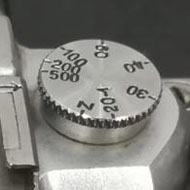
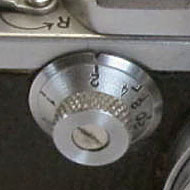
(Detail from larger web images)
Type-III S main dial with “B” and red “20-1” below left. The “20” lock position marking changed to red at the same time as the “20-1” marking on the main dial did. Note that the lock position is at the end of the range:
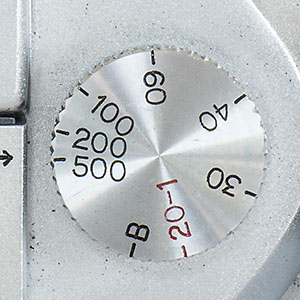
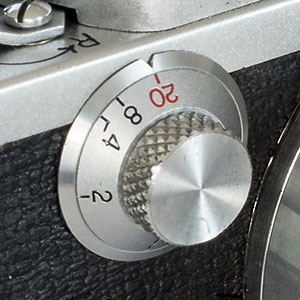
The Nicca Type-4 introduced the first real change in speed progression: T, 1, 1/2, 1/4, 1/8 || B, 1/25, 1/50, 1/75, 1/100, 1/200, 1/500, 1/1000 which was mirrored by the Nicca 3-S except for the omission of the 1/1000 at the top end (that change also came to the last two Type-III A examples in my database). The minor change from 1/20 to 1/25 effectively increased the X sync speed to 1/25. Nicca 3-S dials:
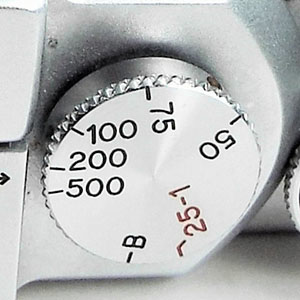
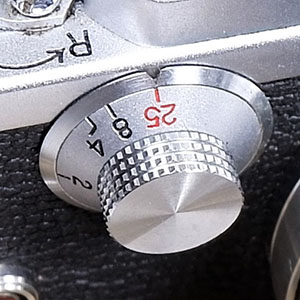
(Images courtesy of Chris Whelan)
Until now, the user manuals tell us that the “20-1” and “25-1” positions on the high speed dials are the “neutral position” (in a Tower manual, Nicca similar) for using the slow speed dial where that range of speeds is found. As noted above, that was more for the perceptual benefit of the user than where the speeds actually reside. This changed with the first new body model, the Nicca Type-5, which copied the shutter setting method from its Leica IIIc/IIIf inspiration. The lock setting was now in the middle of the speed range on the front slow speed dial, i.e. the Type-5 slow speed dial is now marked: T, 1, 2, 5, 25, 15, 10. So to use 1/25 for example, the manuals now instruct to put the front dial into the lock position and the speed is set on the main dial using 25-1. In practical terms there is no difference, it's really whether 1/25 is perceived as a slow speed or fast speed but it's set the same way.
In the process of the change, the Type-5 speed progression became: T, 1, 1/2, 1/5, 1/10, 1/15 || B, 1/25, 1/50, 1/100, 1/200, 1/500, 1/1000. With the little bit of fiddling, it added 1/15 to the slow speeds but dropped 1/75 from the main dial. The next variation came with the Nicca 3-F which simply dropped the 1/1000, the central lock position of the Type-5/5-L and 3-F models also shown (the dial now features a Leica-like press button lock for the changeover speed):
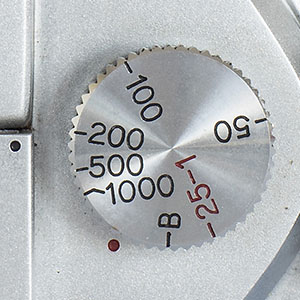

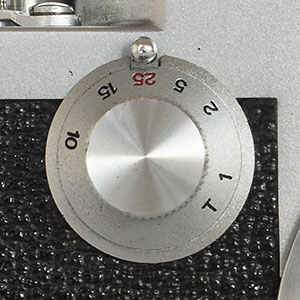
The Nicca Type 33 finally ushered in the linear speeds of the internationally recognised standard progression whilst dropping the T and 1 second speeds: 1/2, 1/4, 1/8, 1/15 || B, 1/30, 1/60, 1/125, 1/250, 1/500. Flash X sync was upped to 1/60 but FP (and M) sync was limited to the slow speeds. :
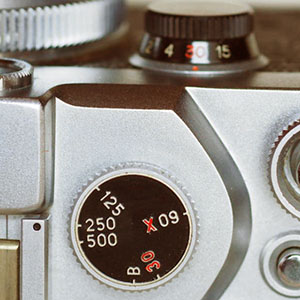 (Detail from larger web image)
(Detail from larger web image)
The high speed dial featured a new style black face whilst the slow speed dial was also a new black design with speeds being more easily visible from above and the dial lock deleted again. Modified versions with silver grip and face were fitted to the III-L and Yashica YE and YF and look surprisingly similar to the 1956 Canon VT and later variants whereas earlier dials are clearly Leica inspired.
The Nicca III-L kept the speed progression but added the bottom and top speeds back whilst dropping the X sync speed to 1/30 but restoring FP sync to the high speeds: T, 1, 1/2, 1/4, 1/8, 1/15 || B, 1/30, 1/60, 1/125, 1/250, 1/500, 1/000. Nicca also followed the Leica IIIg lead of putting the lock position back at the end of speed progression on the the slow speed dial instead of the middle.
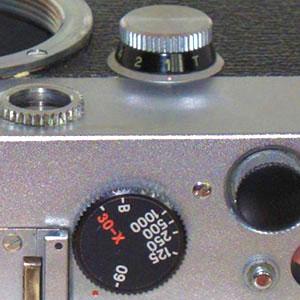 (Detail from larger web image)
(Detail from larger web image)
With the Yashica YE, the X sync speed dropped from the Type 33's 1/60 back to the more mundane 1/30 of the last models but like them, was able to FP sync at all speeds. Instead of the Type 33's black version, Yashica also styled the slow speed dial along the lines of the III-L one including putting the lock position at the end of the slow speed progression. The YF speeds are basically the same as the III-L but it misses out on the “T” time setting. However, its main dial is now two piece with the setting arrow on the inner shaft and speed set with the shutter uncocked or cocked simply being the speed set. Details and examples of the YE and YF here.
Rangefinder
The rangefinders fitted to Nicca models seem to mirror their Leica inspirations but perhaps not all is as it seems. The potential accuracy of a rangefinder and its ease of use (the way it snaps into and out of focus) is determined by its “effective base length” (EBL) which is the physical base length x magnification (the various Barnack Leica III models and most post-War copies are 1.5 times). The Leica IIIf and earlier models featured a base length of 39 mm and an EBL of 58.5 mm. As noted earlier, according to Mikio Awano, the Nippons and Nicca Original used the Leica II magnification of 1x so their EBL = base length. The Nicca Type-3 and later models (except III-L, specs unknown) are 1.5x.
At least two Japanese blog sites state that the EBL of the Yashica YE is 57 mm. The EBL of 57 mm means that the physical base length is 38 mm. It's not easy measuring from centre of window to centre of window but using several methods, I think that the Leica IIIc is spot on at 39 mm and that the YE, the Nicca Type-5, 3-F and the early bodied Type-III S are a fraction less but not a full millimetre. If there is a difference, it's unlikely to have a noticeable impact on accuracy.
Accessories
As Nicca was a relatively small company specialising in Leica copy cameras, it was unlikely that they had the resources to develop or economically manufacture comparatively low volume accessory items and like even a relatively large company such as Yashica, probably sold rebadged items made by speciality firms.
Distributor Hinomaruya seemed to have a part to play too with its name featuring on some lens hoods and later hood cases (see below) and possibly being responsible for sourcing items. As noted earlier, Hinomaruya was also the distributor of Nippon Kōgaku's LTM Nikkor lenses but a surprise is finding Hinomaruya's name on both a Nicca copy stand ad and an ad for a Nikon version of it - see Copy Stands below.
A good source for details of accessories are the user manuals (see further below).
Lens Caps
The Nicca lens caps for the standard 5 cm Nikkor lenses are mostly all similar pre-early 1950s Leica-like silver slip-on with “Nicca” in its traditional Leica-like script embossed across the front. Late f/2 version pictured below left, earlier ones, below right, seem to have harder, more defined edges (see also silver example below these two) and be made of brass, the material of the later ones being unknown but almost certainly the same:
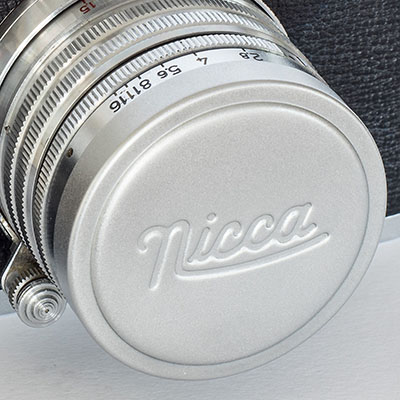
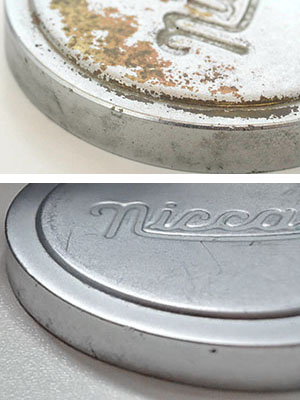
(Right detail from larger web image)
If there was a slight finessing, it occurred at some point in the “7” series lenses, probably later rather than earlier. The lens above left is has a “71” prefix whilst its lens cap originally belonged to a lens with “75” prefix.
Rather than silver, the final Nicca III-L model features a black lens cap with the name in block capitals to match the name on the camera:
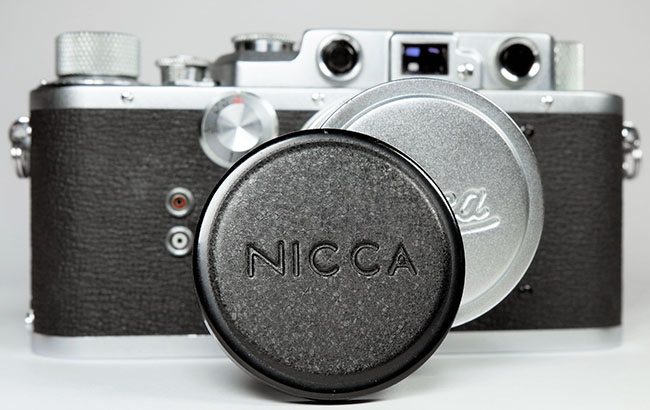
(Image courtesy of Chris Whelan)
It also is made of brass:
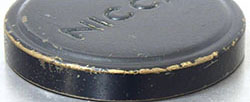 (Detail from larger web image)
(Detail from larger web image)
Chris Whelan has weighed his two f/2 caps at 12 grams for the black version and 10 grams for the earlier silver. My very late silver example is also 10 grams. Both are felt lined:
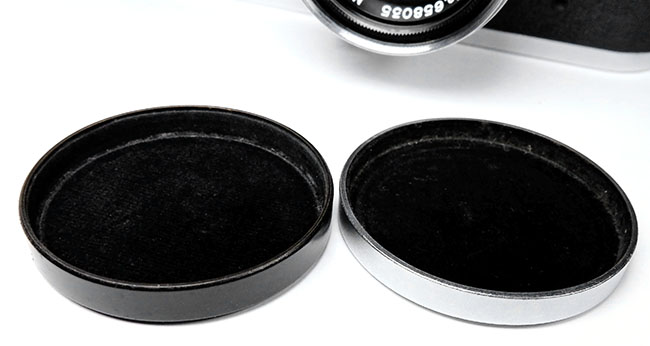
(Image courtesy of Chris Whelan)
The slip-on rigid f/2 lens versions of the lens caps are 42 mm and the f/1.4 are 45 mm, for the other lens sizes, use the clamp-on/slip-on lens hood sizes in Lens Hoods below.
The Nikkor wide angle and telephoto accessory lenses use their own caps with mainly “Nippon Kogaku Tokyo” in the company's logo on the front, although the first accessory lenses for the Nikon S, and possibly in LTM, featured lens caps with an upright “NIKKOR” (not to be confused with the later italicised version). There were various types in both silver and black metal. Generally, the development seems to have been black/silver screw-in, silver slip-on, at some point black slip-on, then black metal clip-on. Silver slip-on left, black clip-on right:
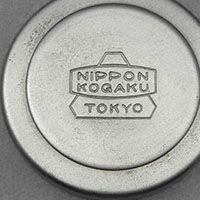
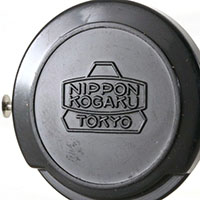
(Detail from larger web images)
Ever-ready Cases
The early body cameras featured fully stitched leather ever-ready cases inspired by the early Leica design in use from the 30s up to and including the IIIf. Both the early example below and the Type 5 case also feature a built-in mount for the Nicca flashgun (see Flashguns below):
 (Detail from larger web image)
(Detail from larger web image)
Like similar Leica cases, some Nicca cases included a card pocket inside the back, on flash sync models for a flash sync exposure guide number card like below found with several different models:
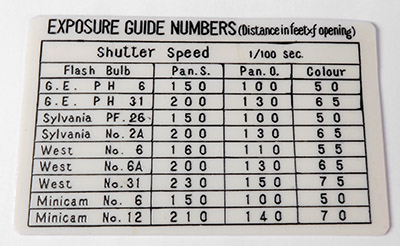 (Image courtesy of Chris Whelan)
(Image courtesy of Chris Whelan)
The pocket seemed to be there in earlier cases and in both the 3-F knob wind and lever wind cases but not in the Type-5, Type-33 or III-L cases. Pocket in early case on left, in 3-F knob wind case on right:
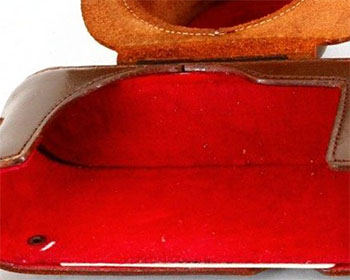
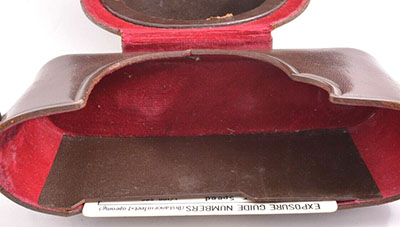
(Detail from larger web images)
The die-cast body cameras featured more fully moulded cases in which much of the stitching was replaced by adhesives, something trumpeted by Nicca in its 3-F user manual. By and large, the glue on the 65 year old cases seems to have held up reasonably well. Nicca relied on its own design for the unique and heavy-handed Type-5 case on left, but again turned to Leica for the M3/IIIg inspired 3-F (lever) case on the right (the Leica versions are fully stitched - note there are two different designs, the other is more like the late Leotax copy):


(Detail from larger web images)
The snout on the 3-F (lever) case is glued and riveted to the case (three rivets) whereas the earlier 3-F and later Type 33 cases were much the same except the 3-F snout was only glued and the Type 33 (with “Type 33” embossed on the back of the case) was glued and stitched.
Below is the unusual Nicca III-L case, front and top views:


(Detail from larger web images)
Fully moulded, the back looks quite compact but the streamlined front covers a lot of empty space even though it doesn't look big. Presumably, it opens easily. How well it handles is something I have no knowledge of. Personally, I think that the style suits the design of the III-L.
Lens Hoods
Below is contributor Chris Whelan's beautiful Nicca 3-S with late type 42 mm clamp-on rectangular lens hood:
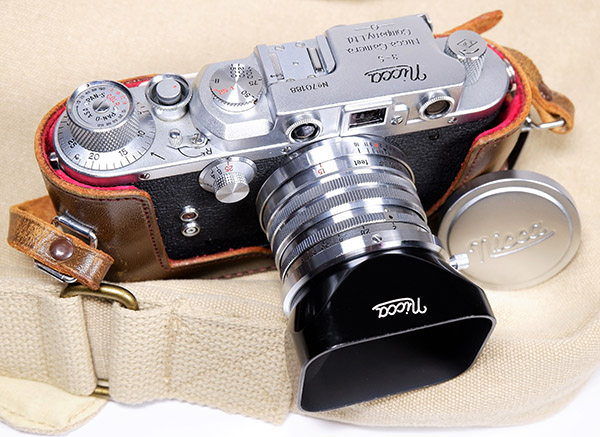
Boxed, with leather case with “Nicca” on the front and distributor “Hinomaruya” on the back:
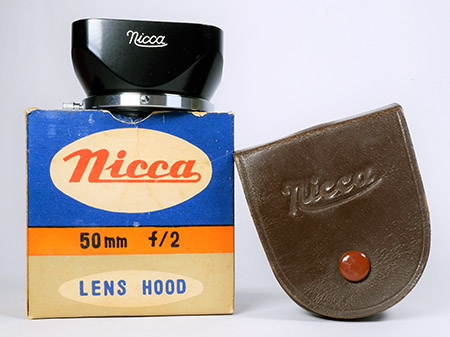
(Above 3 images courtesy of Chris Whelan)
The rectangular hoods are commonly associated with the new body models. Its first appearance in documentation is in a combined Type-5/3-S brochure, although until the release of the Type-5, the 3-S probably still used the earlier circular type. The Nikkor f/1.4 hood is similar in 45 mm size.
The leather cases are glued like the later camera cases but seem to hold up as well as the fully stitched Yashica lens hood cases.
The Nicca Type 33 hood below, shown here for the first type Nicca f/2.8 lens with 34.5 mm filter thread, is circular like the earlier hoods below but is clamp-on, like the square hoods, to fit its 36 mm bezel:
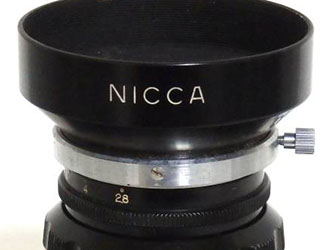 (Detail from larger web image)
(Detail from larger web image)
It is not known whether there is a circular version for the later lens with 40.5 mm filter thread (I doubt it) but almost certainly, the rectangular 42 mm clamp-on hood will fit. Note the style of the “NICCA” name in block capitals, quite different to the Leica-like script on the square hoods and top plates of most models. It is very similar to that of the name on the III-L top plate and III-L black lens cap (see above) so perhaps a late branding modernisation?
Prior to the clamp-on lens hoods were screw-in round types first displaying distributor name “Hinomaruya”, commonly supplied in a “Nicca” box and later, with “Nicca” engraved and Hinomaruya branding on the box. I have found 40.5 mm and 43 cm thread versions of both “Hinomaruya” and “Nicca” engraved hoods (with red fill) for the Nikkor f/2 and f/1.4 respectively and 34.5 mm “Nicca” engraved hoods (black fill) for the rigid f/3.5. Below is an earlier, larger “Hinomaruya” type and a later 34.5 mm type with “Nicca” name:
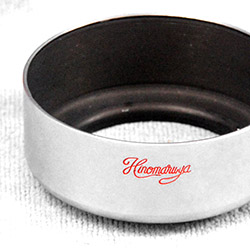
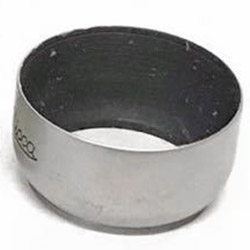 (Detail from larger web images)
(Detail from larger web images)
The image below is from the Japanese Type-III A/S booklet printed in January 1953. The description reads, “exclusive filter set and hood” with “Hinomaruya” branding on the hood:
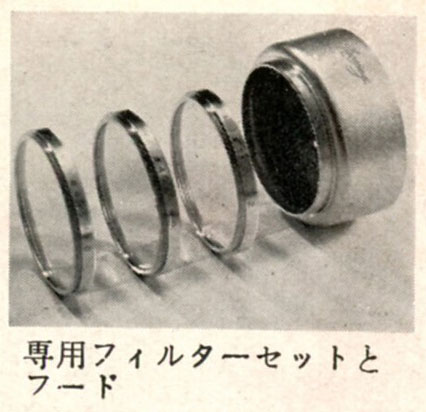
Below is the Nicca version of the 40.5 mm screw-in f/2 hood complete with matching case featuring the distributor's name. Note, the camera and lens are the same ones as photographed with the square hood at the top of the section. Below this, the square clamp-on hood is shown next to the screw-in type which is probably more historically correct for this model:
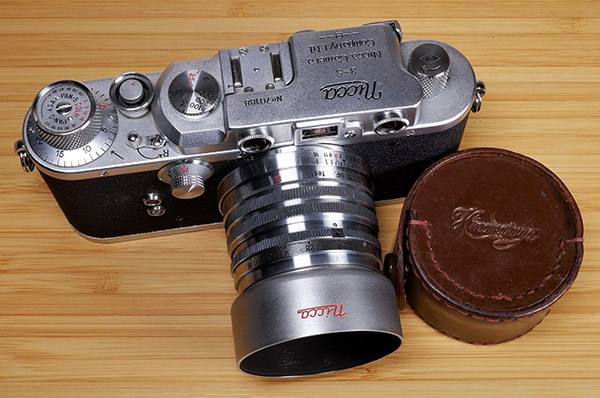
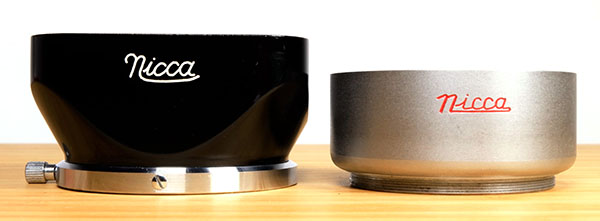
(Images courtesy of Chris Whelan)
However, the screw-in type is unlikely to be the earliest hood type. There is a series of “Nicca” and “Tower” models that are similar round types but are slip-on. They have been measured at 42 mm and both 43.5 mm and 44 mm by different sellers for the larger type. In 42 mm size, two found are marked “Nicca”, the third is “Tower”. There are five in the larger size, all marked “Tower”. Four of the larger five are also marked “Made in Occupied Japan” (MIOJ), the fifth is marked “Made in Japan”. As with later hoods, there is no “Made in” marking on the three 42 mm versions indicating that they are possibly more recent. Below is a Nicca 42 mm:
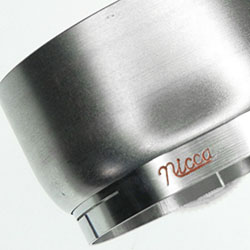 (Detail from larger web image)
(Detail from larger web image)
The larger ones were advertised as being for the f/1.4 Nikkor. I don't think that works, the f/1.4 has 43 mm filter thread and takes a 45 mm clamp-on hood, anything less is too small. The MIOJ means early, 1951 or before, so perhaps the f/1.5 Nikkor which has a smaller bezel? For three reasons, I don't think that flies either; the f/1.5 has a 40.5 mm filter thread like the f/2 and is likely to feature the same size bezel, the f/1.5 lens doesn't feature in the early Tower user manuals that I have seen (only the f/1.4 already) and thirdly, too many of the hoods have been found for what is a very rare lens. My guess is that it is for the f/2 collapsible type Nikkor. Both f/2s feature 40.5 mm filter threads but the collapsible has a knurled front ring making it necessarily larger than the 42 mm bezel of the rigid type.
The Tower user manuals and catalogues seemed to pair hoods with an adapter for Series Filters. I don't know whether the hoods were this type, or different, but I am not aware of Nicca ever offering Series filters. I guess it is possible that the 43.5/44 mm hood was designed for an odd size adapter rather than a lens. (Series filters typically use Roman numerals to denote a range of standard sizes, although Sears did use Arabic numbers later, and require a holder, or adapter to mount to any one of a number of lens diameters within the size range for that Series number).
I think that the slip-on hoods like the one above were originally sourced by Nicca, including the Tower ones, before distributor Hinomaruya arrived on the scene. As noted earlier, I think that the evidence suggests that both the Tower and Hinomaruya arrangements started in 1950, obviously things didn't change overnight and existing contracts would have run their course.
Filters
Nicca offered Nicca branded screw-in filters, source unknown. On the back of the plastic case is the name of Nicca's distributor, Hinomaruya:

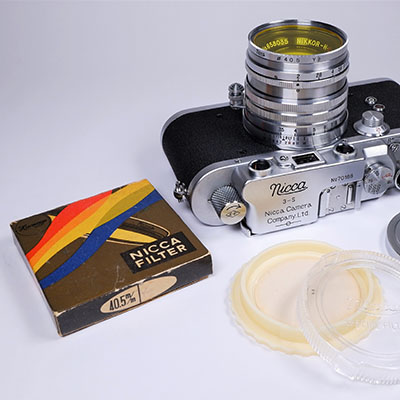
(Images courtesy of Chris Whelan)
As well as the plastic case in this boxed example, I have seen a pair of Nicca filters in a leather “Nicca” branded case, not sure whether originally intended for filters or not, and a stack of 40.5 mm “Y0”, “Y2” and “R0” filters in a red and yellow plastic case with “Hinomaruya” on one side and “Nicca” on the other:
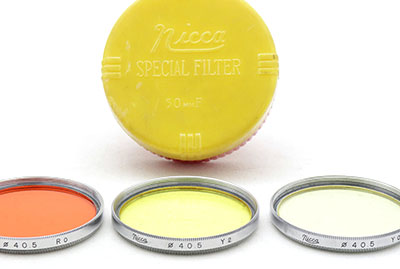
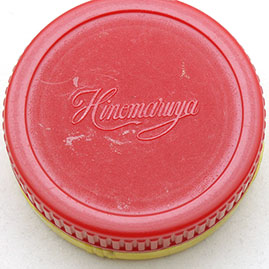
(Detail from larger web images)
Reloadable Film Cassettes
Like Leitz, most copy makers and even SLR makers at the time, Nicca offered a reloadable 35 mm film cassette, or magazine as some, including Canon, call it. Presumably the Yashica version was a rebrand of Nicca's, details of the Yashica and operation are here, including the close relationship to the Leica FILCA type. Both are still marked “Z” for the German “zu” meaning “close” whereas Leotax had changed to “C” before their die-cast bodies arrived in 1954. Although English language user manuals (except the Yashica YF) seem to ignore it, all the Japanese language manuals provide details and diagrams of how it operates (see Downloadable Manuals). This Nicca cassette was supplied in what looks like a Bakelite canister with distributor Hinomaruya's name on the top - few seem to have survived, I have only seen two others. It is different to the later blue plastic type found with the Yashica.
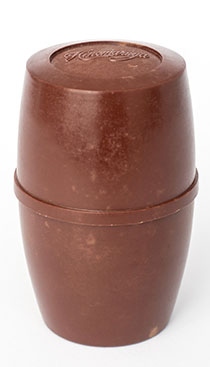
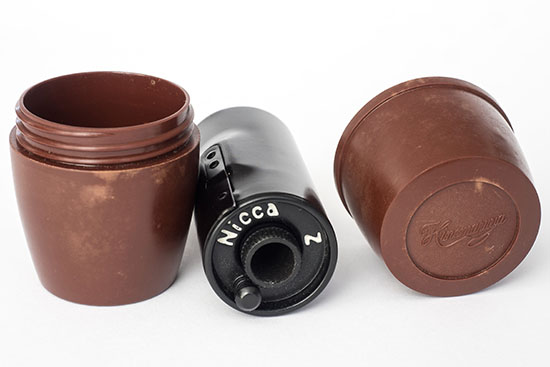
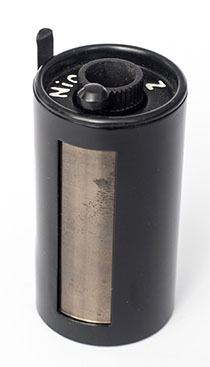
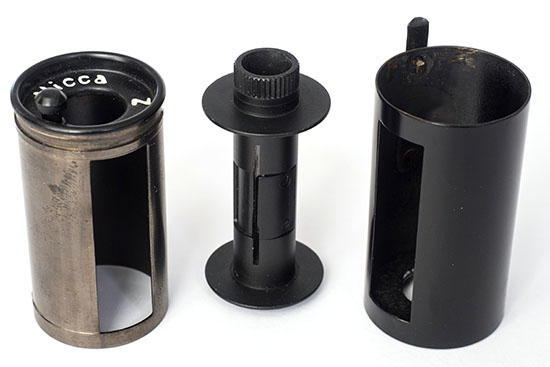
This is one of the two other examples. It is complete with its retail box, note the black canister instead of the brown type above:

(Image courtesy of Kirk Thorsteinson from his Nicca Album on Flickr)
Nicca and Other Finders
Nicca Universal Finder
The variable magnification Nicca Universal Finder is the typical type normally associated with Nicca cameras these days but in fact it was one of several options. It's first appearance is in the Japanese Type-III A/S booklet printed in January 1953. Front and rear views:
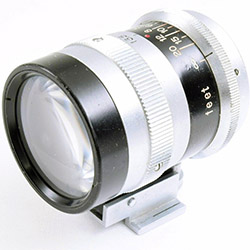
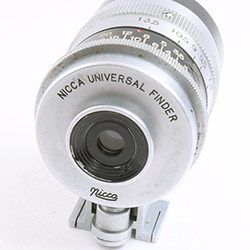 (Detail from larger web images)
(Detail from larger web images)
Certainly not a rebadged Nippon Kogaku Varifocal item - it is the same as both the Alpex and Walz Universal Finders:
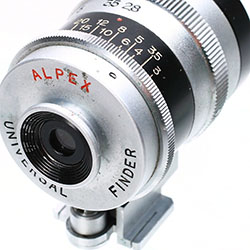
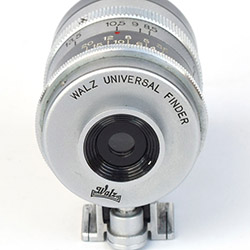 (Detail from larger web images)
(Detail from larger web images)
There are also these, one marked “T.O.C. UNIVERSAL FINDER PAT. No 16739” and the other, “T.O.C. UNIVERSAL FINDER FOR NICCA” :

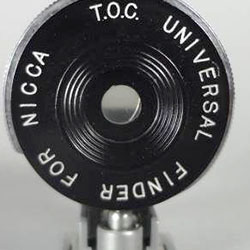 (Detail from larger web images)
(Detail from larger web images)
There are two versions of the left example; as shown, identical to the first three and the other the same as the right example with black rear end and the front rim with fine knurling to the front edge. The black rear end versions look earlier. The presence of the the patent number on one and “FOR NICCA” on the other makes me think that T.O.C. is the actual maker. I have seen claims by web sellers that T.O.C. is short for Tokyo Optical Co. (it more often used the Japanese “Tokyo Kogaku”, much later it became Topcon) and also Tanaka Optical Co., which is a translation of Tanaka Kōgaku K.K., but I haven't found any supporting evidence, only lots of reasons why T.O.C. doesn't mean either. For the record, Topcor LTM lenses seem to have been made by Tokyo Optical Co. exclusively for Leotax maker Shōwa Kōgaku - the finders are significantly different and marked “Topcor”.
Variable Framing Type
The lever wind 3-F manual tells us that there were actually two types of universal finder; the above type with variable magnification from 28 mm to 135 mm and a different one which changed the masking to indicate different fields of view also from 28 mm to 135 mm but at fixed points, somewhat similar to the Nippon Kogaku Variframe but more like a Leica item in appearance and referred to as “Leica like” by Nicca.
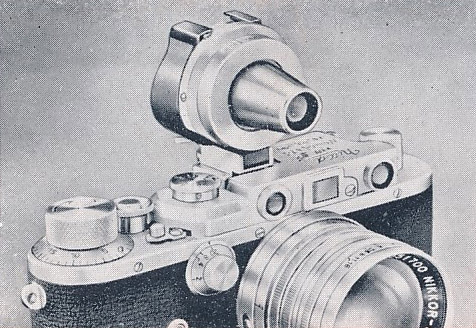 (Image from 3-S/Type-4 user manual courtesy of Chris Whelan)
(Image from 3-S/Type-4 user manual courtesy of Chris Whelan)
Whilst the variable magnification type appeared in the Japanese Type-III A/S booklet, this one featured in the English language version of the Type-III A/S user manual. It is the same as, or similar to, the finder in the Tower Type III user manual (Tower Type-3 camera).
Other Finders
Single focal length Nippon Kogaku finders are also featured in the 3-F manual as is a a Nicca branded sports finder:
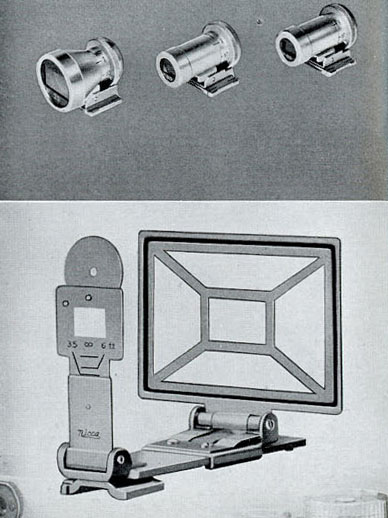
Nicca 3-S with f/3.5 2.8 cm Nikkor lens and matching Nippon Kogaku finder:
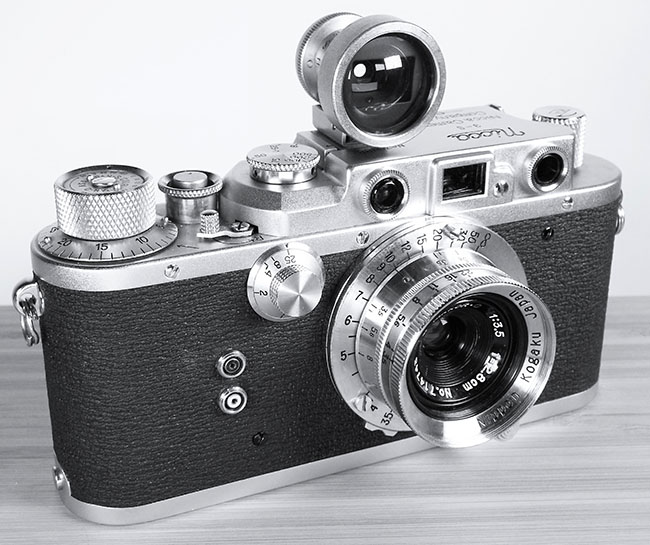
(Image courtesy of Chris Whelan)
Nippon Kogaku Varifocal and Sports Finder Alternatives
Whereas the Japanese Type-5 user manual booklet and both the knob and lever wind 3-F user manuals display the variable magnification Nicca Universal Finder and the Nicca branded sports finder, the Type-5 user manual book (explained and featured further below) and both the lever wind and earlier knob wind 3-F brochures (linked further above) show the Nippon Kogaku Varifocal and sports finders in lieu of the Nicca items:
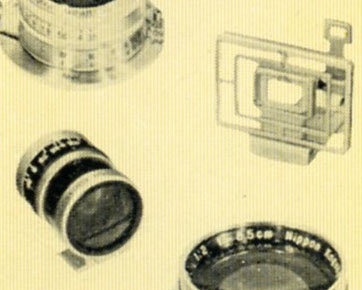
These are the same as in the Nikon S brochure below (also includes the single focal length finders shown above):
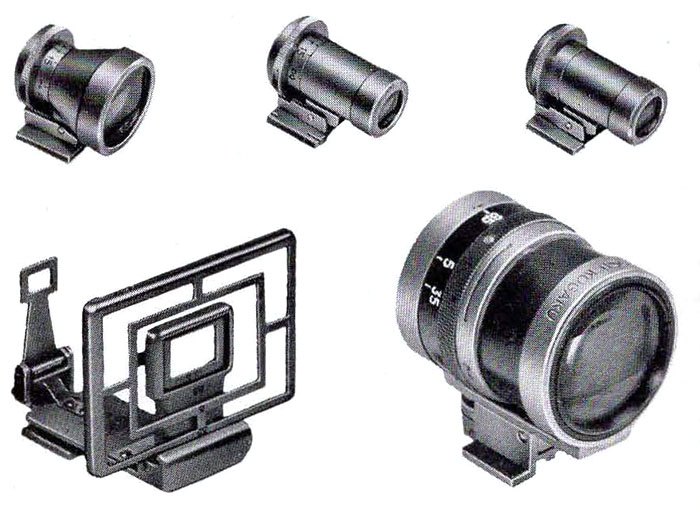
An earlier Type-5 brochure, also still featuring the 3-S, displays the Nicca Universal Finder (but neither sports finder, I haven't seen either one in Nicca documentation until after that time), however a later Type-5 brochure with the same basic layout as the two 3-F brochures, like them displays the Nippon Kogaku Varifocal and sports finders.
Finders are not displayed in the Type 33 or III-L brochures, the manuals are unknown.
In summary, there is probably no “correct” finder for any model Nicca. Hinomaruya was a distributor for both Nicca and Nippon Kogaku's Leica mount Nikkor lenses as well as a Nippon Kogaku “dealer” (see Copy Stand below). As an independent distributor, it probably sourced some/most of Nicca's accessories as well from various suppliers it had other relationships with. The fact that for some models, user manuals promoted one version/brand and brochures, and even different versions of manuals, promoted a different version/brand has probably more to do with Hinomaruya's business model than any Nicca planning strategy.
Copy Stand
Nicca branded timber cased copy stand kit (the 3-F manual also shows it being used for microscope work), the contents of which appear to be the same as shown in the book type manual for the Nicca Type-5:

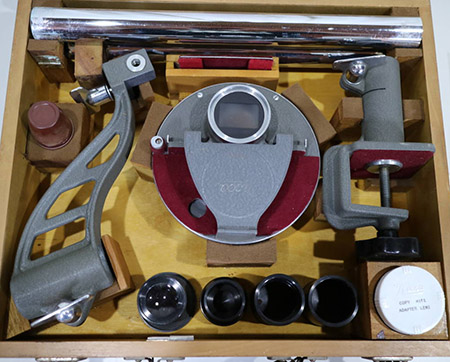
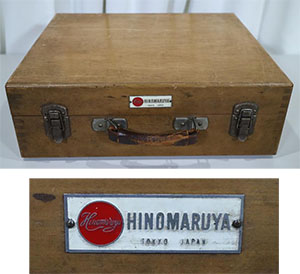
(Instructions and case details from larger web images)
Distributor Hinomaruya certainly wanted it known that it had an important part to play, probably more than simple distribution. Demonstrating both uses, this is an earlier version of the kit featured in the Japanese Type-III A/S booklet printed in January 1953 (note the straight adjustable bracket arm compared to the shallow “S” bend of the later type). Both this and the ads for the Nicca stands further below also feature the label.
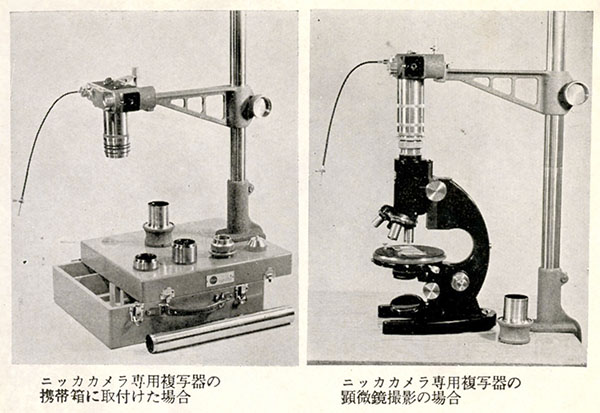
Asahi Camera ad, 1954, for Nicca Type IIA stand similar to the later type above although the case contents are a little different:
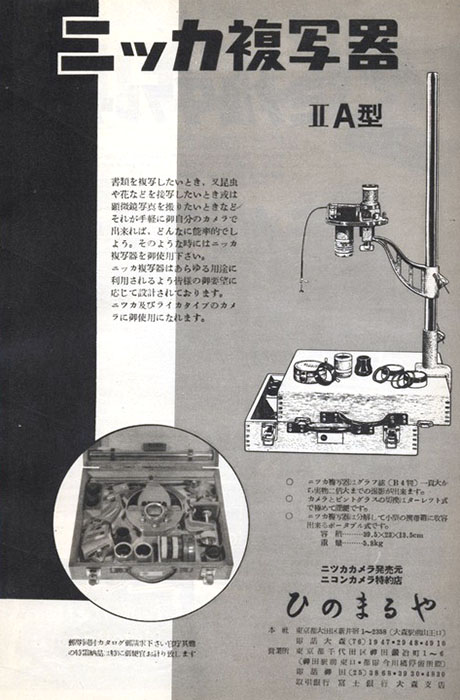
Below left is a 1953 ad for an earlier Nicca Type II with straight bracket mounting the camera to the vertical tube similar to the one in the Type-III A/S booklet but the camera mount itself is different. Below right is a 1956 ad for a Nikon copy stand for Nikon and Contax IIA cameras. All three ads feature a big “Hinomaruya” in Japanese text and its then current address. Above “Hinomaruya”, the 1954 ad above also states “Nicca Camera distributor” and below that, “Nikon Camera dealer”. The 1953 ad simply says “Selling agency” and the 1956 Nikon copy stand ad says “Dealer” whilst also featuring the Nippon Kōgaku logo and name next to it indicating that it is an official product (it also appears on the Nikon history site).
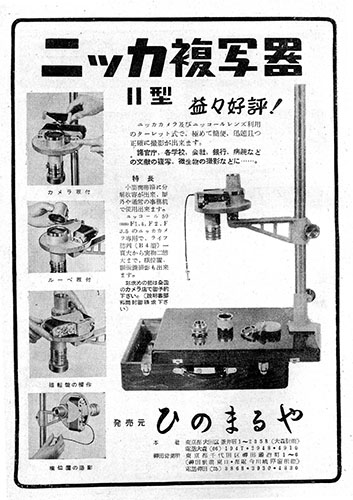
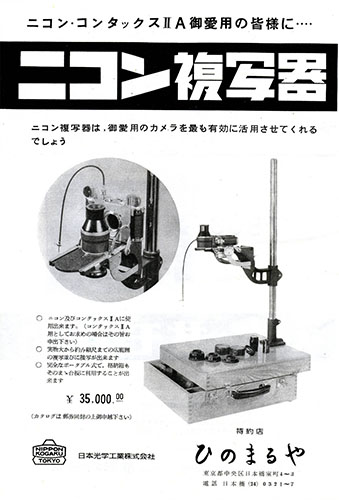
(These two ads belong to the Japanese Nikonfan website where larger versions are available)
The Nikon version is certainly not the same as the Nicca copy stand kit. The obvious external difference is the camera to bracket mount with more sophisticated features and perhaps capabilities. Photos of the inside of the Nikon case reveal different components, at least some probably made by Nippon Kōgaku, and consequently layout, and whilst also more opulently finished, the differences are consistent with Nippon Kōgaku's professional aspirations and pricing. However, the concept, the overall design, timber case and stand mount all appear very similar and suggest the same specialist maker is responsible and it seems somewhat likely that Hinomaruya may have had a role in that rather than just as a seller.
The “sharing” of accessories between Nippon Kōgaku and Nicca is not fanciful, the links between their flashguns are much stronger.
Flashguns
In the 1951, more likely 1952, to 1958 period, Nicca offered two main versions of its side mounted battery capacitor (BC) flashgun. The second was probably an evolution of the first. The first one was likely marketed until the Type-5 was released in 1955. I haven't observed any significant physical differences with the first type but there is a “Model 2”, a couple of names, several versions of the manuals and at least two different boxes. The box I presume to be earliest has a plain red lid with this label below left and contains the contents on the right:
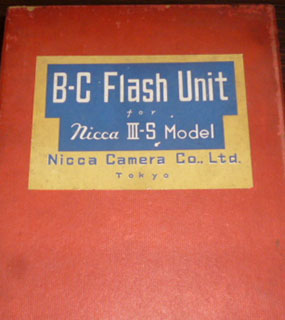
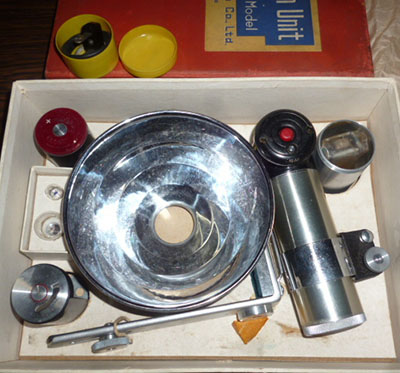
(Detail from larger web images)
Because it specifically says “for Nicca III-S Model”, it suggests that the flash arrived at the same time as that model in 1952, rather than with the earlier III B. The other box, which makes no reference to any model, is more common and therefore perhaps more long-lived and likely later (contributor Chris Whelan's included instructions mentions both the Nicca 3-S and Type-4):
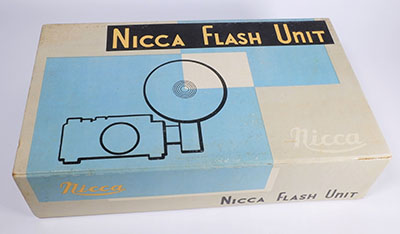 (Image courtesy of Chris Whelan)
(Image courtesy of Chris Whelan)
The contents of both boxes seem to be the same except for some very minor cosmetic differences and the inclusion in the first box of a battery compartment extension tube for using two D-cells (top right corner of contents above) and a battery holder for alternatively using three AA batteries in place of the side by side mounted capacitor and 22.5 volt battery (black cylinder with maroon lid top left corner of contents above, see also here). So far, these haven't been found in later kits, nor is there a place for them in the later box, but both alternative power sources are mentioned in the instructions found with Chris' example. The photo below demonstrates that the body without the extension tube is too short to accommodate two D-cells:
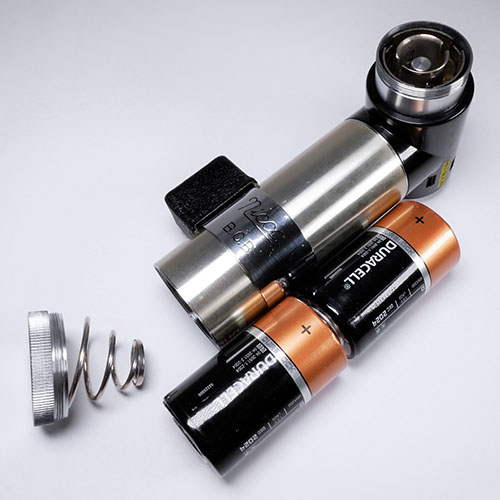 (Image courtesy of Chris Whelan)
(Image courtesy of Chris Whelan)
The first box calls the flash “B-C Flash Unit”, the other simply “Nicca Flash Unit”; but the cover of its Japanese instructions call it “Nicca B.C. Flash Unit” (see Chris Whelan's photo further below). These are two other manuals, the first seems to be an English version of the Nicca B.C. Flash Unit example but with the title “Nicca B.C. Flash Unit Model 2” which makes sense of the slightly different contents of the two boxes. The second calls the flash “Nicca B.C.B. Flash Unit” (“Nicca” is crossed out and substituted by “West”, see The Direct Nicca/West Link). I don't know if it is earlier, or later - by name I would think earlier, by design probably later:
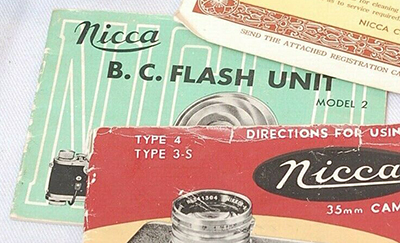
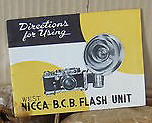
Engraved on the flash bracket tube clamps of all the earlier examples is “Nicca B.C.B.”, first in red and then in black, the exact meaning of which I haven't seen explained anywhere but is discussed further in B.C.B. and BC Flashgun Types:
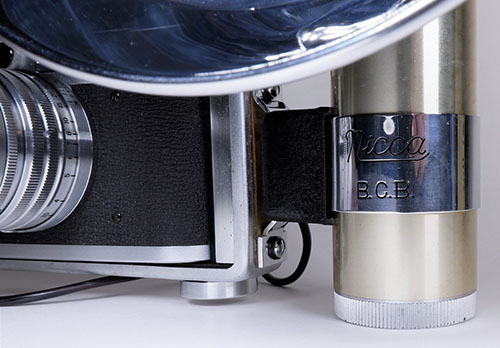 (Image courtesy of Chris Whelan)
(Image courtesy of Chris Whelan)
Both earlier and later flashguns could be mounted via a bracket attached to the tripod socket or via a bracket built into the Type-III S, 3-S, Type-5 and probably 5-L leather half cases, there on the Tower 45/46 version. Although I haven't seen actual evidence, presumably, the Type-4 was the same. It also seemed to feature on the Tower version of the 3-F (lever) but not the Nicca version. Bracket built into early body synchronised camera case on left and Type-5 case on right.
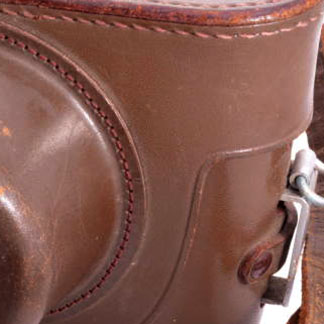
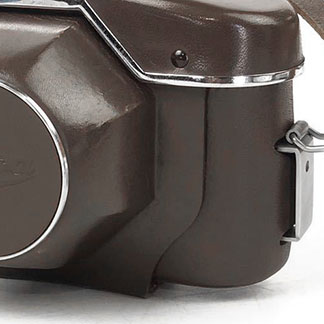
(Detail from larger web images)
B.C. flashgun mounted via fixed “L” bracket:
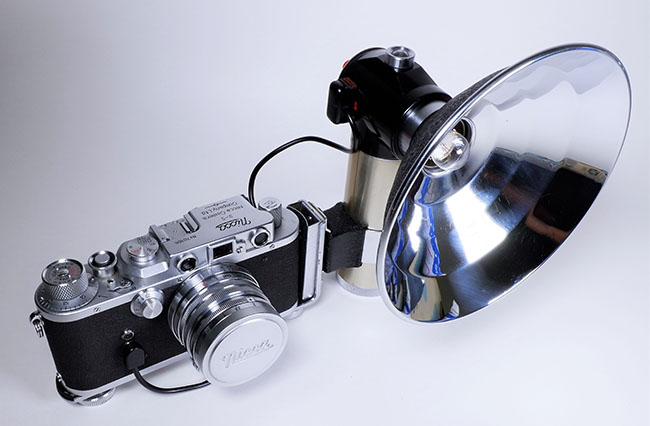
(Image courtesy of Chris Whelan)
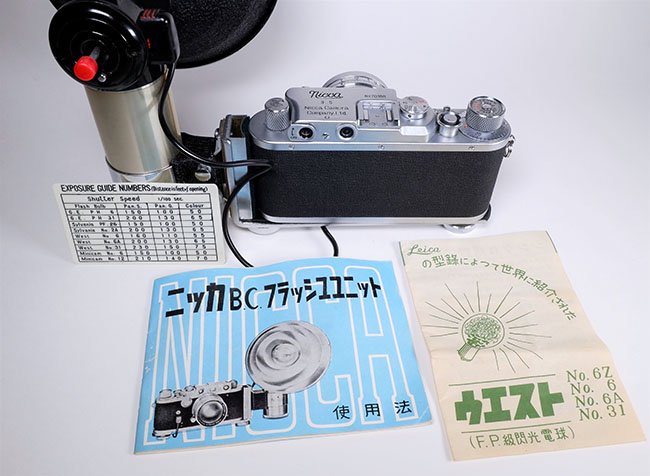
(Image courtesy of Chris Whelan)
Components minus the reflector, battery and capacitor:
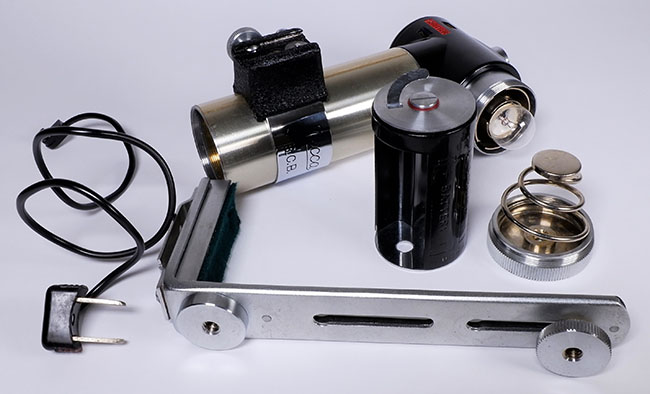
(Image courtesy of Chris Whelan)
Schematic from the user manual:
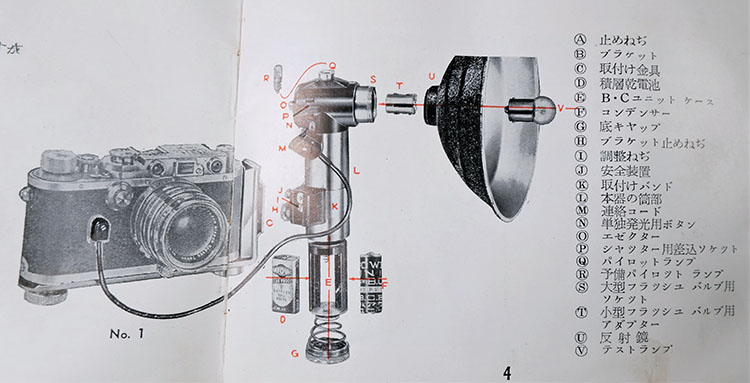
(Image courtesy of Chris Whelan)
The later type flashgun features a folding reflector and hinged folding “L” bracket to make stowage easier. The user manual for the flash shows it attached to a Nicca Type-5 and names it as the “Nicca B-C Flash Model III”, although the back of the flash head says “BC-III”. It also appears in a combined Type-5/3-S brochure, both the Nicca 3-F knob-wind and lever-wind user manuals (probably in all later manuals, including the Sears 45/46 user manual) and was probably the flashgun depicted in a Yashica YE brochure and in the YE user manual. Here it is mounted on a Nicca 3-S via the bracket built into the 3-S half case:

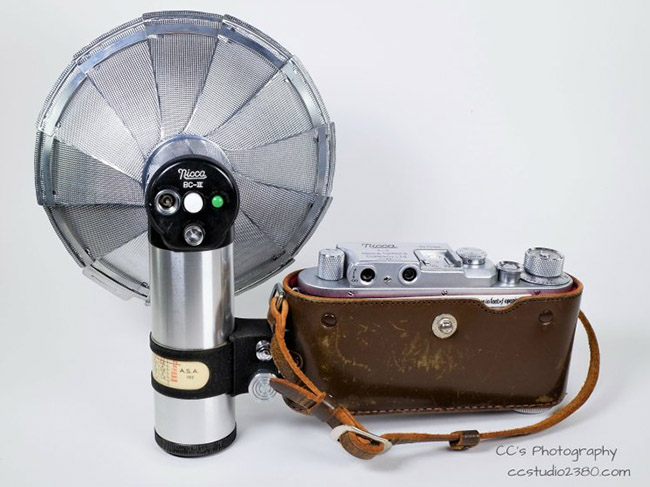
(Images courtesy of Chris Whelan)
Schematic from the user manual:

(Image courtesy of Chris Whelan)
It has both serial (on back) and parallel (on side) connection sockets and a test lamp. The ejector button is white rather than the red of the earlier type and the test lamp is now on the back instead of top.
Here is my kit and the BC-III mounted on my Nicca 3-F using the folding “L” bracket:
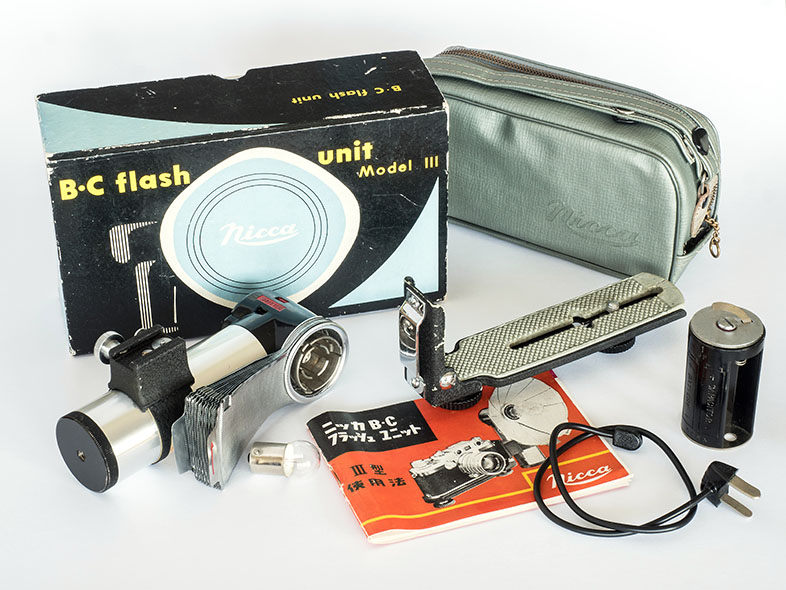
The PDF of the Japanese user manual and the link to the English version are available from User Manuals.
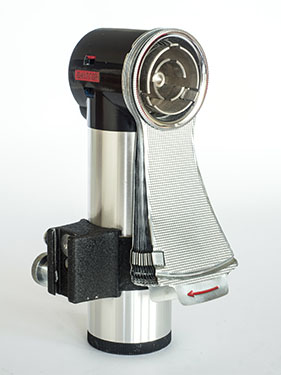
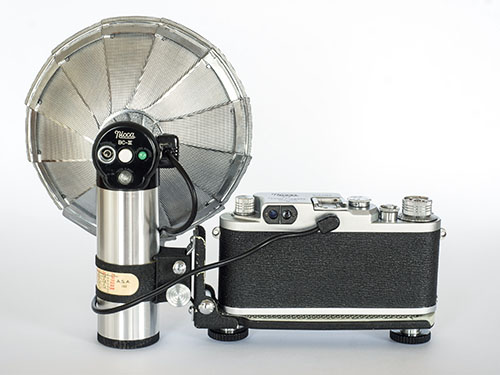
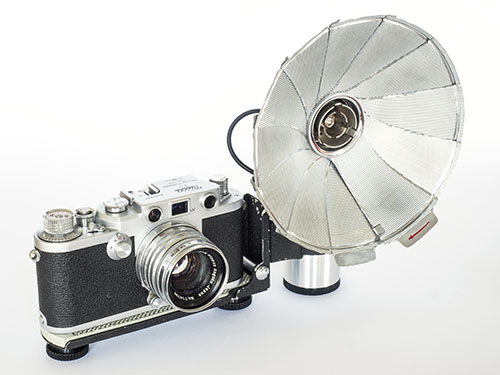
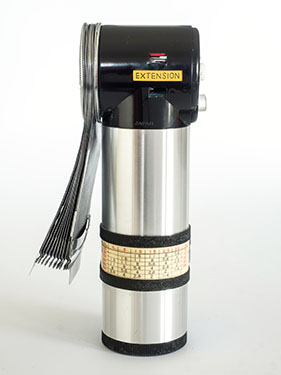
Pictured below are three views of the original type capacitor displayed in the user manual, a little worse for 65 years wear, and 22.5 volt battery, probably a replacement but still late 1950s/1960s graphics. They sit vertically side by side in the cylindrical holder above:
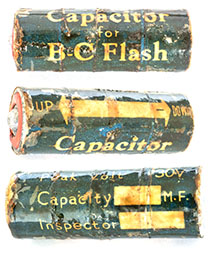
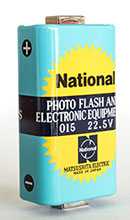
The BC-III user manual tells us that clamp mounted extension “sidelights” were available and also a replacement folding bracket designed for “reflex” cameras, i.e. for TLRs. As mentioned above, the instruction manual for the earlier B.C.B. model tells us that as well as the battery capacitor pack, it can be operated with D-cells or AA/penlight batteries (tube extender and battery holder respectively included in the first red box kit). The Nicca BC-III manual makes no mention of operation without the capacitor and no accessories are provided for it.
See also Tower Flash below, including the Tower version of the Nicca BC-III.
Did Nicca Make Its Own Flashguns?
Nicca was a smallish camera maker, making one or two Leica copy models at a time. A flashgun may seem a simple thing in appearance and operation but to develop one from scratch, with new technologies to understand, patents to navigate, tooling to be sourced etc is a formidable task. It will inevitably sell in limited numbers, yet still have to be competitive with models from specialist makers. For those reasons, I think that Nicca didn't just have assistance but outsourced its flashgun production. Just as Nikon did. The evidence that West Electric Co., Ltd. is responsible for both is explored on a separate page, Nicca's Flashgun Maker.
Tower Accessories
As well as selecting from anything Nicca may have had available, Sears also sourced its own accessories used for other cameras in its catalogues too so anything, if it fitted, could be mixed and matched. The items below were specifically offered for the Nicca based Tower 35 models.
Tower Lens Caps
Cameras were supplied with a “Tower” lens cap for their standard Nikkor 5 cm lenses:
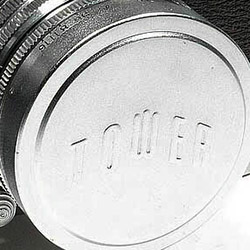 (Detail from larger web image)
(Detail from larger web image)
Tower Ever-ready Cases
The leather cases were the same as their Nicca counterparts except for the name embossed on the front. Early Tower Type-3 camera case below:
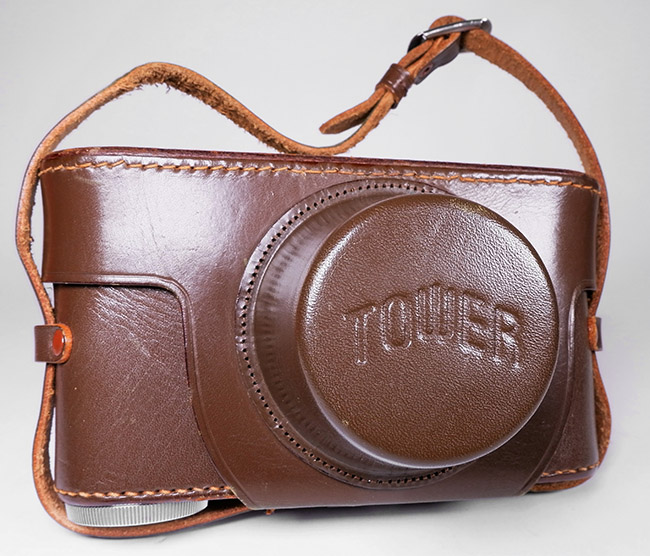
(Image courtesy of Chris Whelan)
Later die-cast body case with flash mount on side (probably Tower 45/46, or Tower 48 version of Nicca 3-F lever wind, although neither Nicca 3-F model cases have the mount):
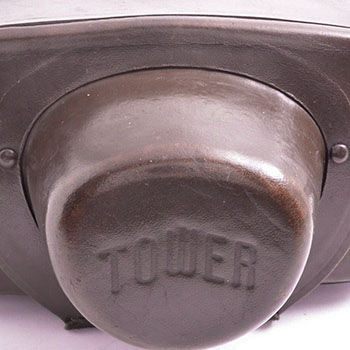
(Detail from larger web image)
Tower Lens Hoods/Filters
In Japan, many of the lens hoods for the standard lenses were almost certainly sourced by Nicca's domestic distributor, Hinomaruya with “Hinomaruya” appearing on the early hoods and on the boxes and cases of later hoods bearing the Nicca name. I'm not sure what happened in the USA, and whether Sears sourced its own hoods. In (Nicca) Lens Hoods, I noted that the Hinomaruya and Sears distribution arrangements probably both commenced in 1950. As perhaps a legacy of previous supply arrangements, there appear to be slip-on lens hoods predating Hinomaruya's models. These have been found in both 42 mm size (for the rigid f/2 Nikkor) and a larger one measured at either 43.5 mm or 44 mm which I believe is most likely to suit the f/2 collapsible Nikkor (my reasons are given in Lens Hoods) but may be to match one of the adapters mentioned below. The 42mm version has been found with both Nicca and Tower branding, the larger one as a Tower only so far. Four of the five larger ones are marked “Made in Occupied Japan” so are early, certainly 1951 or earlier. I have not found any other types branded “Tower”, at least not obviously for the Tower 35 models.
Tower version of the 42 mm slip-on type below:
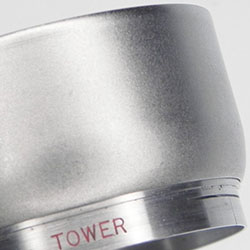 (Detail from larger web image)
(Detail from larger web image)
Whilst Nicca offered screw-in filters similar to modern types, Sears focused on the so-called “Series filters” available in various sizes usually categorised by Roman numerals (later, Sears used Arabic numerals). These typically fit into adaptor rings that use a slip-on lens mount. Series filters were an earlier system that appears to have remained popular longer in the US than elsewhere.
The 1956 Sears catalogue describes “Lens Shade-Filter Holder. For TOWER 35. Keeps stray light from entering the lens. Holds Filters.” There is one version for the Nikkor f/2 which fits Series VI filters and another for the Nikkor f/1.4 which fits Series VII filters. I have certainly not found any similar Nicca set ups. From the Tower Type-3 user manual (dates back to 1950):
(Scan courtesy of Chris Whelan)
Although the “shade” used with the filter holder looks similar to the slip-on Nicca/Tower, the manual says it “screws easily onto the adapter ring” so I don't know if it is the same type. The filter holder is still mentioned in the 1959 catalogue, but there are no photos.
Below is a 42 mm lens hood found with a Tower 45 (Nicca 5-L) from most likely 1957. There is no way of telling whether it is the same age as the camera, or not, but it appears to be the same type slip-on Tower hood as further above. If it is the same age, then Tower continued long after with this type than Nicca did - was it still procured through Nicca? It is shown mounted on the filter adaptor ring which screws into the lens filter threads whereas the manual seems to depict a slip-on adapter. Presumably, it can also mount directly to the lens without the adapter:
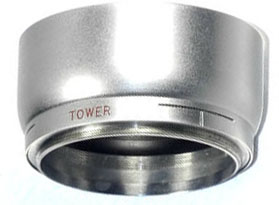 (Detail from larger web image)
(Detail from larger web image)
Finders Offered by Sears
In the 1955 and later catalogues, Sears offered Nippon Kogaku finders for its Nikkors, both the “Varifocal” and fixed focal length types and also matching ones for its budget lenses, first the Steinhill and then the Kyoei. In the earlier catalogues and Type-3 user manual, the finders featured were both the Nippon Kogaku fixed length type and Sear's “Universal Viewfinder” which looks like the Nicca sourced variable frame type similar to Nippon Kogaku's “Variframe” mentioned in Nicca's accessories above.
Tower Flash
At the time of the early Tower Type-3 (Nicca Type-III A/B), very probably from before Nicca releasing its first flashgun, the 1952/53 Sears catalogue offered two Tower BC flashguns, source unknown, one for synchronised models and the other for unsynchronised models. The 1953/54 catalogue still features a Type-3 camera but the flashgun is now unmistakably the Nicca B.C.B. model. The Tower 35 page of the 1955 catalogue features the Tower Type-3S camera with the Nicca B.C.B. model identified as the “TOWER B-C Flash Unit (3 A 9636)”. It is shown again in the flash section on page 40 together with a version featuring a square bracket base for TLR cameras. In the 1956 catalogue, the new Nicca BC-III flash features with the Type-3S, in 1957 with the Tower version of the Nicca 3-F knob wind and in 1958, with the Tower 45/46. In both the catalogues and the Sears produced version of the Tower 45/46 user manual, it is generally referred to as “TOWER B-C flash unit (No. 9724)”.
These scans are of the 9724 flash from the 1957 catalogue, the two on the left from page 6, this year's “Tower 35” (probably Nicca 5-L based Tower 45/46, although Nicca 3-F knob-wind based version in the main picture and the “Outfit” picture below - more in Catalogues & Names), and the other from page 42 where the flash is presented as a universal type complete with a TLR bracket version like the earlier flash:
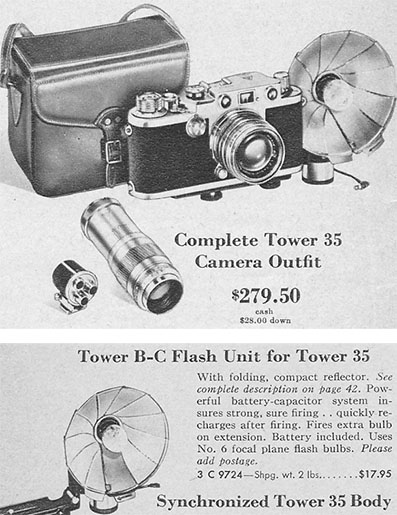
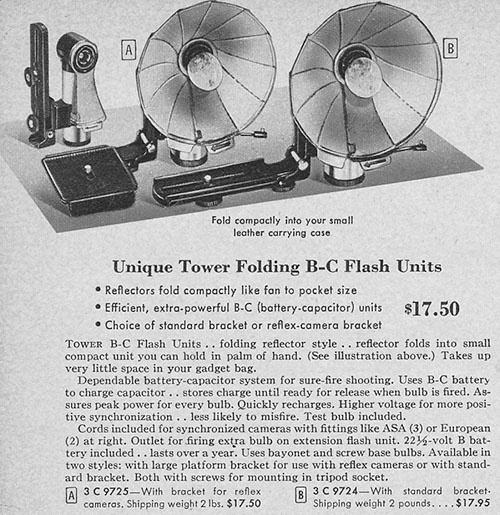
This is contributor Chris Whelan's 9724 kit, note the “Tower” name and logo on the rear of the flash head instead of “Nicca”:
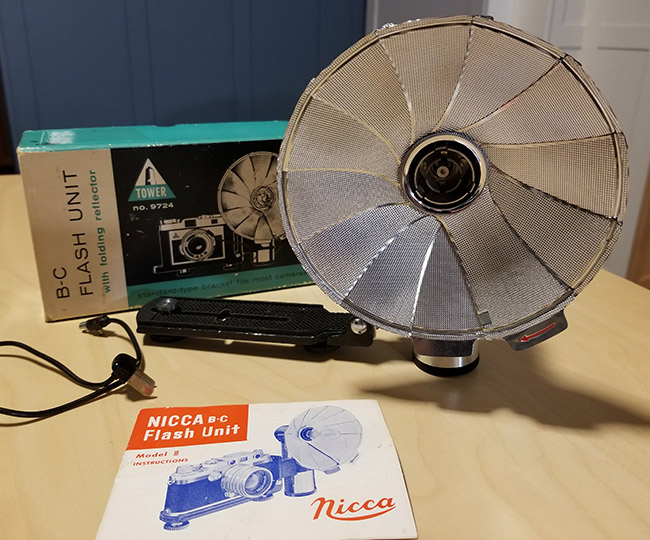
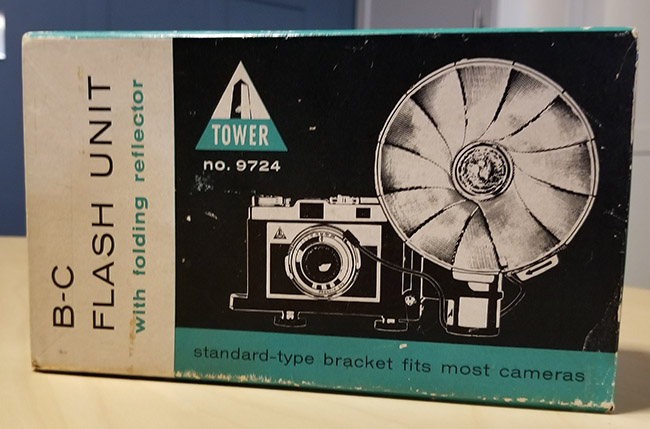
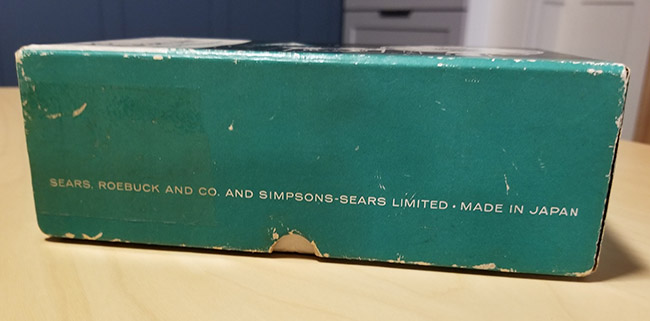
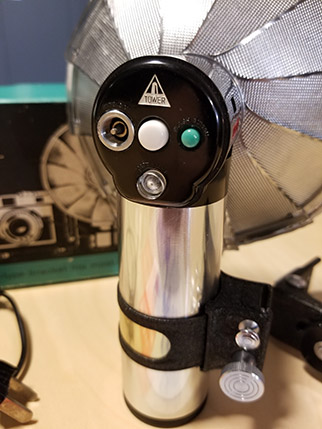
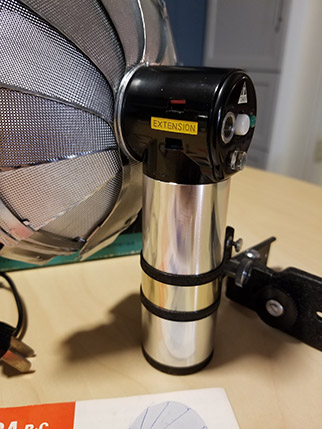
(Images courtesy of Chris Whelan)
Although the instructions appear to be provided by Nicca, the box eschews any link to Nicca, even featuring a different Tower camera. Unlike the Nicca version, there is no exposure guide in the “window” created by the tube mount.
The Nicca branded user manual is a jarring anomaly compared to the branding on the box and the flash itself. I suspect the main reason was to avoid reshooting the flashgun images which feature Nicca branding, it would have also been strange to have the Tower name on the cover and Nicca flash units inside. The cover looks much like that of the Japanese manual pictured further above and linked in the next section below (as is the Tower version) and also of the English language version downloadable from OrphanCameras.com (a version previously owned by Chris Whelan too) but the colours are different, this one has a predominantly white background and the text and diagrams inside are predominantly blue.
The 1959 catalogue instead displays a compact folding flash with the Tower 45/46. This was at a time that Yashica was acquiring Nicca and the probable maker of Nicca's flashguns, West Electric, had been acquired by Matsushita (these days, Panasonic Corporation). Whether these were factors, or whether Sears wanted something more modern/smaller/cheaper to offer, is not known.
User Manuals
Downloadable Manuals
User manuals for some models are available from Mike Butkus of OrphanCameras.com. These include Tower Type-3 (Type-III on cover), Nicca Type-III A/Type-III S, Nicca 3-F (knob wind), Tower 5-L (probably Nicca published for Sears), Tower 45 & 46 (Tower version of 5-L published by Sears) and Nicca B.C Flash Unit Model III.
The following are manuals downloadable from this site (note for MacOS users only; Safari is sometimes displaying only the left half of double page scanned PDFs if the first scan is a single page - common with my cover pages, suggest using a different browser, or Preview, instead):
Nicca Type-III A/S
Japanese combined Type-III A and Type-III S user manual, the interior presentation is very different to the English language version available from Mike Butkus (III S featured inside, III A on back cover):
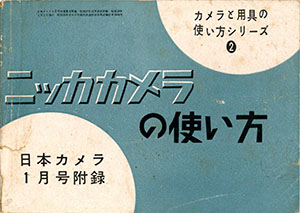 (Click on cover for PDF of full manual)
(Click on cover for PDF of full manual)
Distributor Hinomaruya seems to be responsible for it but was it in the camera box originally? I have my doubts. It is certainly a “how to use” manual of some sort for the featured Nicca models but there are indications that it may have been a promotional booklet issued with a Japanese magazine. Translated on the bottom left of the cover is “Japanese Camera January issue appendix”. My understanding is that the booklet itself was printed in January 1953. How much it replicates/reflects the original Japanese user manual is unknown.
Nicca Type-4/3-S
This is Chris Whelan's combined English language Nicca Type-4 and 3-S user manual:
 (Scan courtesy of Chris Whelan)
(Scan courtesy of Chris Whelan)
(Click on cover for PDF of full manual)
Nicca Type-5 Book
In Japan, at least sometimes, the Nicca Type-5 was supplied with a more comprehensive user book (five found) than the typical user manual, somewhat like Yashima's Yashicaflex Photography and like that, also marked “Not for Sale”. Both Nicca's and Nicca/Nikkor distributor Hinomaruya's names are on the front cover of the book and Hinomaruya's logo in Roman script on the back. The publisher is listed as Hinomaruya at its HQ address. The more typical user manuals feature either Nicca's address on earlier manuals or both on later.
Just before the contents listing near the beginning of my yellow book, it says “1957 version” (Gregorian year shown) and then on the unnumbered page after page 196 it says that it was first published on 15 April 1956 (the Type-5 camera was released in March 1955) and revised on 1 November 1956 (Showa 31 year in words). It has 196 numbered pages plus 27 unnumbered pages at the beginning, mainly photos and the contents pages, and one at the end.
Whereas the smaller, typical user manuals read from left to right, the book type read from right to left (western minds need to think about starting at the back and reading towards the front). My scan below still has the first page first but each pair of pages should be read right page before left page. Japanese text can be either horizontal or vertical, most of the text in this book is vertical. Front and back covers:
(Click on either cover for PDF of full book)
(I have two identical same edition copies, one with a poor binding with many loose pages and the other in much better condition. The scan is mostly of the loose binding one because it arrived first and is also much easier to scan but two missing pages have been added from the better copy plus two other adjacent page pairs have been re-scanned from that because they were out of order. These pages are noticeably whiter. The covers also belong to the better copy.)
The book seems to be full of interesting stuff, e.g. reference to the rare Nikkor f/1.1 5 cm lens and how to adjust the rangefinder, but unfortunately, my translate app struggles to make sense of it. There is also a more typical booklet form Type-5 user manual, see next section.
Note, as also explained in the next section, the same book may have been offered with the two 3-F models as well.
Nicca 3-F Knob-wind
Below is a PDF of the Japanese language Nicca 3-F knob-wind type booklet:
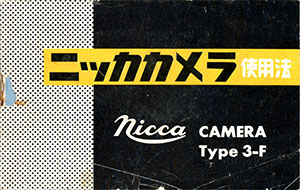 (Click on cover for PDF of full manual)
(Click on cover for PDF of full manual)
The content is very similar to the English language version, although there are a couple of extras, e.g. reusable film cassettes are not usually covered in any of the English language manuals.
Nicca 3-F Lever-wind
Below is a PDF of the Japanese language Nicca 3-F lever-wind type booklet:
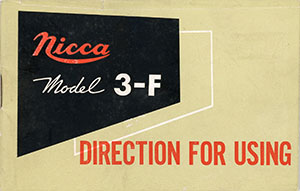 (Click on cover for PDF of full manual)
(Click on cover for PDF of full manual)
Nicca BC-III
Below is a PDF of the Japanese language Nicca BC-III flashgun manual. It is basically the same as the English language version but adds a page with additional information about using sidelights and consequently, doesn't include the synchronisation graphs found in the back of the English language version (from OrphanCameras, explained below):
(Click on cover for PDF of full manual)
Nicca BC-III Manual Found with Tower BC Flash Unit no. 0724
This English language user manual for the Nicca BC-III flash found in the Tower BC Flash Unit box further above features the same photos, diagrams, content and layout as both the Japanese one and the English one available for download from OrphanCameras.com but only up to the end of page 12. It misses out on detailed connecting information for accessory sidelights and also on two pages of accessories, although it does have the synchronisation data missing from the Japanese version. Consequently, it is 14 pages compared to 18 pages each for the other two user manuals.
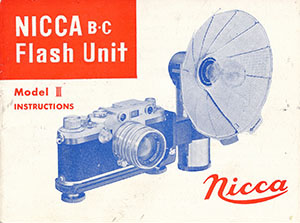 (Scan courtesy of Chris Whelan)
(Scan courtesy of Chris Whelan)
(Click on cover for PDF of full manual)
Yashica YF
There are differences between the Yashica YF and Nicca III-L like the main shutter dial operation and manual frame counter re-set on the Yashica, auto on the Nicca:
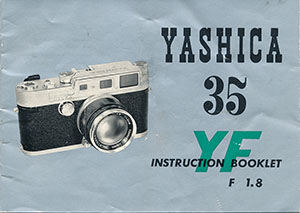 (Scan courtesy of Chris Whelan)
(Scan courtesy of Chris Whelan)
(Click on cover for PDF of full manual)
User Manual Covers
Most Nicca and Tower camera user manuals, including those from above, but not all (certainly not those exclusively available from Mike Butkus), are shown to place them into context especially where there is more than one version.
The earliest Nicca user manual I have seen so far is this English language one with “Type-3” engraved on the camera:
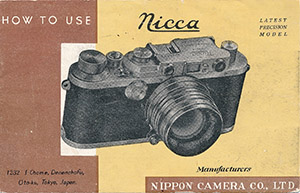
The pair below are the earliest Tower manuals, both cameras engraved “Type-3” with the manual on the right featuring the name “Type III” on the cover (examples of this one downloadable from OrphanCameras.com and Pacific Rim Cameras). The Tower manual on the left seems to be almost the same as the Nicca one above and was almost certainly produced by Nicca (the one page visible inside is marked “Printed in Japan”). The right manual was almost certainly printed in the USA. The existence of two versions of the manual seems to be the same situation as with the two later 45/46 manuals. Note, whilst both the Nicca and Tower are named “Type-3”, as discussed earlier, the Tower is likely to be Nicca Type-III A/B based (flash is not mentioned in these manuals but flash sync is fitted to more than half of the Tower Type-3 examples in my database):
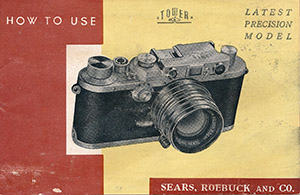
.jpg)
(Above three covers are scans courtesy of Chris Whelan, those below are a mix from larger web images and Chris and myself for the examples from Downloadable Manuals above)
Japanese combined Type-III A and Type-III S user manual, perhaps issued as a promotional booklet with a Japanese magazine (see PDF and description above). The English language manual for these two models is downloadable from OrphanCameras.com:

Japanese Type-4 and 3-S user manual on left, possibly similar to the English version on the right:
.jpg)

Below left is the typical Japanese user manual for the Nicca Type-5. Cameras have been found with either this type or the yellow covered book version on the right (described and linked further above) but not with both types together, although it is possible and maybe even likely that both were originally supplied as a pair:
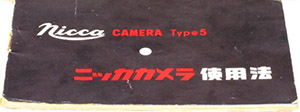
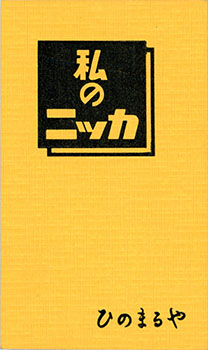
On the left below is the knob-wind Nicca 3-F booklet type user manual, on the right another book type. As I bought the pair together without camera, plus a 3-F brochure, there is no way of knowing for sure whether the two manuals are a matched pair originally supplied with the one camera, or the three documents were assembled by a collector. Or so I thought. When I received them, imagine my surprise to find that the patterned cover featuring drawings of the 3-F is just a dust jacket over the original yellow book still featuring the Type-5! Mine are both the same edition and identical. Assuming that this is typical, I think it is highly likely that both the booklet and book were supplied together:

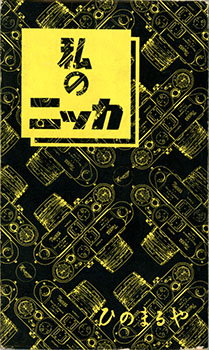
This the full dust jacket:
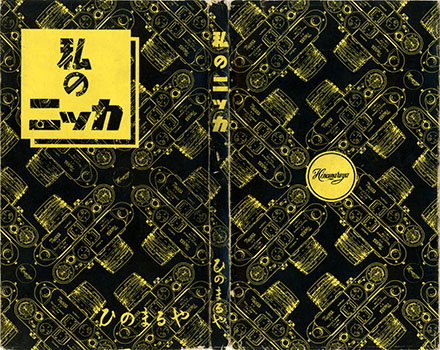
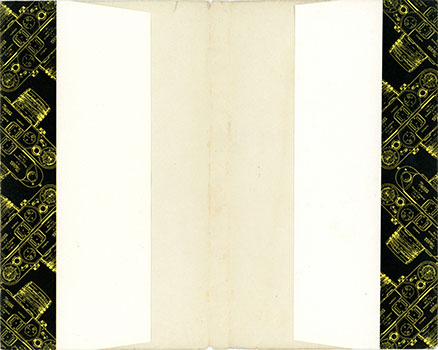
The lever-wind Nicca 3-F has also been found with two manuals, the booklet on the left (downloadable PDF further above) and the blue covered book with a pattern on it formed by drawings of the lever-wind 3-F. Has this been updated to reflect the lever wind, or is it just another dust jacket version of the original?

book.jpg)
The two Tower manuals seem to be similar to the Tower Type-3 approach above and are covered in more detail in the Tower 45/46 model description earlier. Basically, it seems that the left version was produced by Nicca and the right version by Sears and both may have been supplied together (both downloadable from OrphanCameras.com):
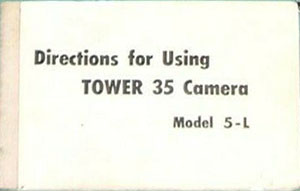
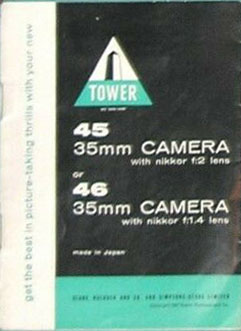
The “48” is the Tower version of the Nicca 3-F lever wind model. Whilst the appearance suggests a similar split of manuals to the 45/46, this probably Nicca produced version may have been the only one offered, the “48” and Sears' name on the front possibly completing the branding:
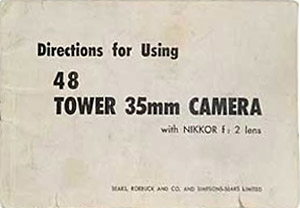
Nicca Type 33 user manual:

A very low resolution photo of the Nicca III-L manual with box in the background:
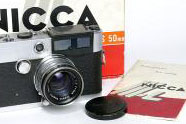
From Nicca to You - Boxes
If you are more of a user than collector, then the original packaging of the camera probably holds little thrill. However, collectors do salivate when they see cameras offered with their cases, boxes, papers etc. Often it also means that the cameras themselves are in great cosmetic condition at least. The Nicca 3-S and early Type-5 examples a little further below are the pinnacle of Nicca's packaging largesse and indicate that profit margins must have been good at the time.
I don't think that I have seen any other Tower boxes than the early Tower Type-3 kit once owned by contributor Chris Whelan:
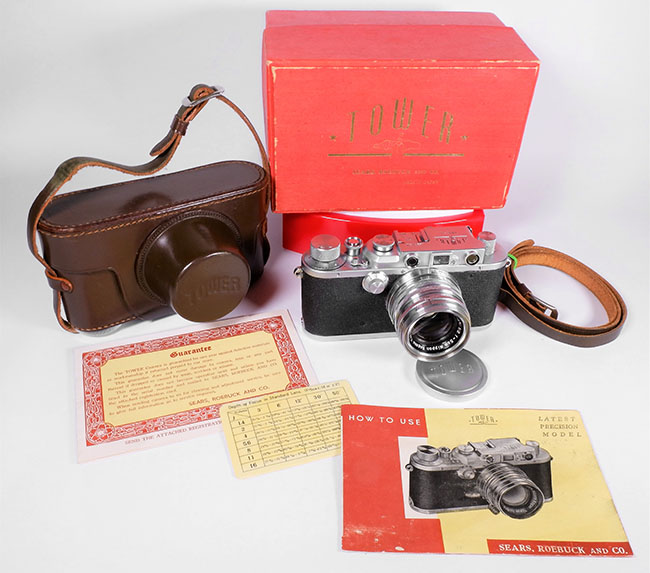
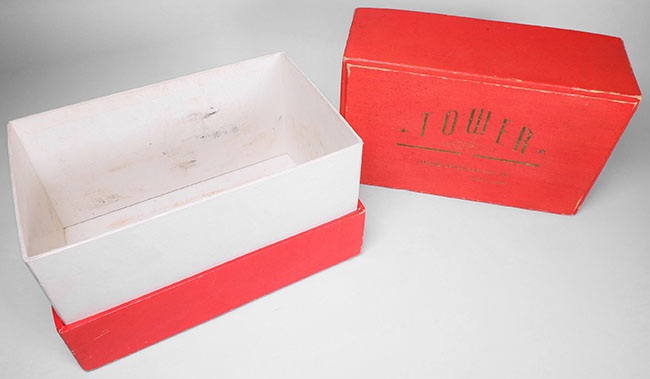
(Images courtesy of Chris Whelan)
The camera is equivalent to the early Nicca Type-III A without film plane mark and maker name “Nicca Camera Works, Ltd.”. The Nicca also featured a box with lift off lid and a separate similar box for the leather case. I don't know if there was a separate case box for the Tower:

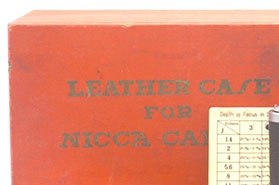 (Detail from larger web images)
(Detail from larger web images)
By the time of the later Type-III A examples with film plane mark and maker name “Nicca Camera Company, Ltd.”, the Nicca camera presentation box had become more sumptuous and featured a hinged lid with brass clasp on the front:
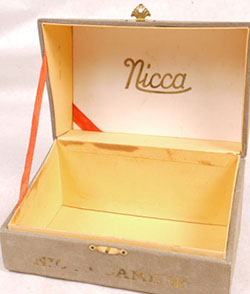 (Detail from larger web image)
(Detail from larger web image)
The colour of this one is a tan, or light brown, but some of the boxes between this one and the red versions further down were a darker brown and I'm not sure that they didn't start off more of a red, the edges which are normally protected in the closed position certainly look that way.
The one below is for a 3-S with the bare camera packed in the presentation box, the ever-ready case in a separate box with lid and both boxes delivered together in an outer cardboard carton:
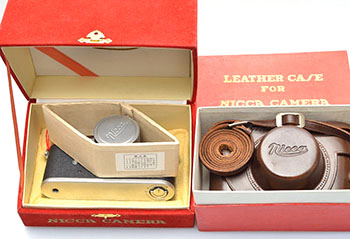
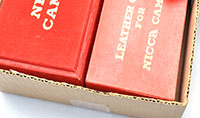
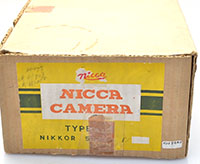
(Detail from larger web images)
Note the soft padding under the camera, that seems typical of this era. This kit was found with the Japanese combined Type-4 and 3-S user manual, Nicca guarantee document, a business card size document for the Nikkor lens from Nippon Kogaku and a couple of single page slips of some type. The only other complete kit that I have seen like this is for an early Type-5, although the camera presentation boxes are not uncommon and the case boxes also surface by themselves occasionally:
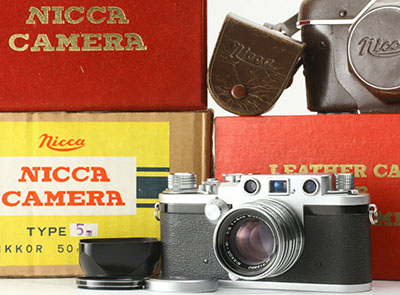 (Detail from larger web image)
(Detail from larger web image)
After this, the packaging became simpler.
The box below is a later style already. Note the nice soft lining - the camera may have been supplied fitted with its ever-ready case rather than that being supplied separately. Chris Whelan and I have been debating which camera it belongs to and the nearest agreement we have reached is that it is for either a late 3-S or a Type-5 and may have been used for both. I have only seen two Type-5s with presentation boxes, the earlyish one above and a slightly earlier one in a box like the one below. However, the box below was acquired by Chris sans camera but together with an English language Type-4/3-S user manual. Until now, boxes had been generic, this one might be too and as noted earlier, the 3-S remained in production when the Type-5 was released. To add to the confusion, I have since found two late Type-III S cameras in this type of box as well (serial numbers 5914x and 5915x):
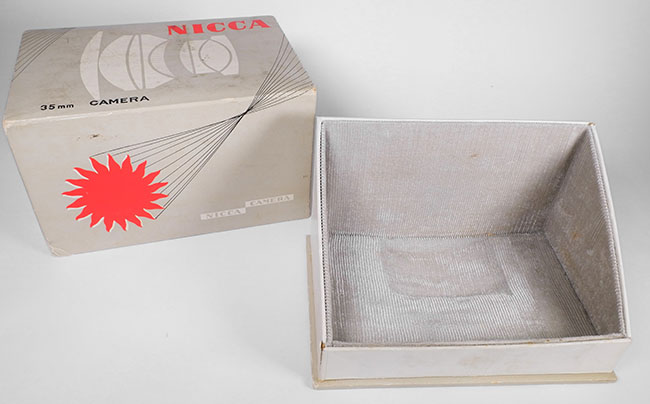
(Image courtesy of Chris Whelan)
Below left is Nicca 3-F knob wind box (last type without model name displayed but quite a few examples found with cameras and the user manual also features a yellow and black cover), middle is 3-F lever wind box and right is Type-33 box:
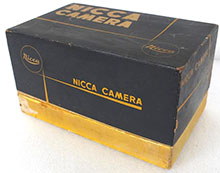
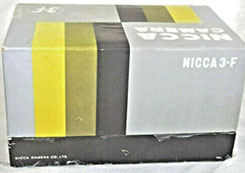
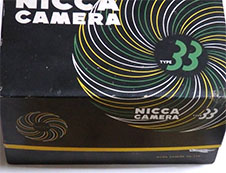
(Detail from larger web images)
Nicca III-L box:
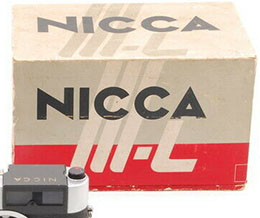 (Detail from larger web image)
(Detail from larger web image)
Useful Links
Links to references and resources are incorporated in the relevant parts of the page. These two links are a little different:
Mike Eckman's article on the Tower 45 is much more than that. It provides a solid background for the birth and development of the precision camera industry in Japan, starting from near the end of World War I, and Nicca's role in it including it's milestones and fortunes until its demise. Then there is the Tower 45 itself, the Tower ecosystem, the Nicca relatives and the nature of the Leica-like experience and whether the Nicca “improvements” are meaningful or not: https://mikeeckman.com/2020/08/tower-45-1957/. Plus there are also a number of Yashica articles relevant to this site, Leica articles relevant to this page and many more.
Chris Whelan's blog site covers all sorts of stuff but much of it is related to photographic gear. His photos, instruction manuals, brochures and contributions appear all over this site. His interest in Yashica Pentamatics infected me and eventually lead to this page. In the process, he has become a Nicca fan and actively shoots a 3-S and has recently acquired a Type-5 and a Yashica YF to add to his YE. He has owned other models including early Towers. Hardly a day goes by where we don't chat about something, usually a camera. If you browse his archives, you're bound to find some interesting camera porn of one kind or another: https://yashicasailorboy.com/
Contact Details
My name is Paul Sokk and I can be contacted by email at paulsokk@live.com.au.
.jpg)
.jpg)
.jpg)
.jpg)
.jpg)
.jpg)
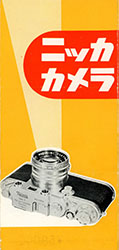
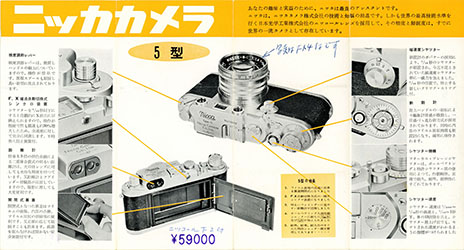


.jpg)
.jpg)
